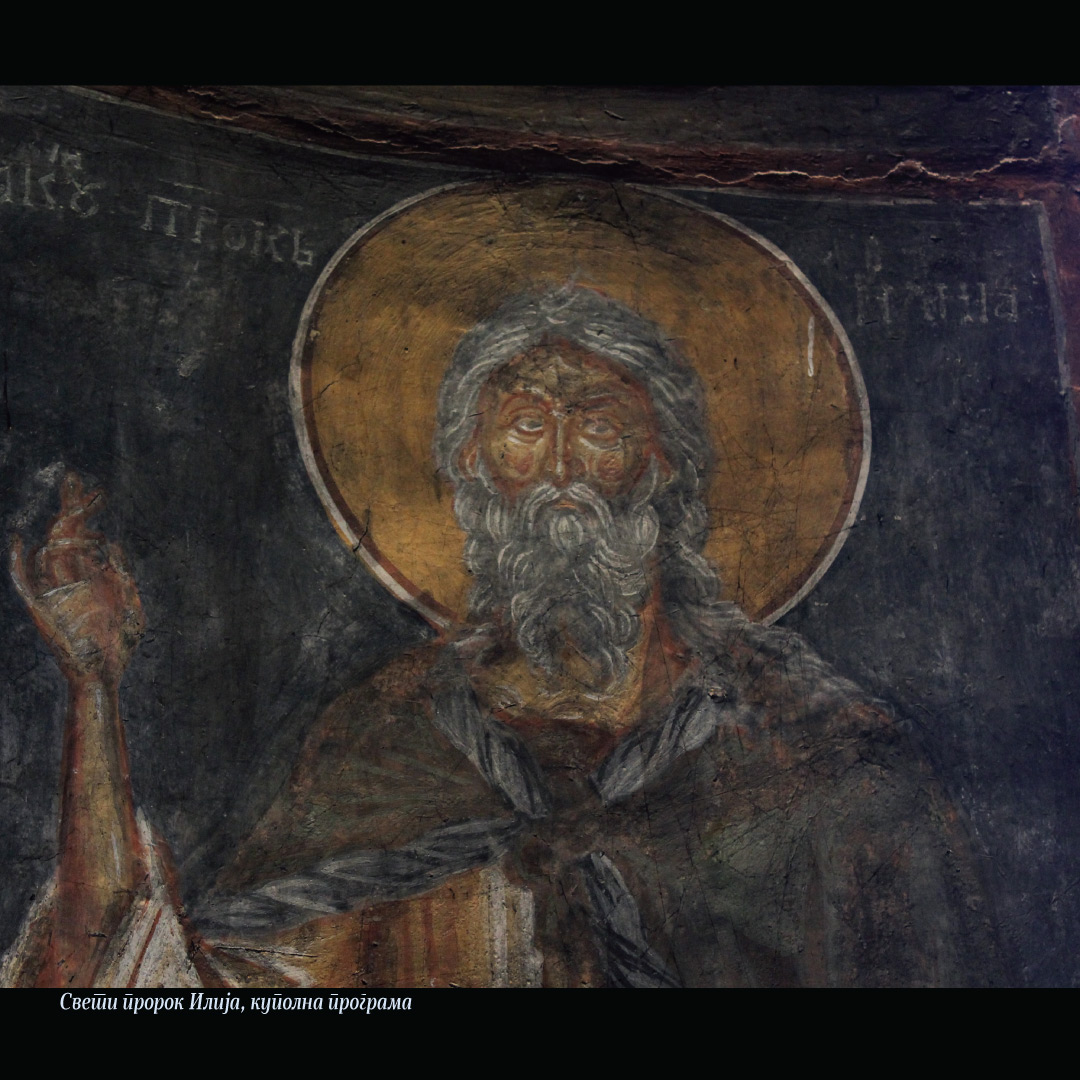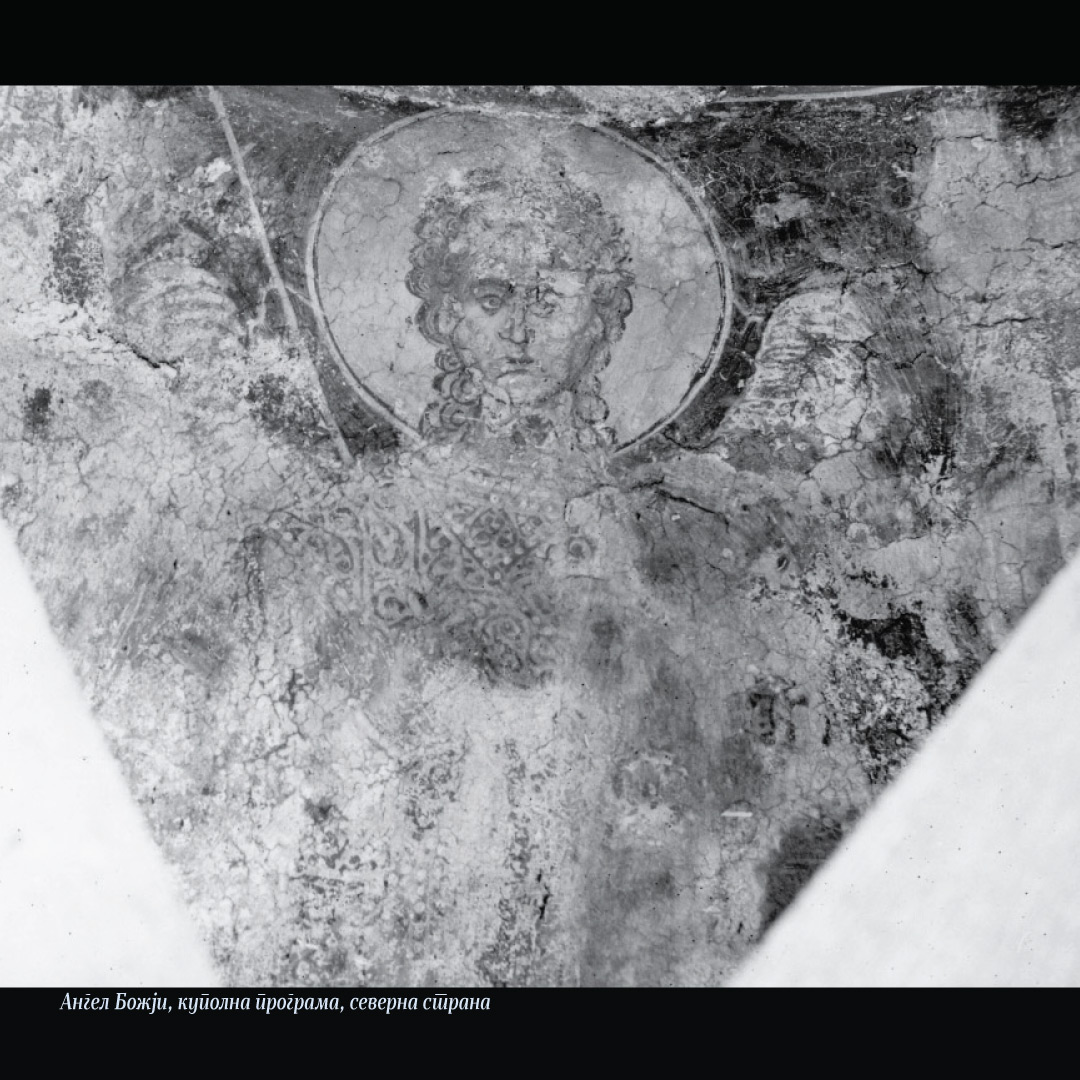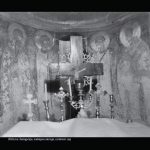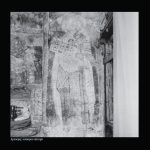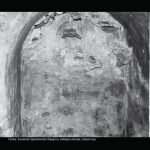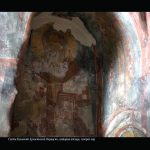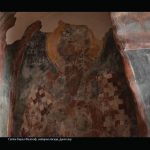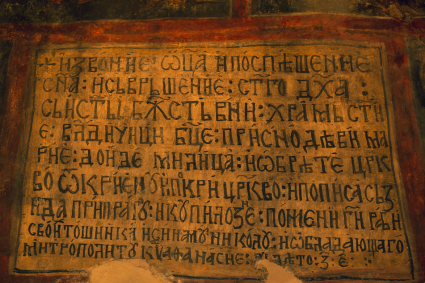The frescoes in the monastery Matka belong to Ohrid painting school of the late 15th century. Here, for the first time were found frescoes from that school, adapted in the space of a compact type cruciform. The dark burgundy colour dominates the atmosphere, broken with the light chromium oxide green, ocher (pale yellow), olive green and grey.
The painting program was passed on to us completely, by m-r Jehona Spahiu. We are very grateful for her generosity and knowledge.
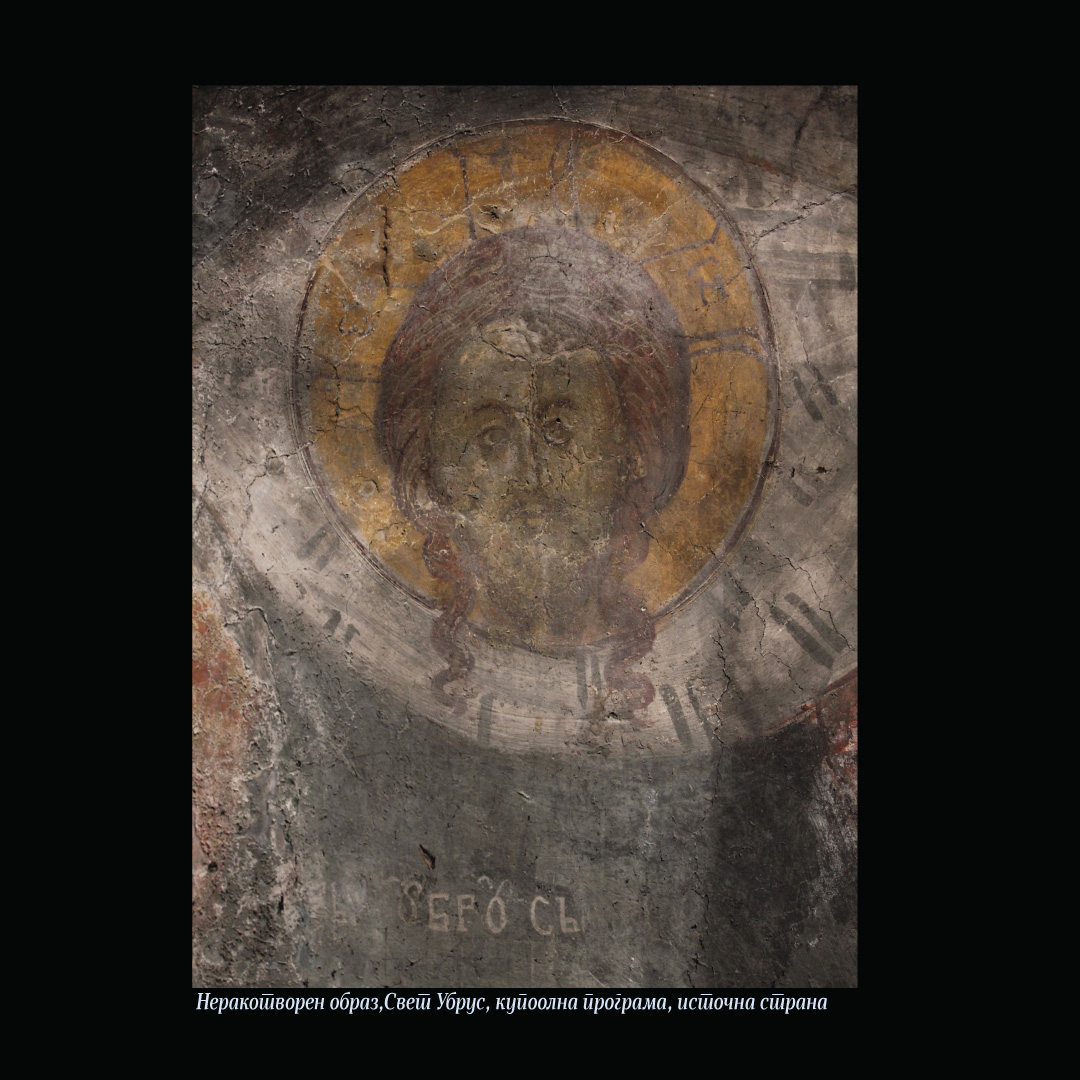
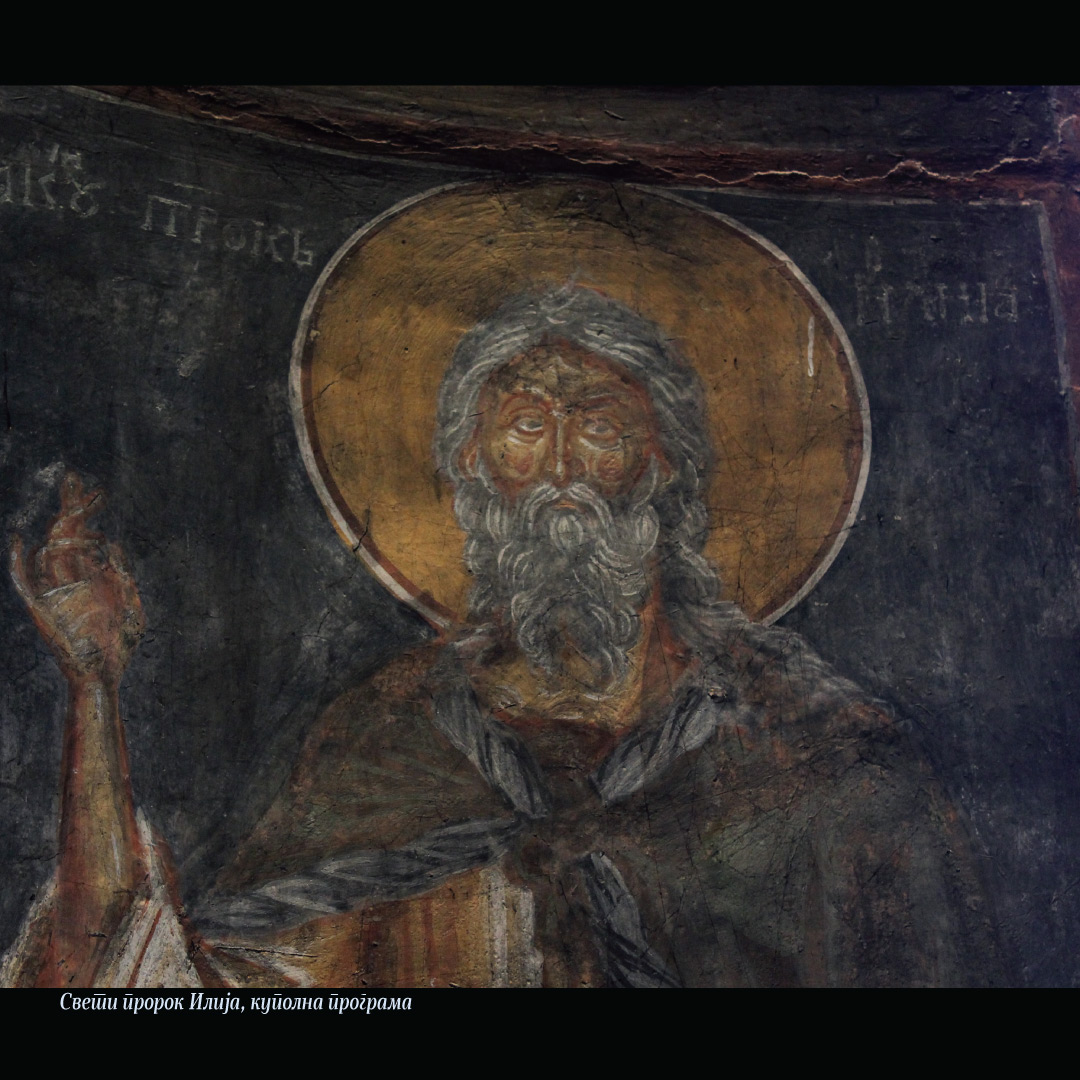
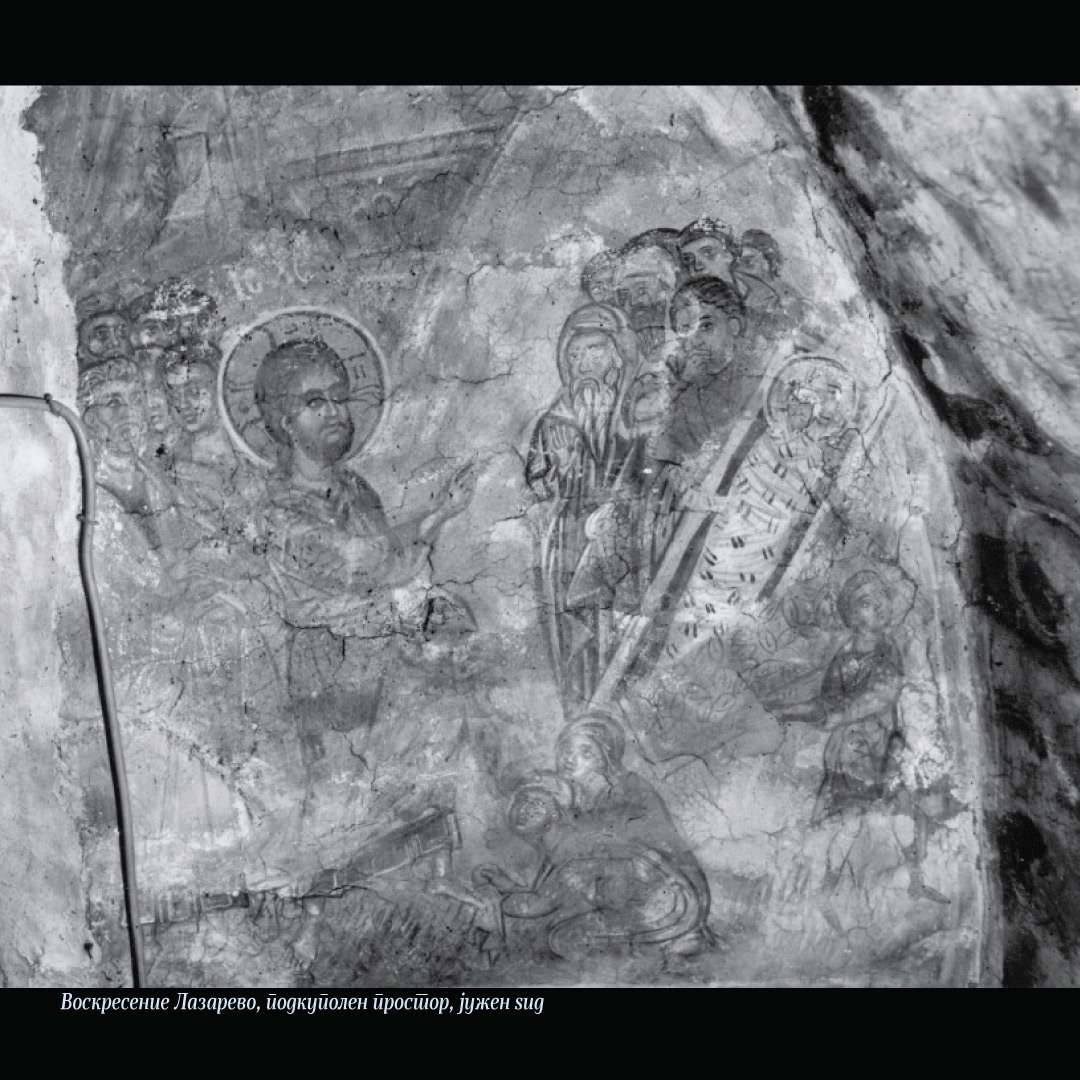
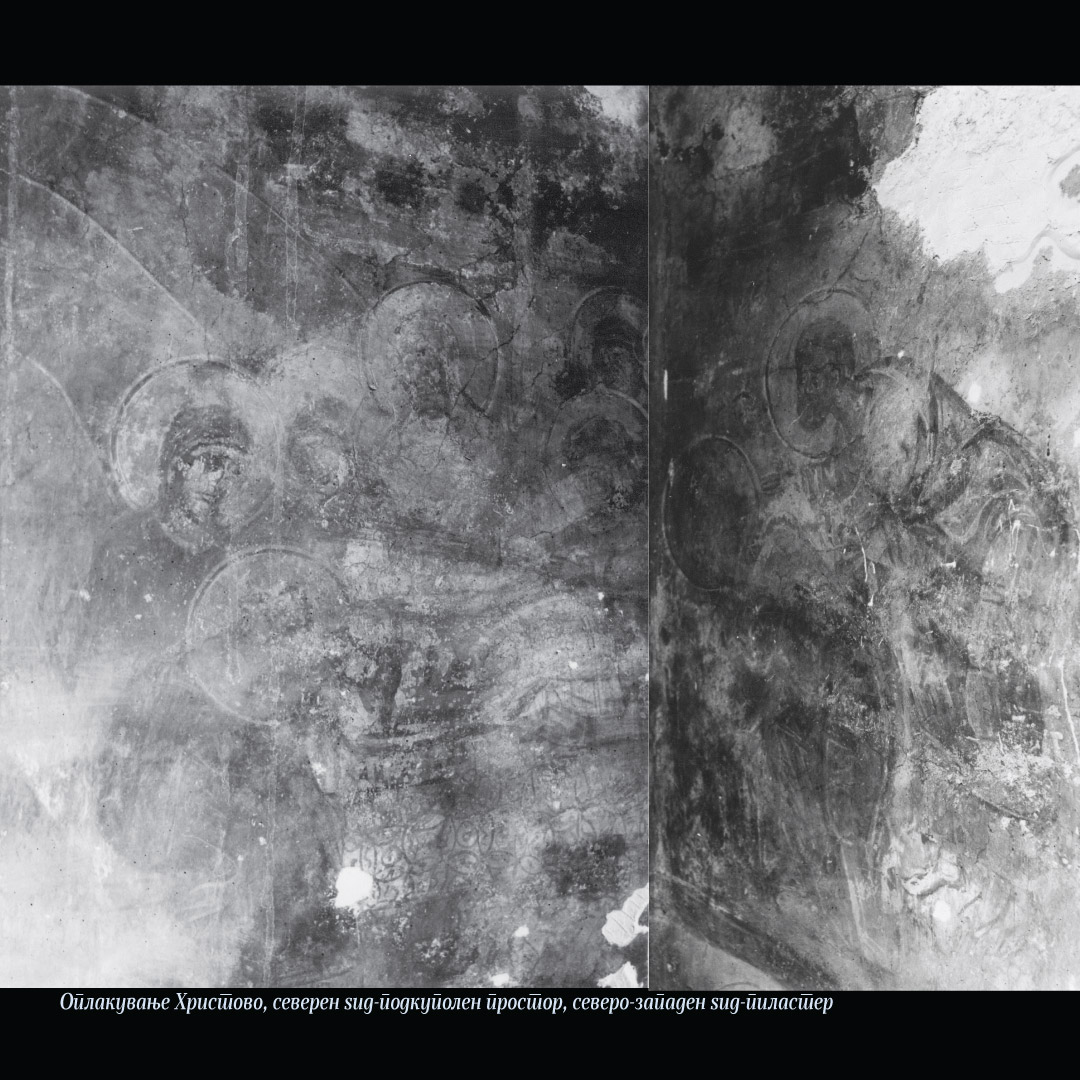
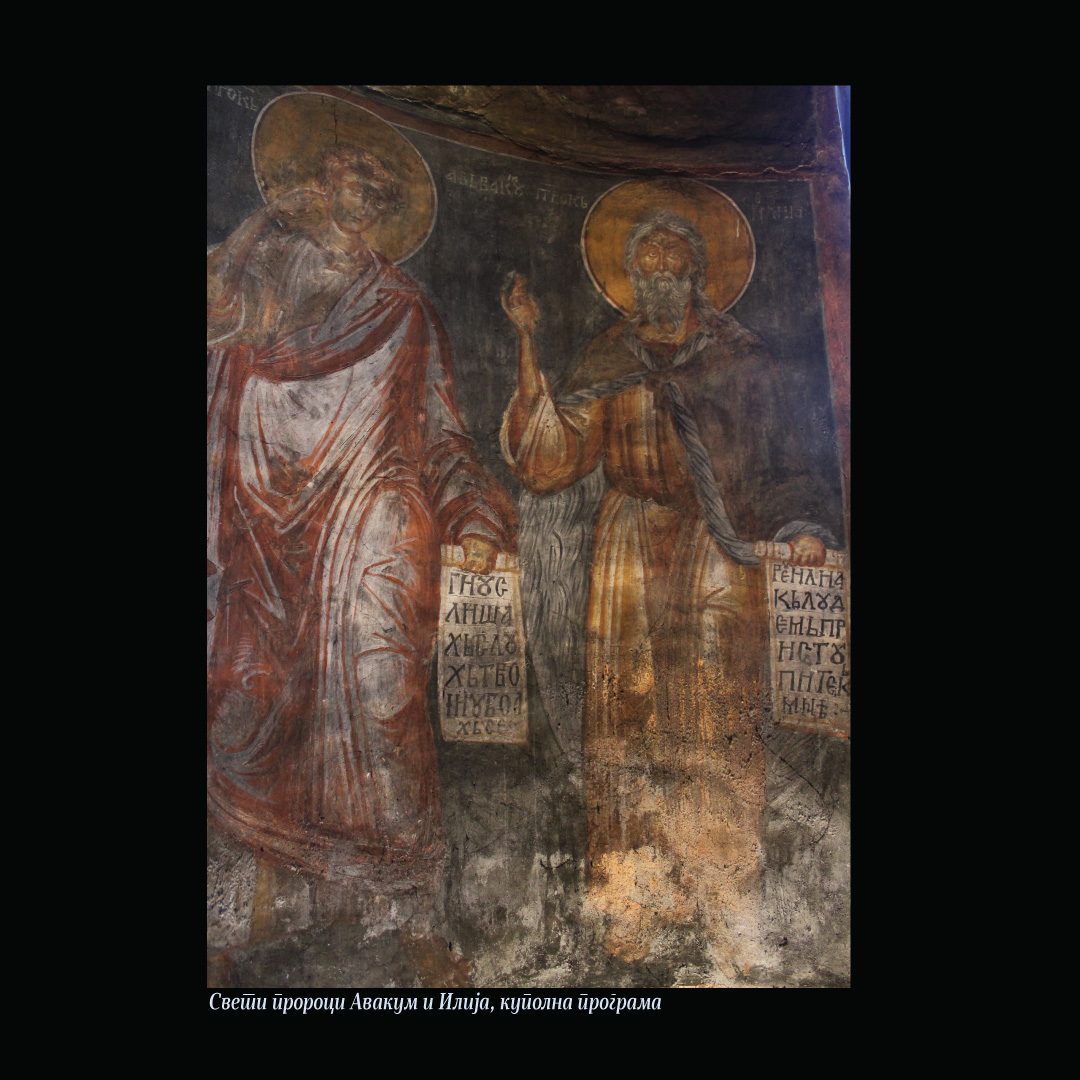
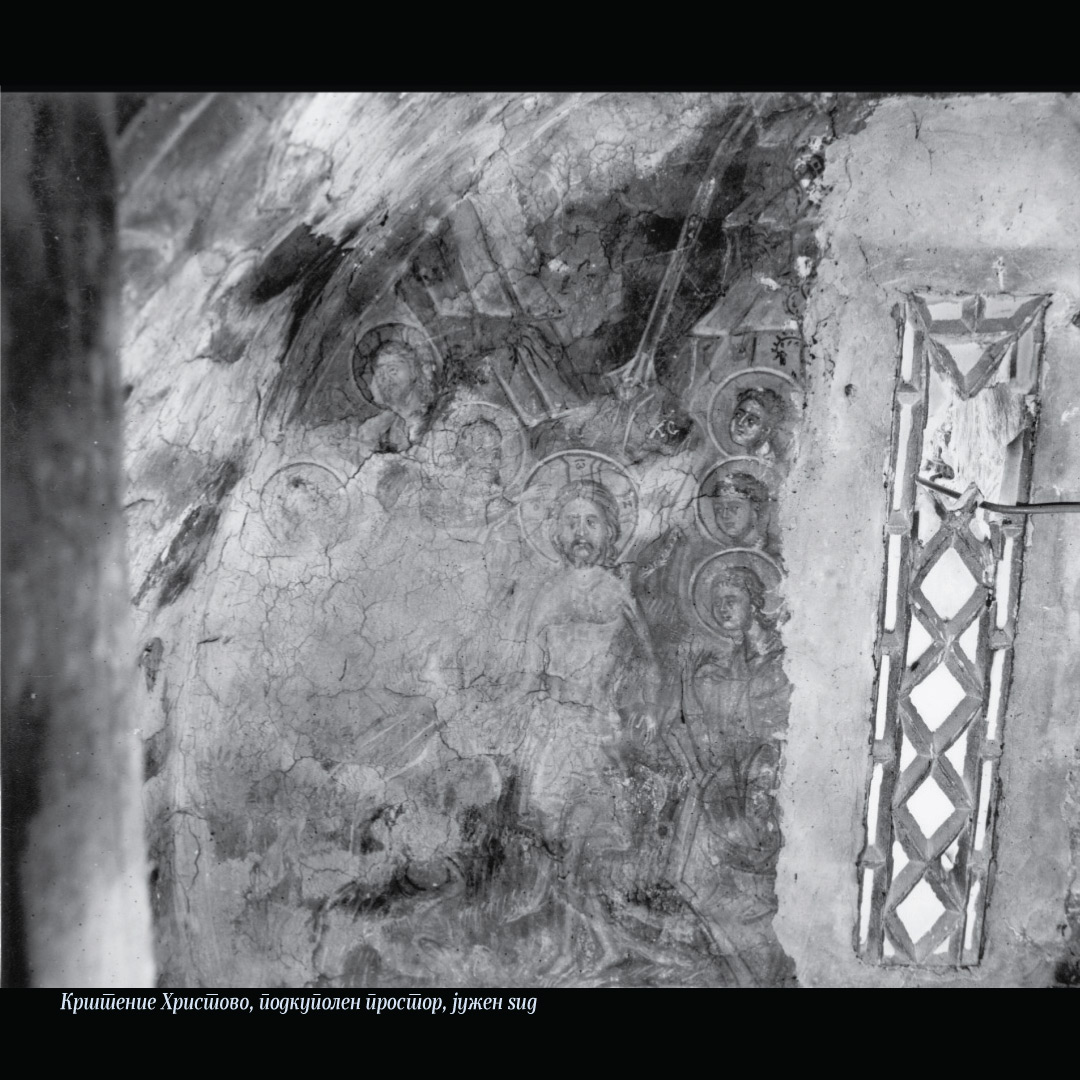
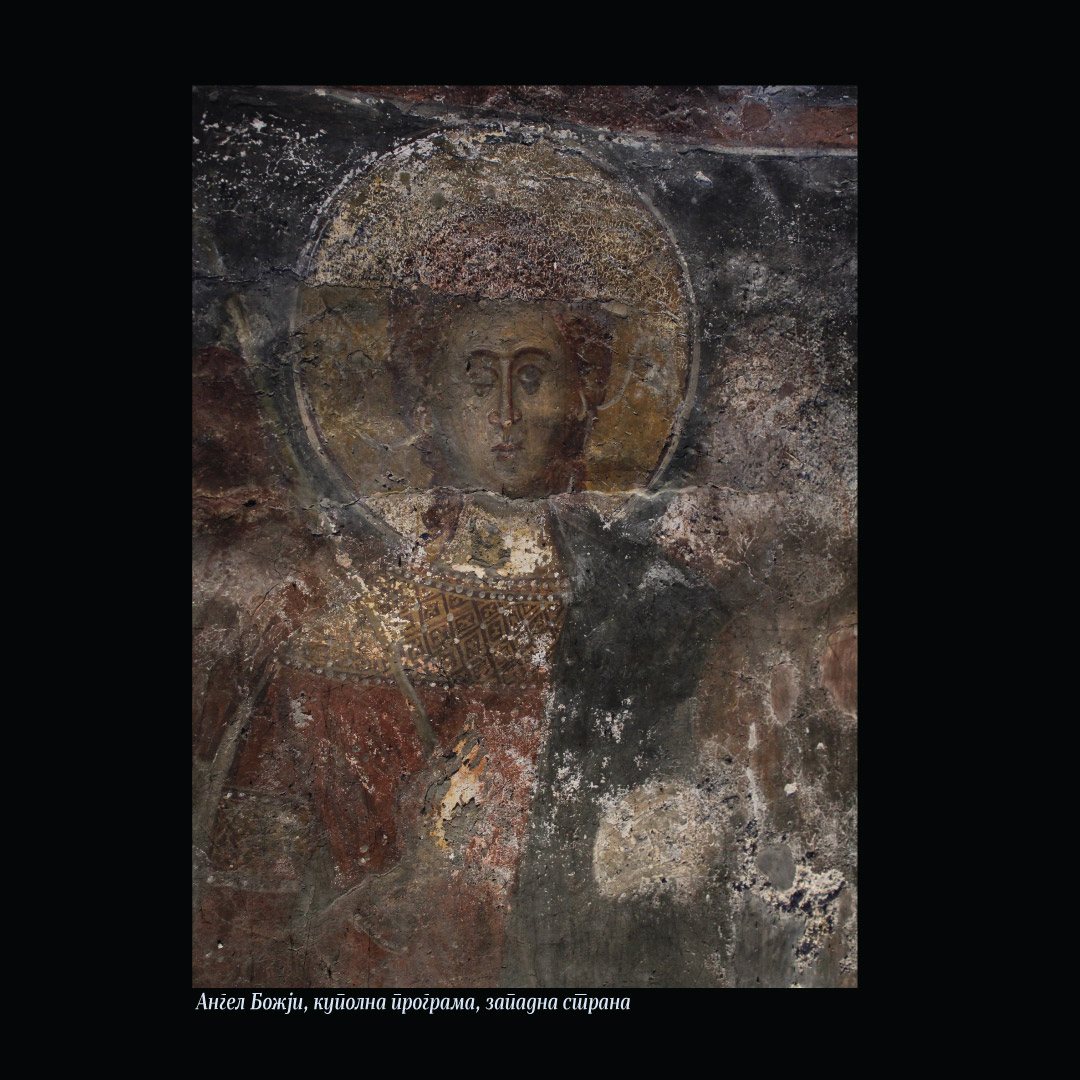

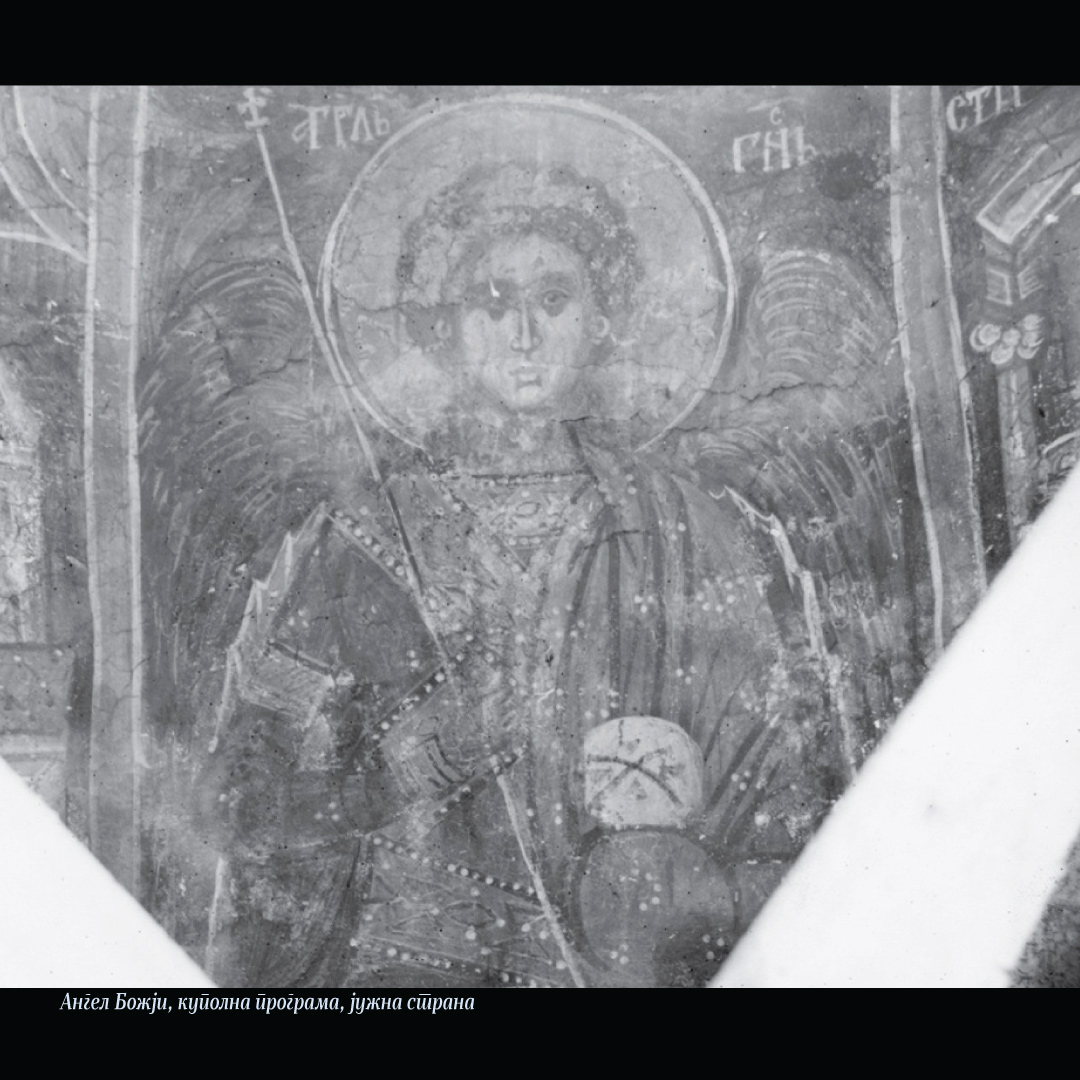
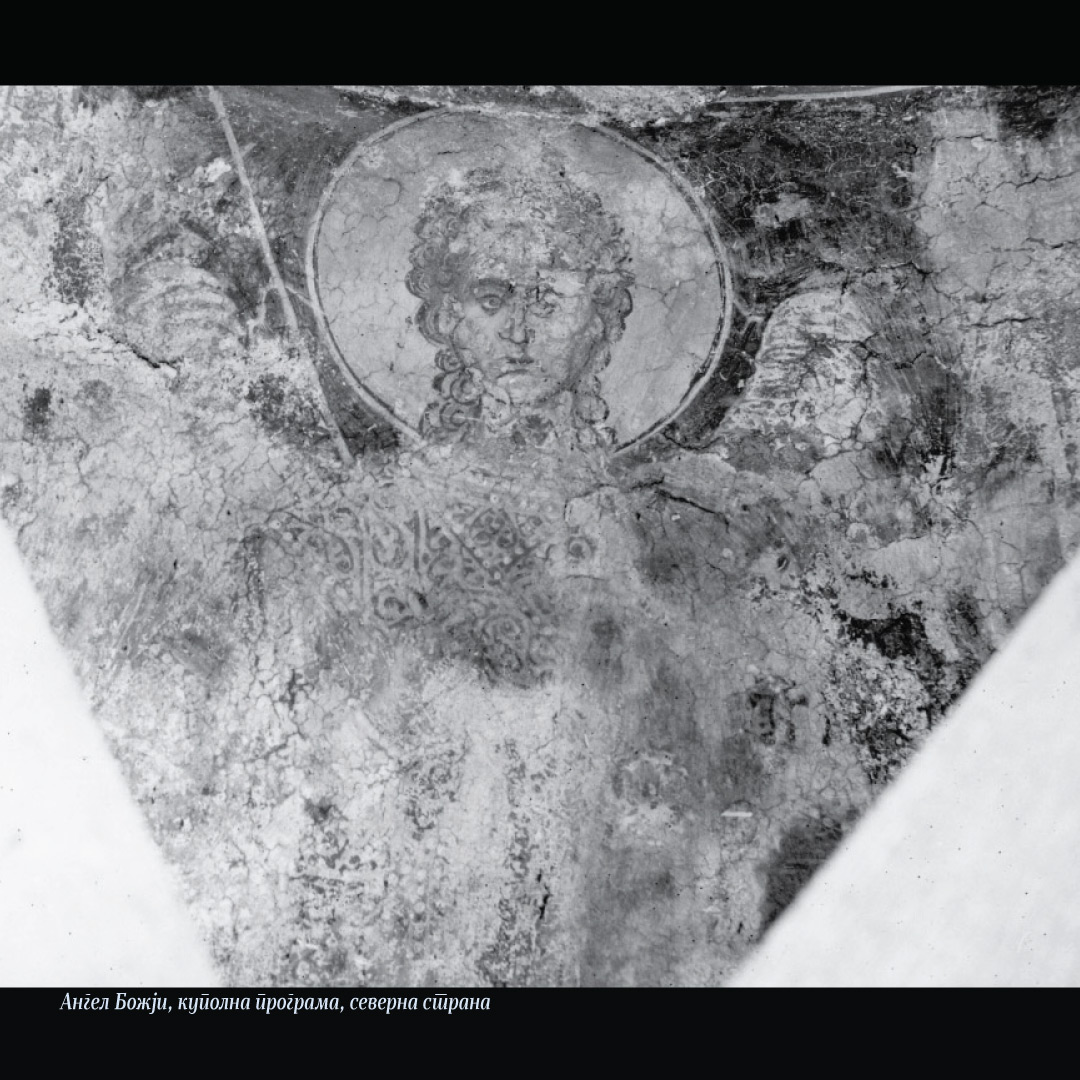
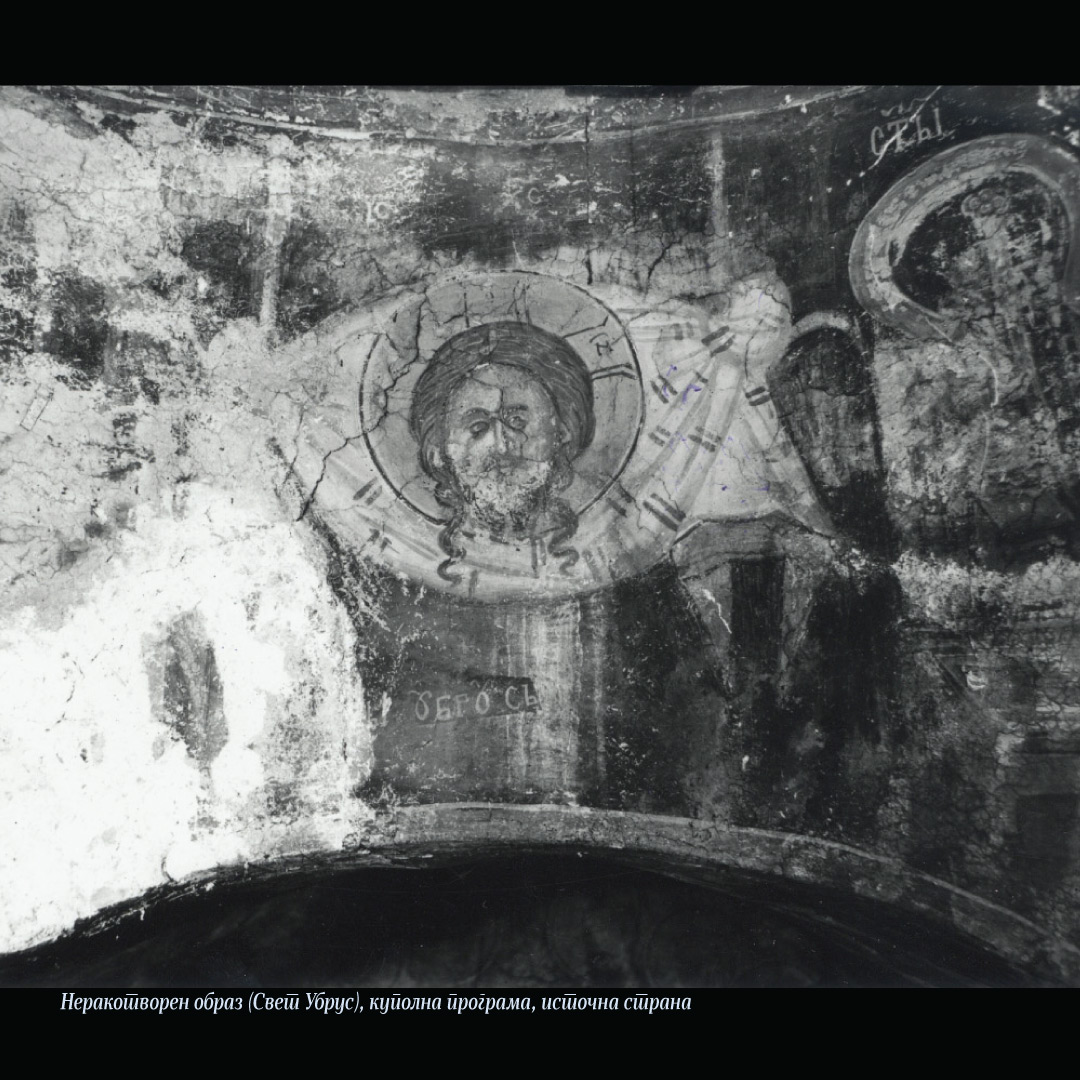
The Dome program
The presentation of Jesus Christ – Pantocrator, which today is completely destroyed, was probably located in the crown of the dome. Around that presentation is the scene of the Divine / Heavenly Liturgy, and on the drum, between the windows, are screens depicting prophets, two by two, for a total of eight. The four pendentives each depict one evangelist, the sections between the pandantifite bear painted angels, and on the east side is the Holy Scarf (Ubrus). In the crown of the eastern arch (above the altar space) is the Ascension of Christ, while on the west ceiling is the Prepared throne / Hetimasija.
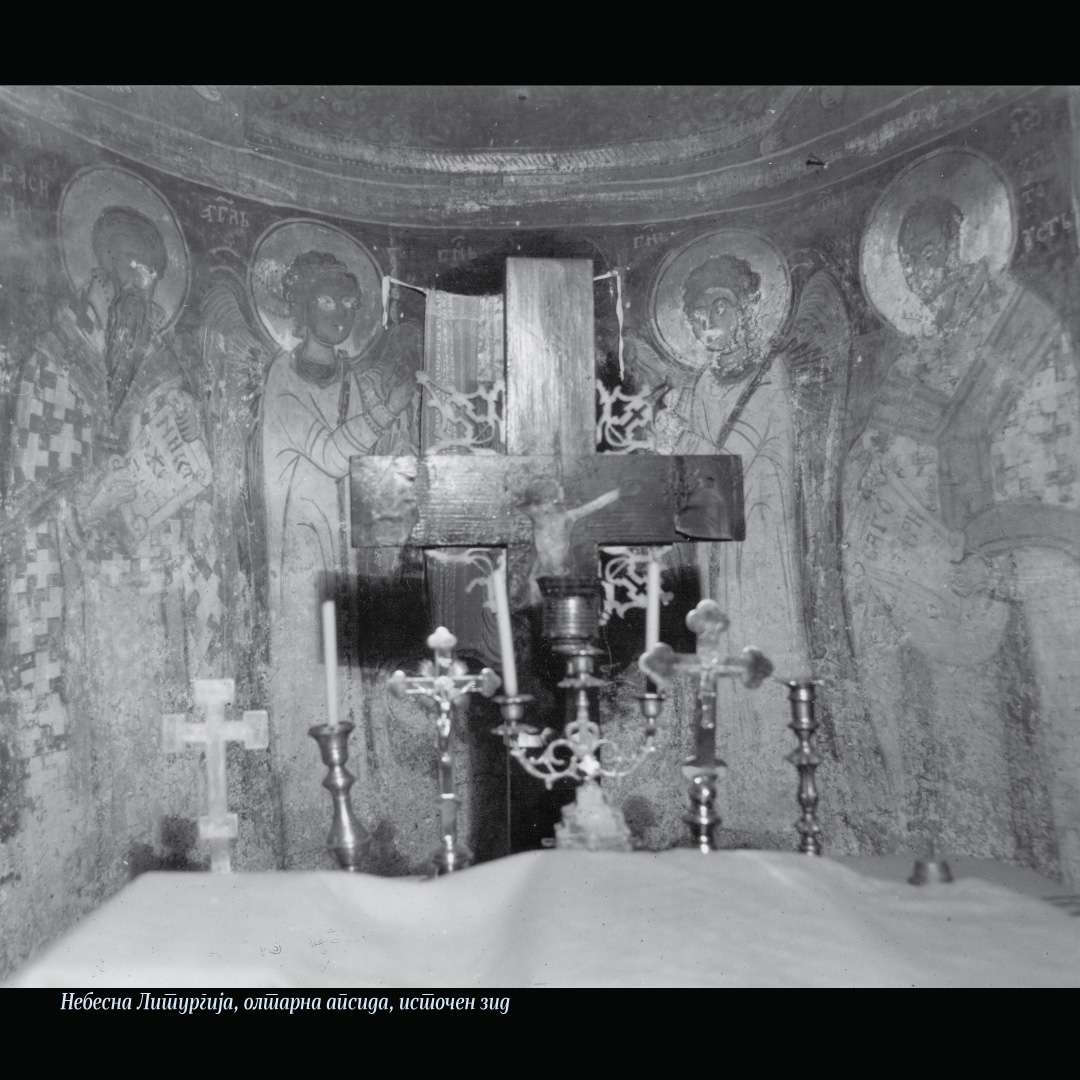
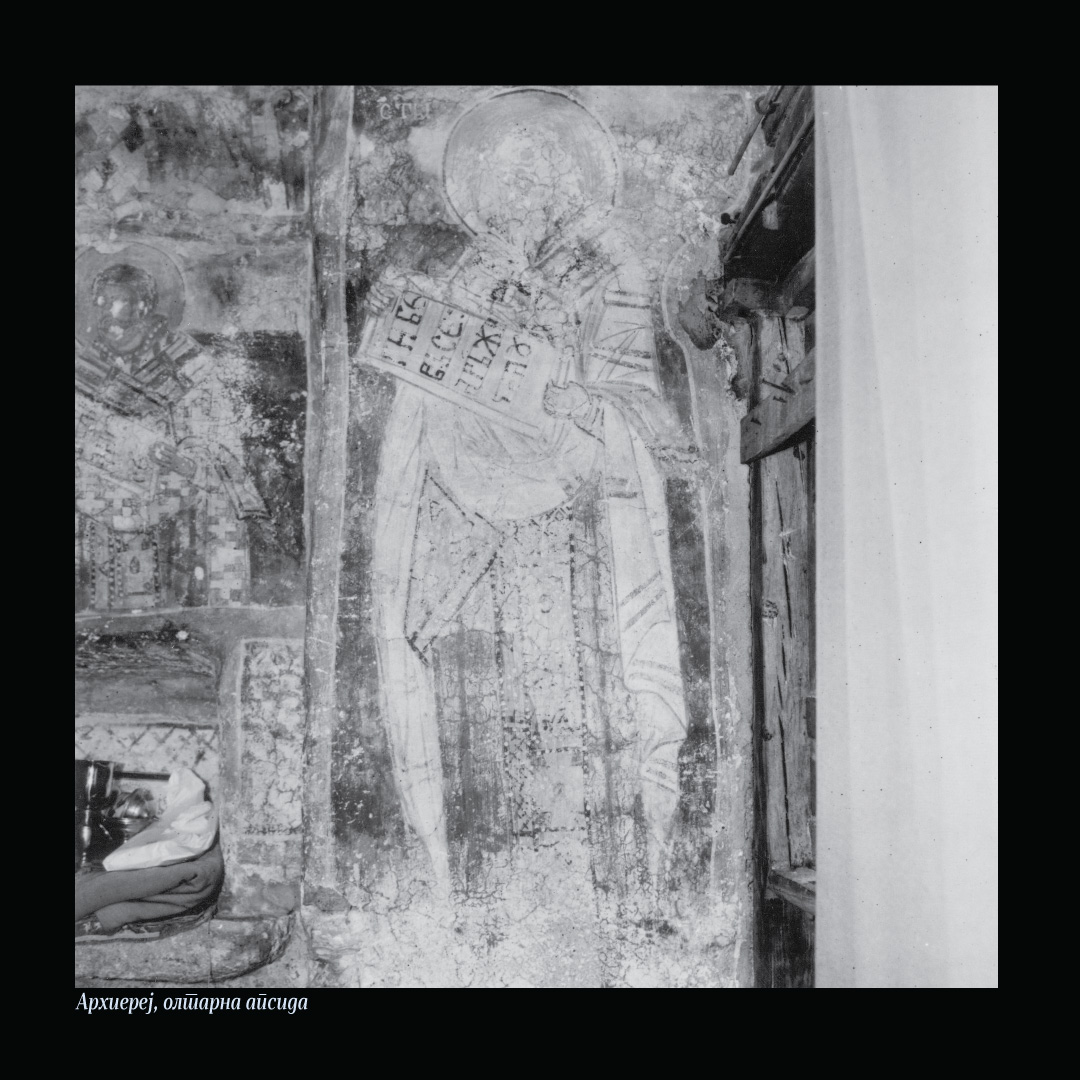
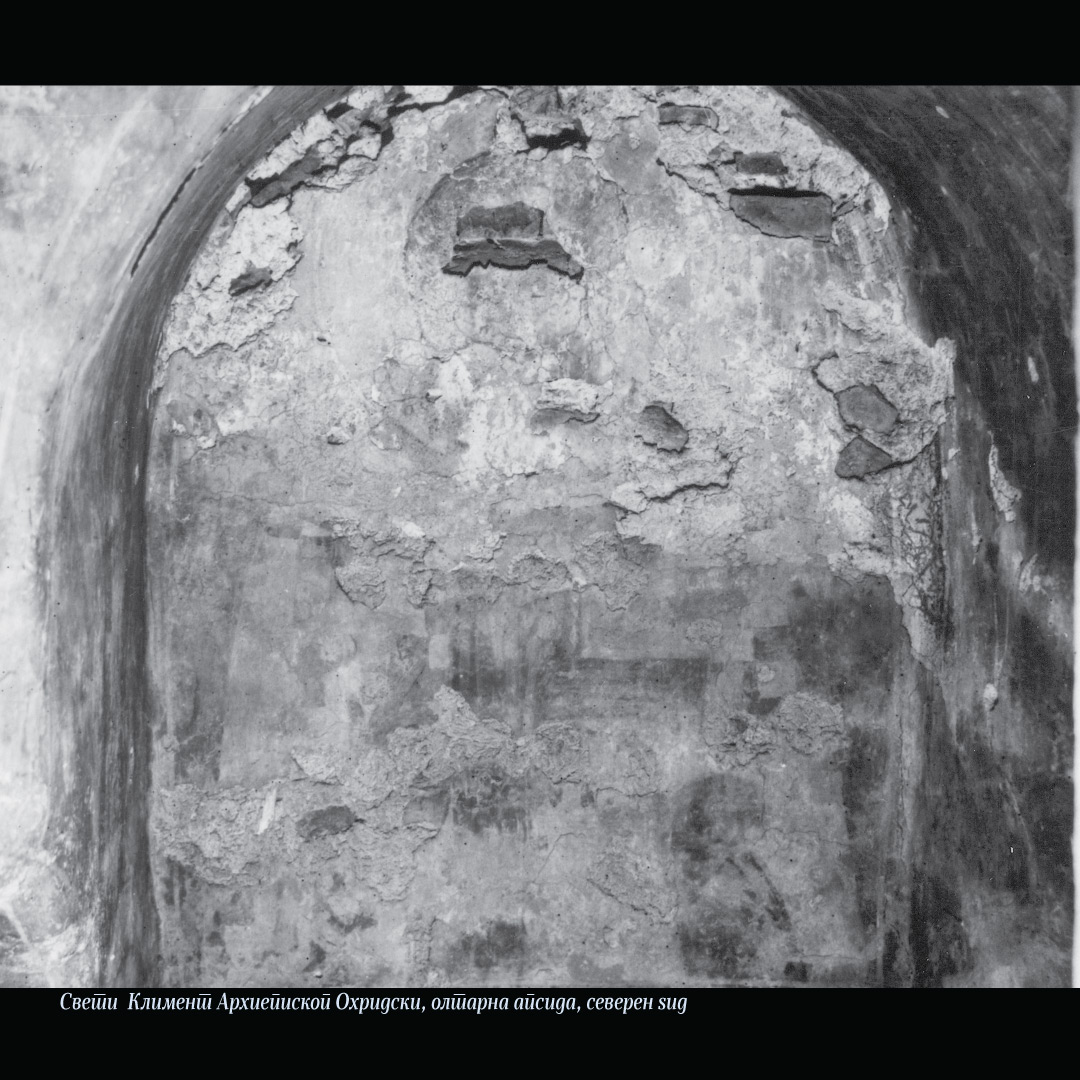
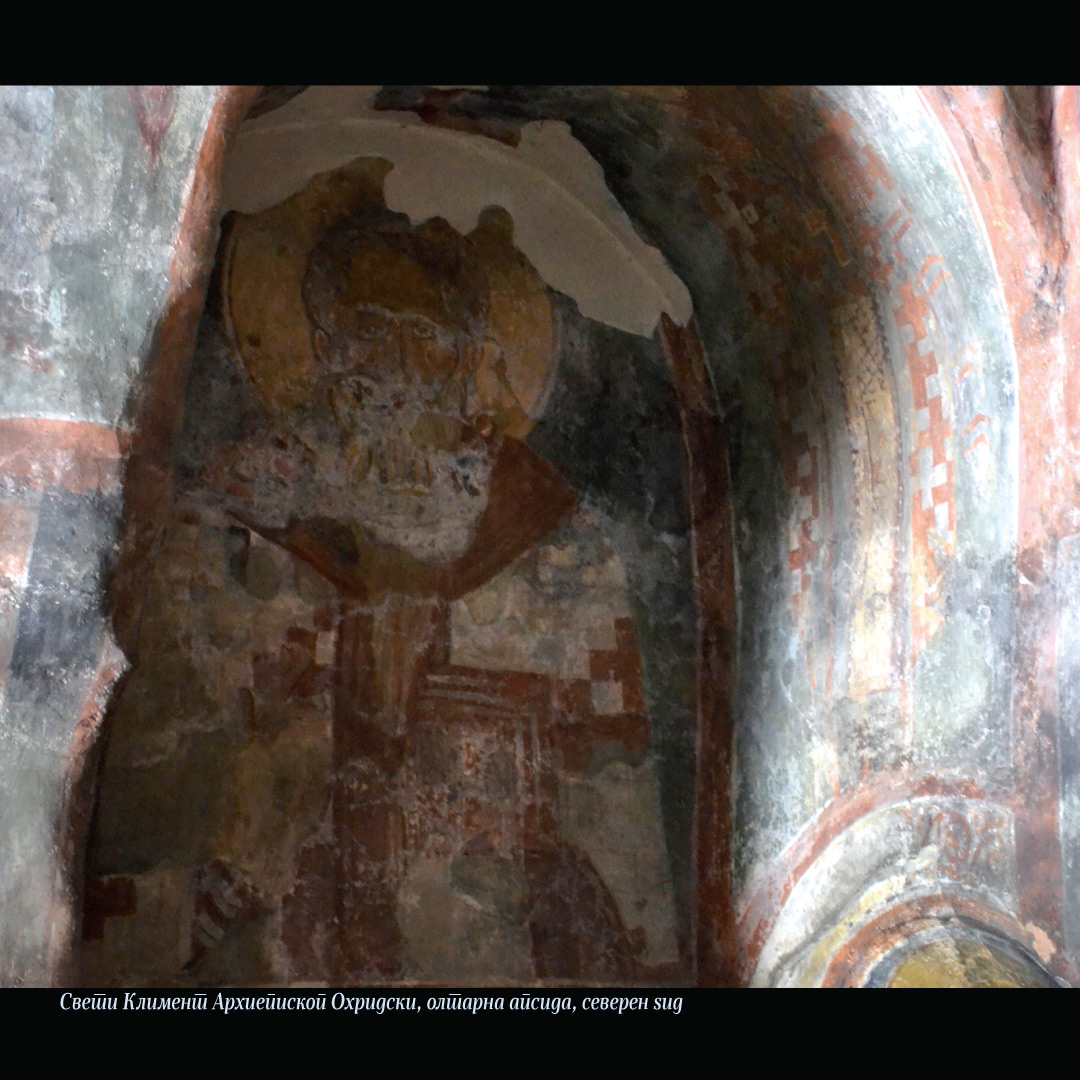
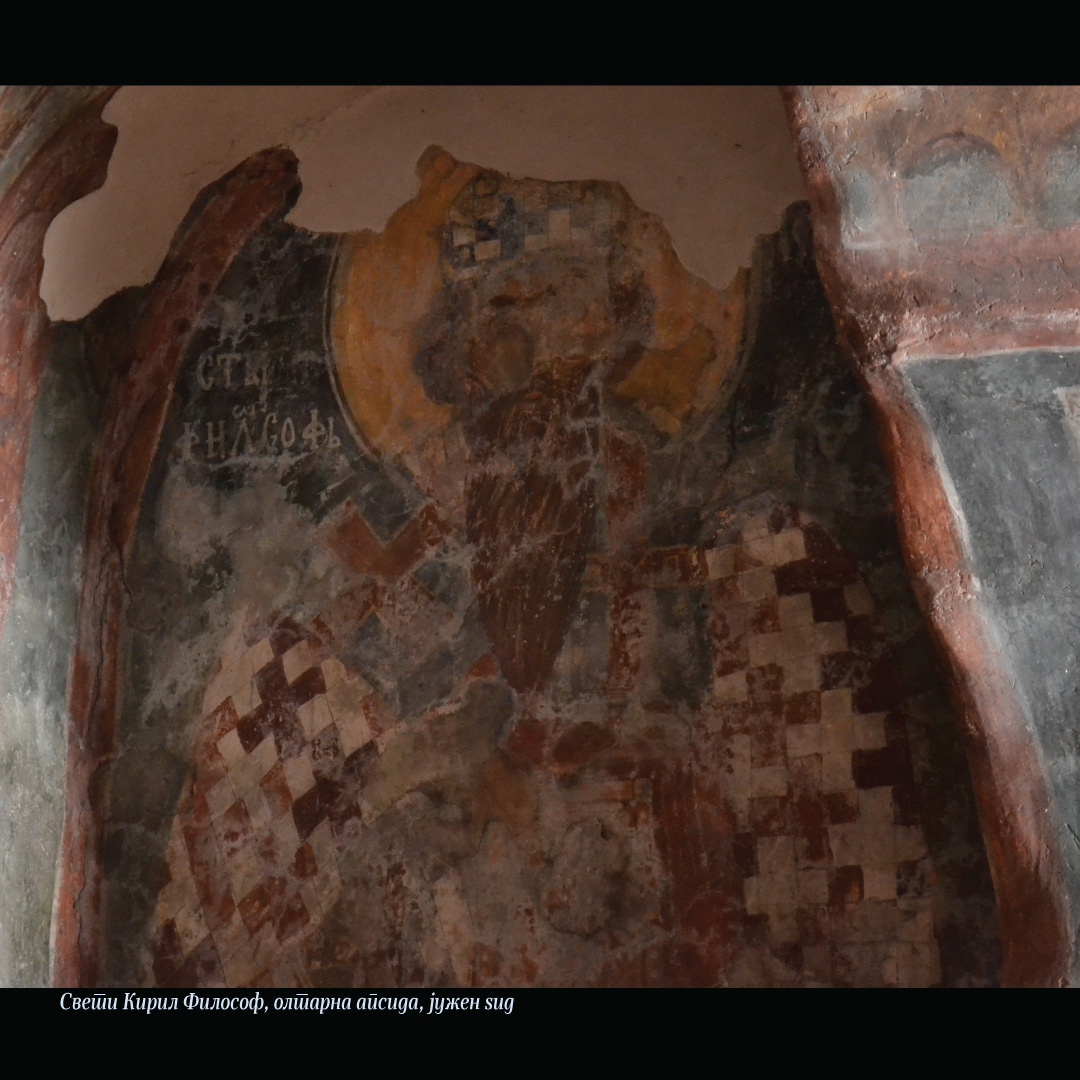
The Altar area
In crown of the conch, is depicted the Virgin with the Infant Christ, presented in a floral cup, beneath which, is the Communion of the Apostles. In the first zone is a Liturgical service of the bishops and Christ-the Lamb (sacrifice) with St Basil the Great and St John Chrysostom. In the narrow painted ribbons, on the left and right of the conch is painted the Archangel Gabriel and the Virgin of the Annunciation. Under their performances are shown the holy stylites St Simeon and St Daniel. In the niche of the anaphora, is shown St. Archdeacon Stephen, and in the deaconicon area is shown St Roman Melod. In the niche on the south wall depicts St. Cyril the Philosopher, and on the opposite (north) wall is shown his disciple, St Clement of Ohrid. Beneath the from-the-waist-up representation of St. Clement, is presented the vision of Saint Peter of Alexandria.
The St Clement character – Is portrayed as a bishop with a polistavrion (liturgical vestment cloak) and omophorion (a vestment worn around the neck, representing the lost sheep that is found by the Good Shepherd) with crosses. He is presented a having a high forehead, a small rounded fringe, protruding cheeks, and a long, thick, greying beard. In his left hand he is holding a closed Gospel, while giving a blessing with his right hand. His teacher St. Cyril the Philosopher, is depicted wearing a cap decorated with crosses. The painter of the portrait of St Clement of Ohrid certainly belonged to the painting studio that used to work at the archiepiscopal town, and knew the basic features of his physiognomy. This again speaks to the fact that the stylistic features used by the artisans in the frescoes in Matka, only confirm their origin from the city Ohrid. The portrait of St Clement of Ohrid is one of the rare presentations saved in the area of the city Skopje, together with those at the chrch St. Andrew and Markov monastery, which increases its importance. St Clement of Ohrid portrait is ever present in the other churches in Macedonia. It is also in the churches of St. Sophia, Kaneo, Perivlepta, etc.
In the top section, left and right of the window are two scenes from the life of Mother Mary: the Nativity and the Presentation in the Temple. On the shallow pilasters is shown the Annunciation, of which today only the figure of the Virgin on the south side remains. Below are some faded figures, probably holy warriors. On the left and right of the door are shown the holy Apostles Peter and Paul, while above the door are the both hands of God, one of them offering a scroll, and the other a Gospel, towards the apostles.
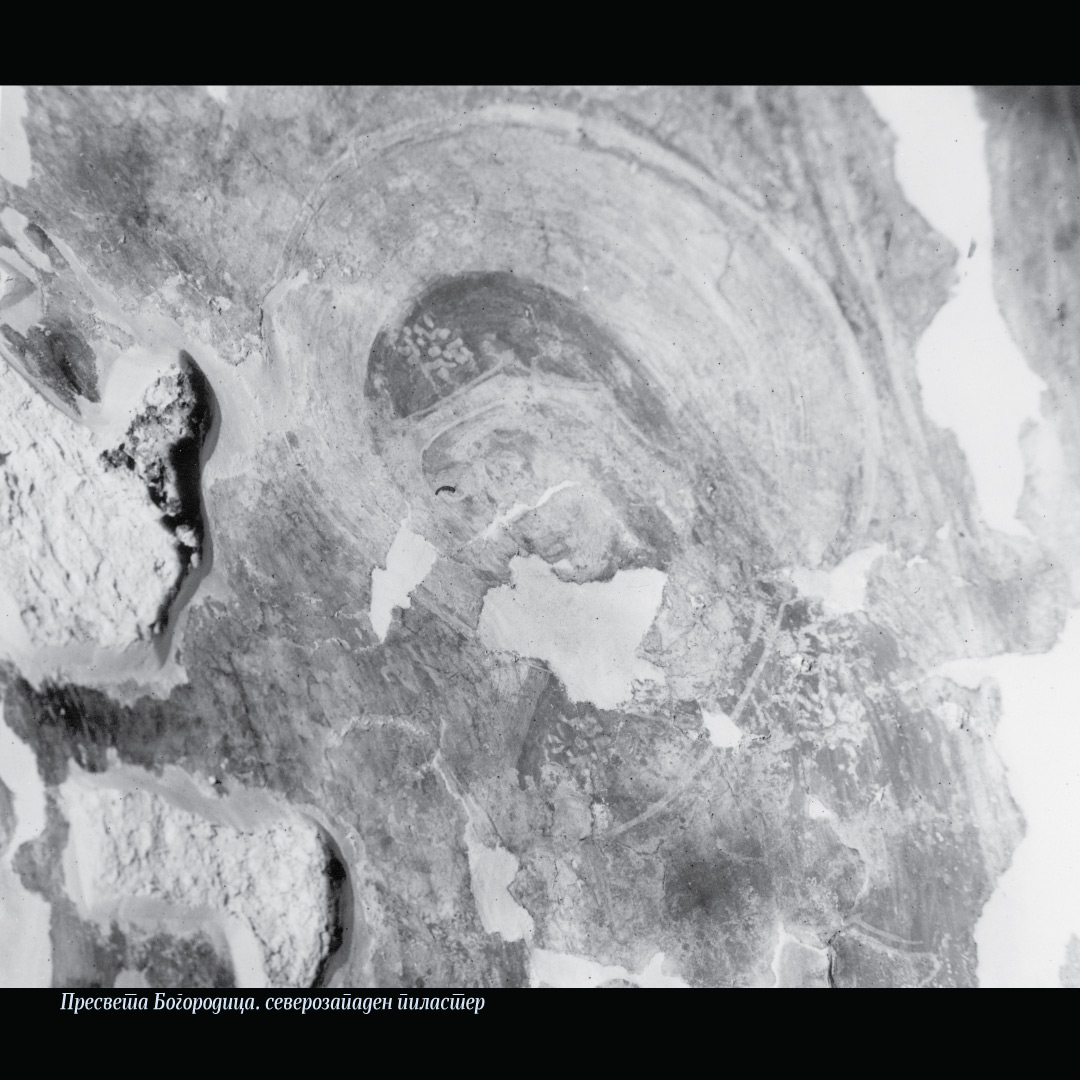
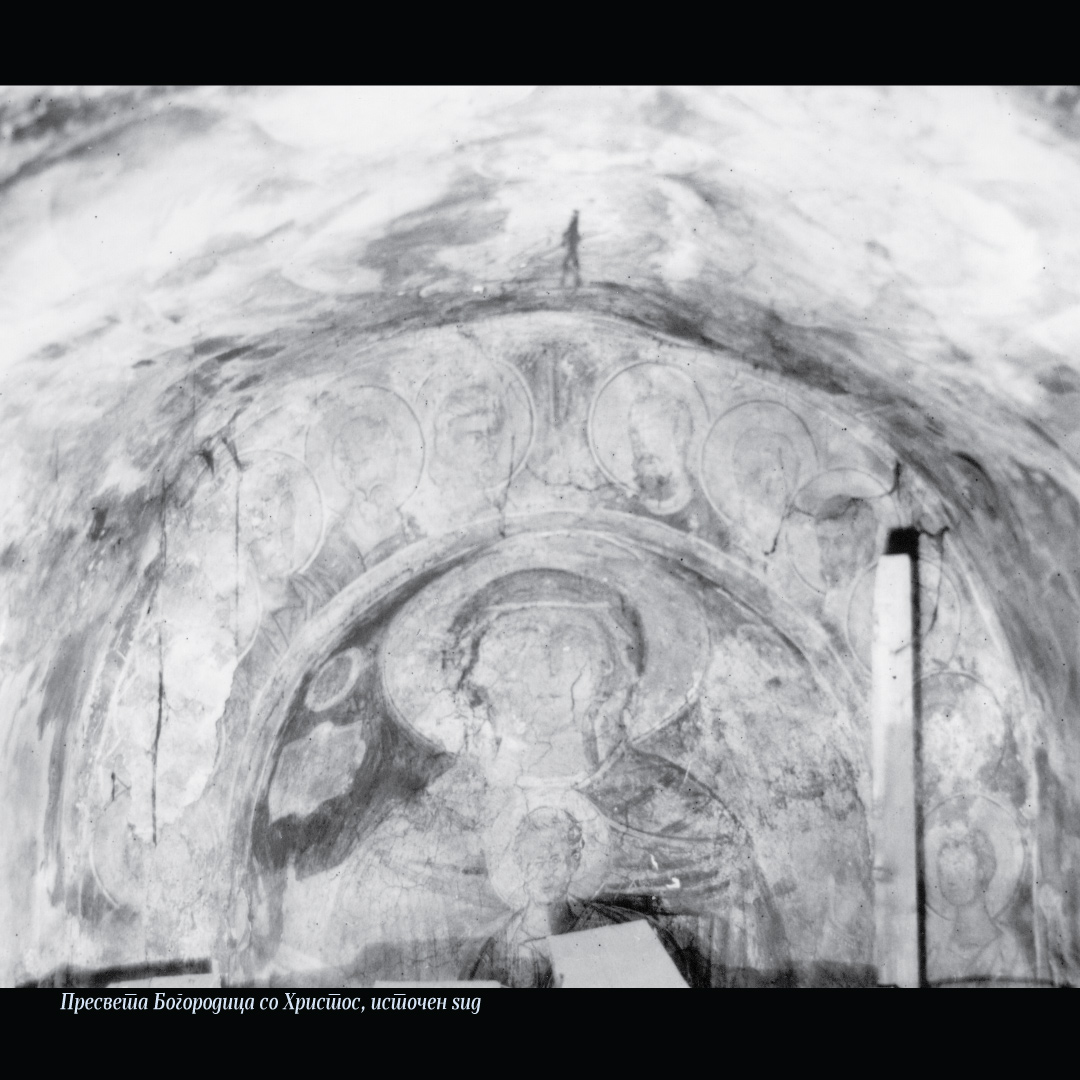
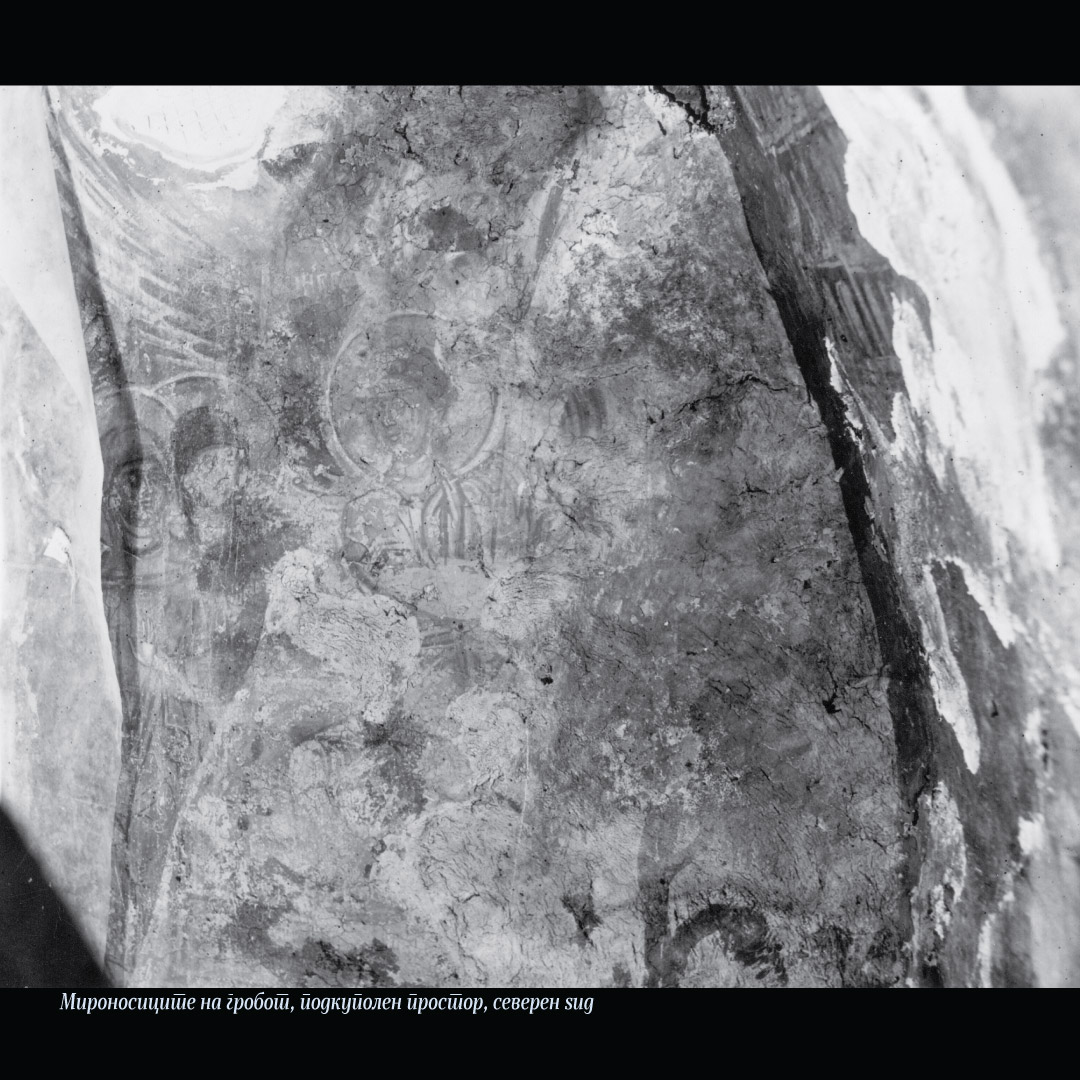
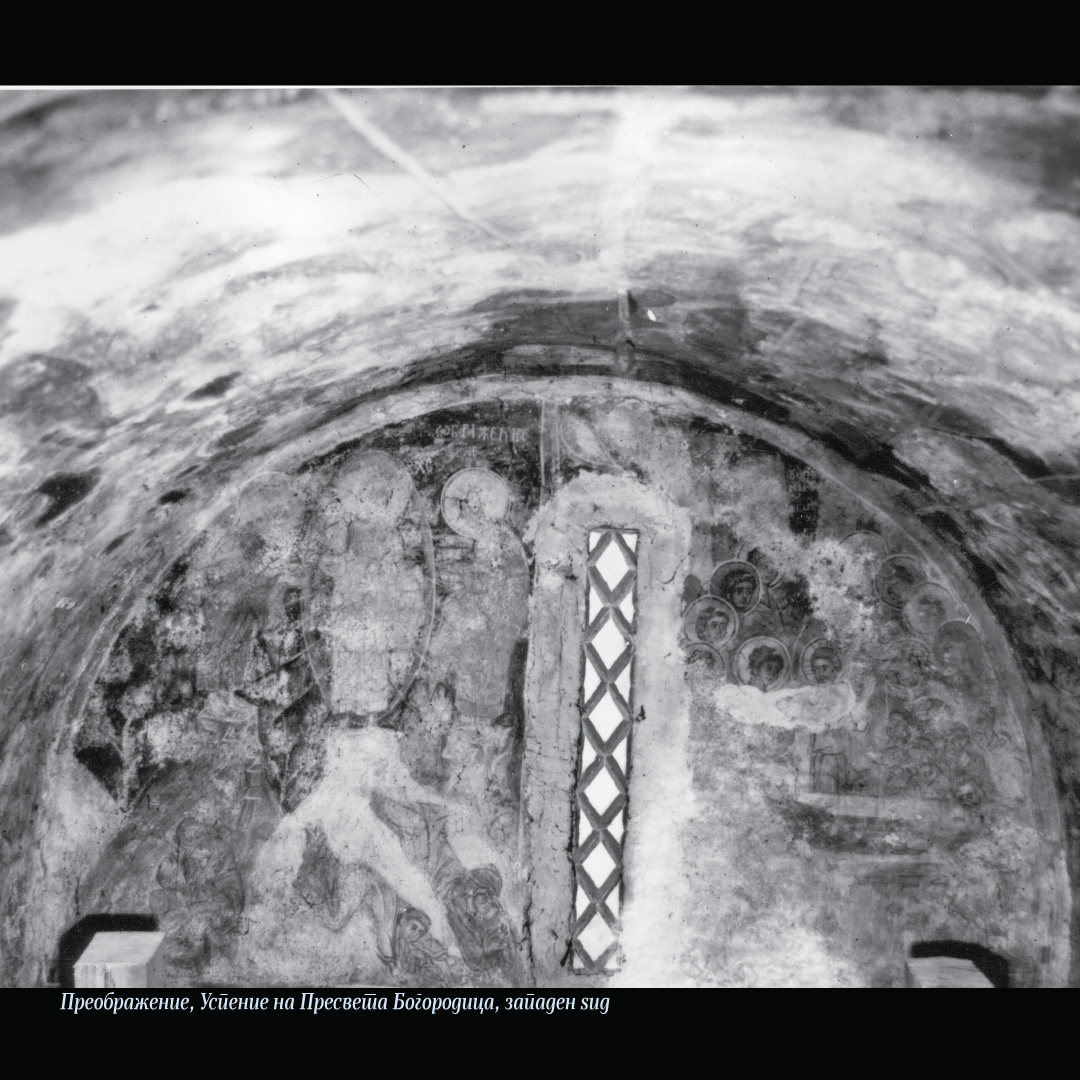

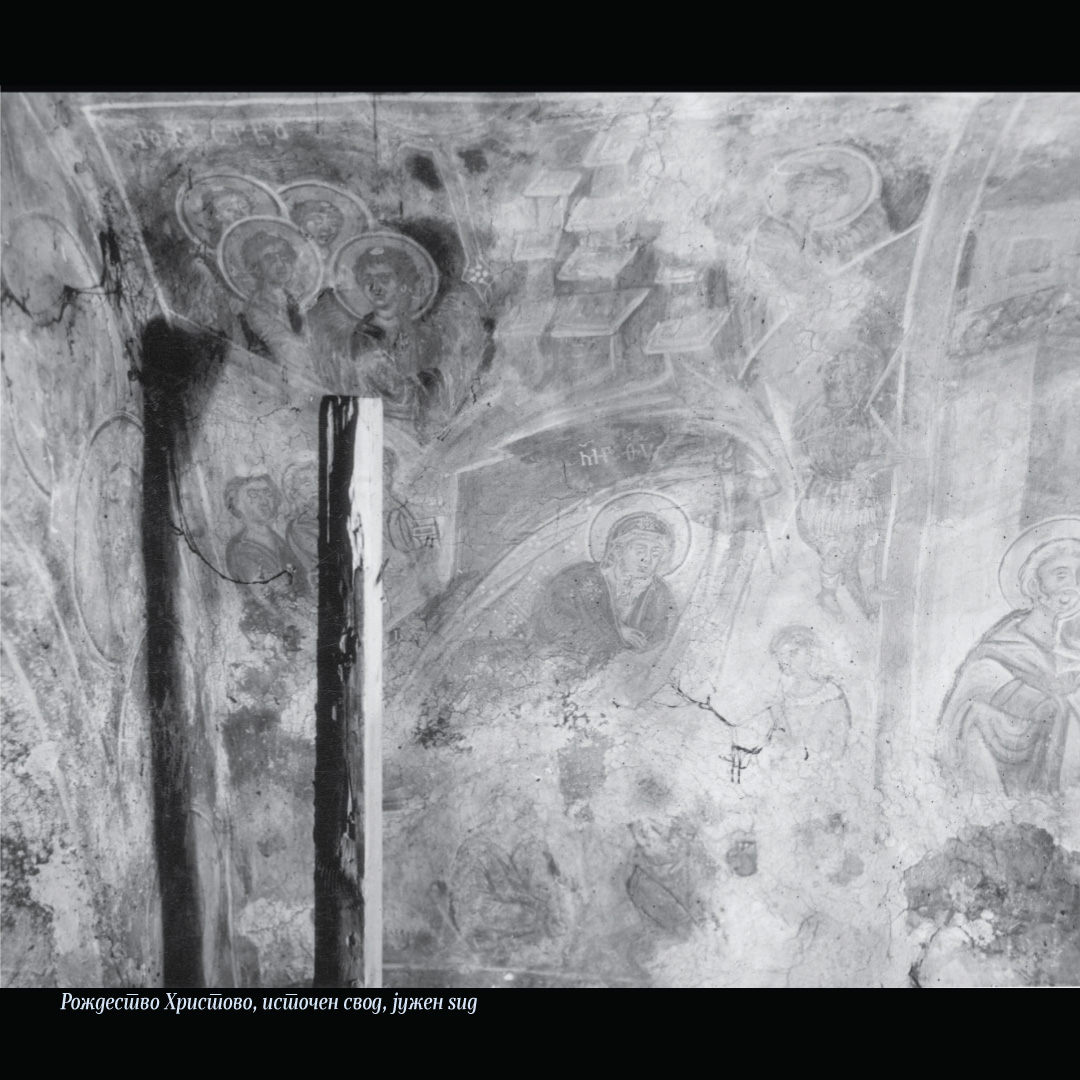
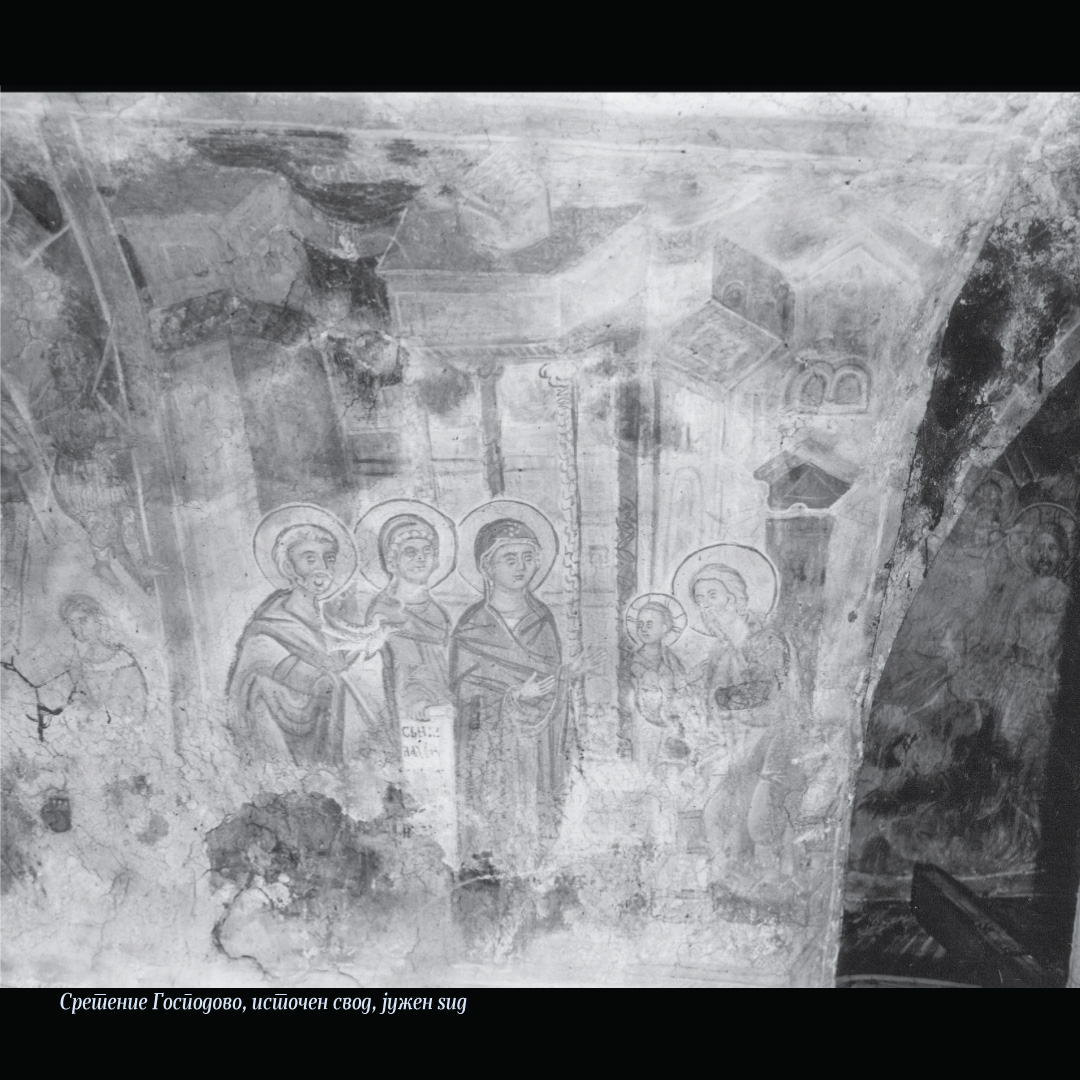
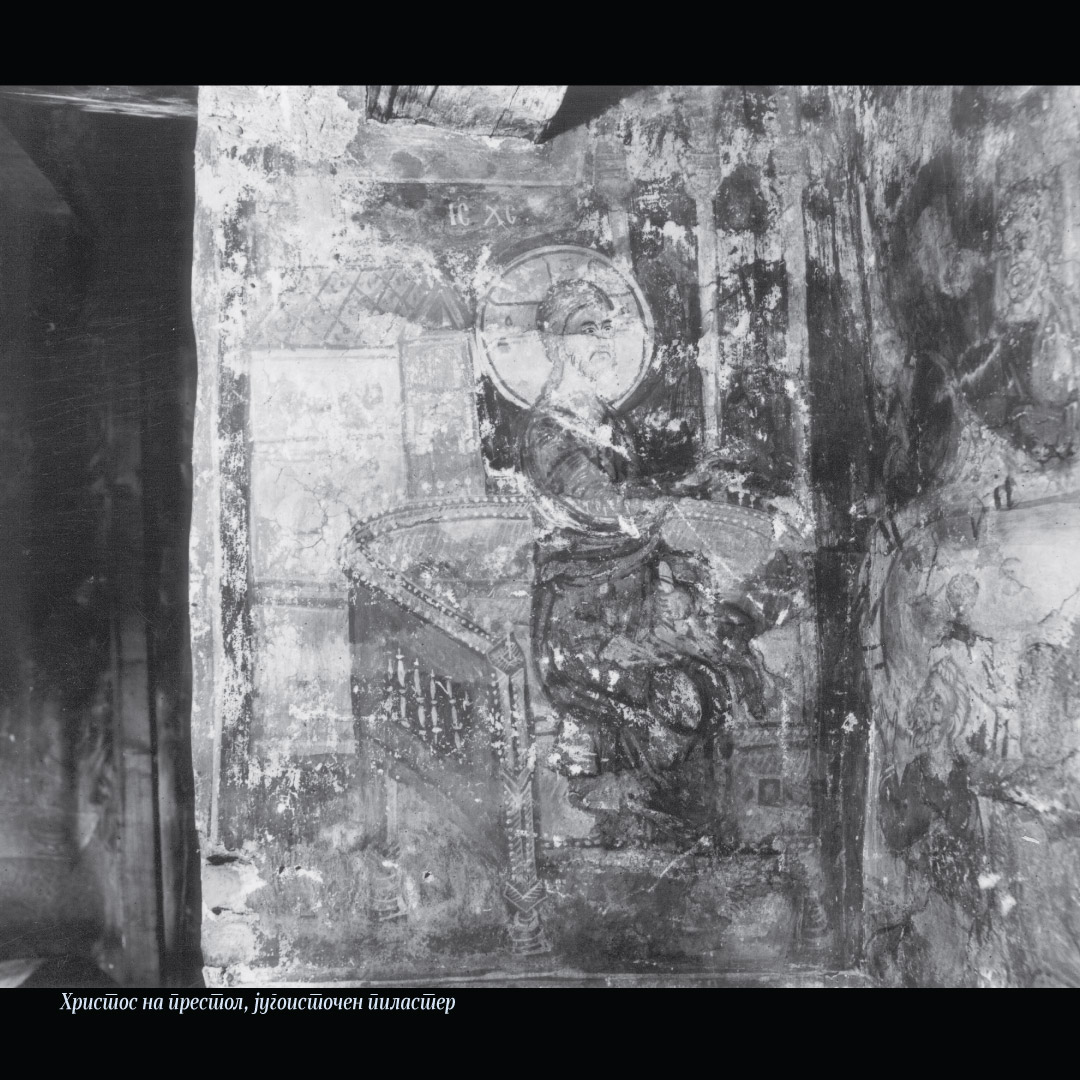
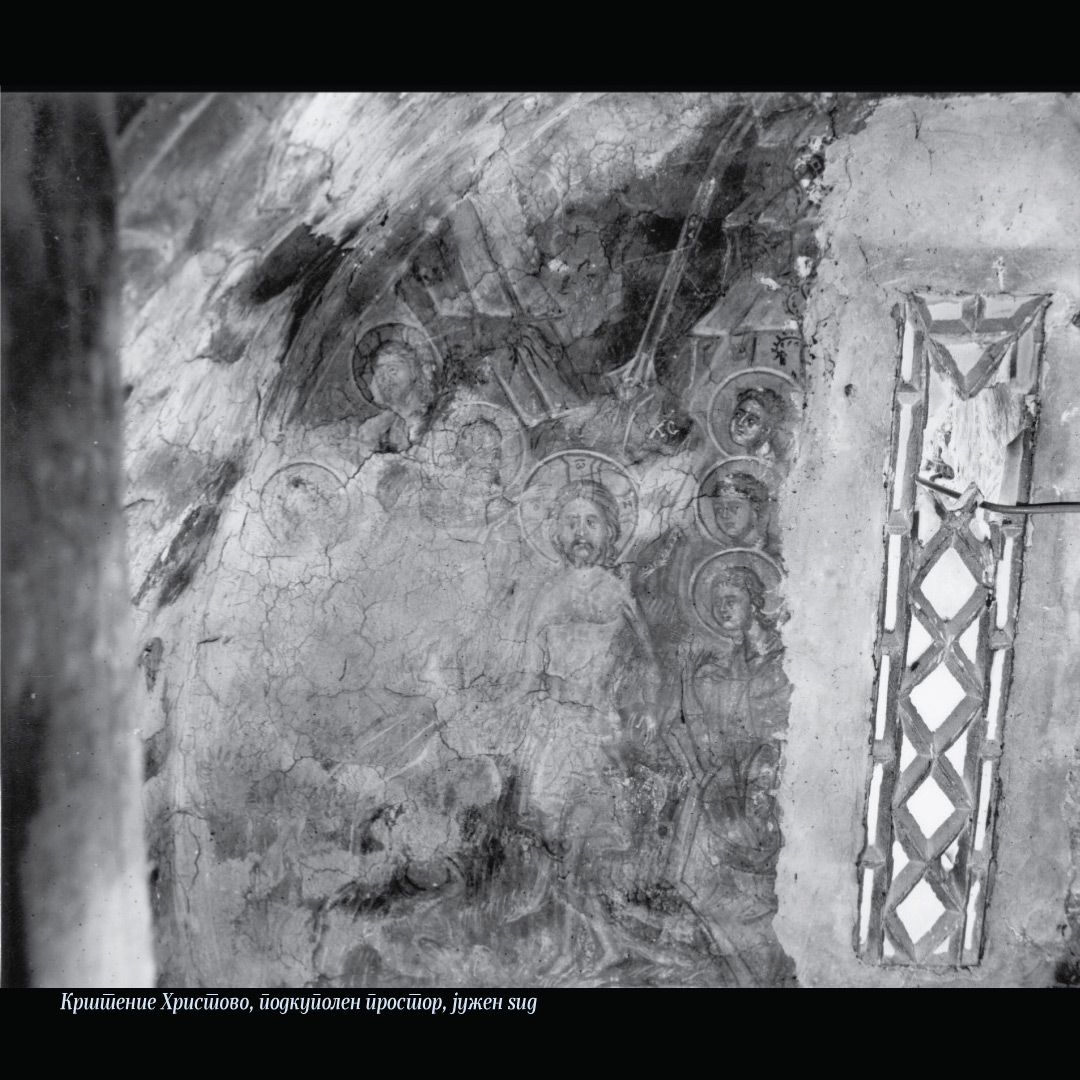
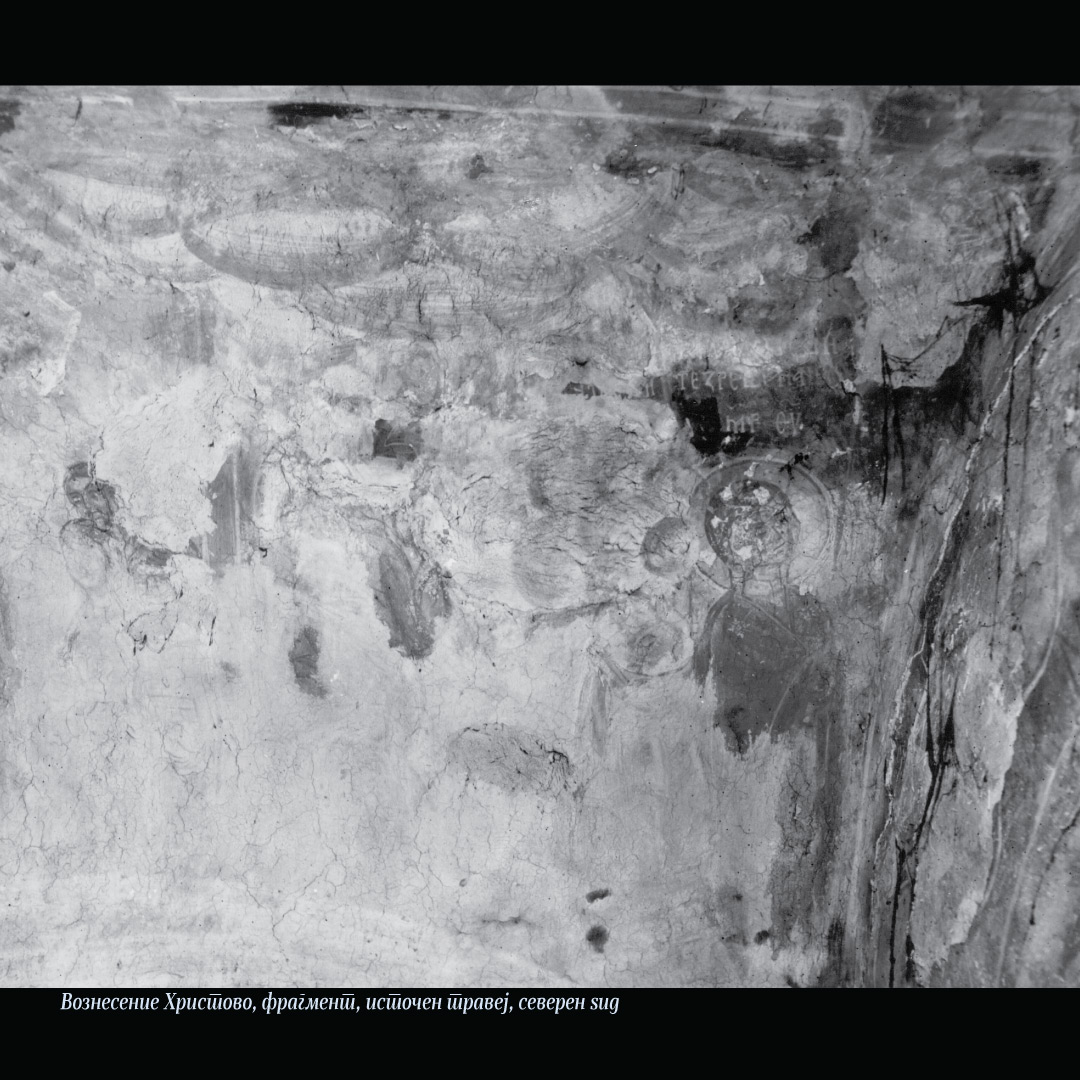
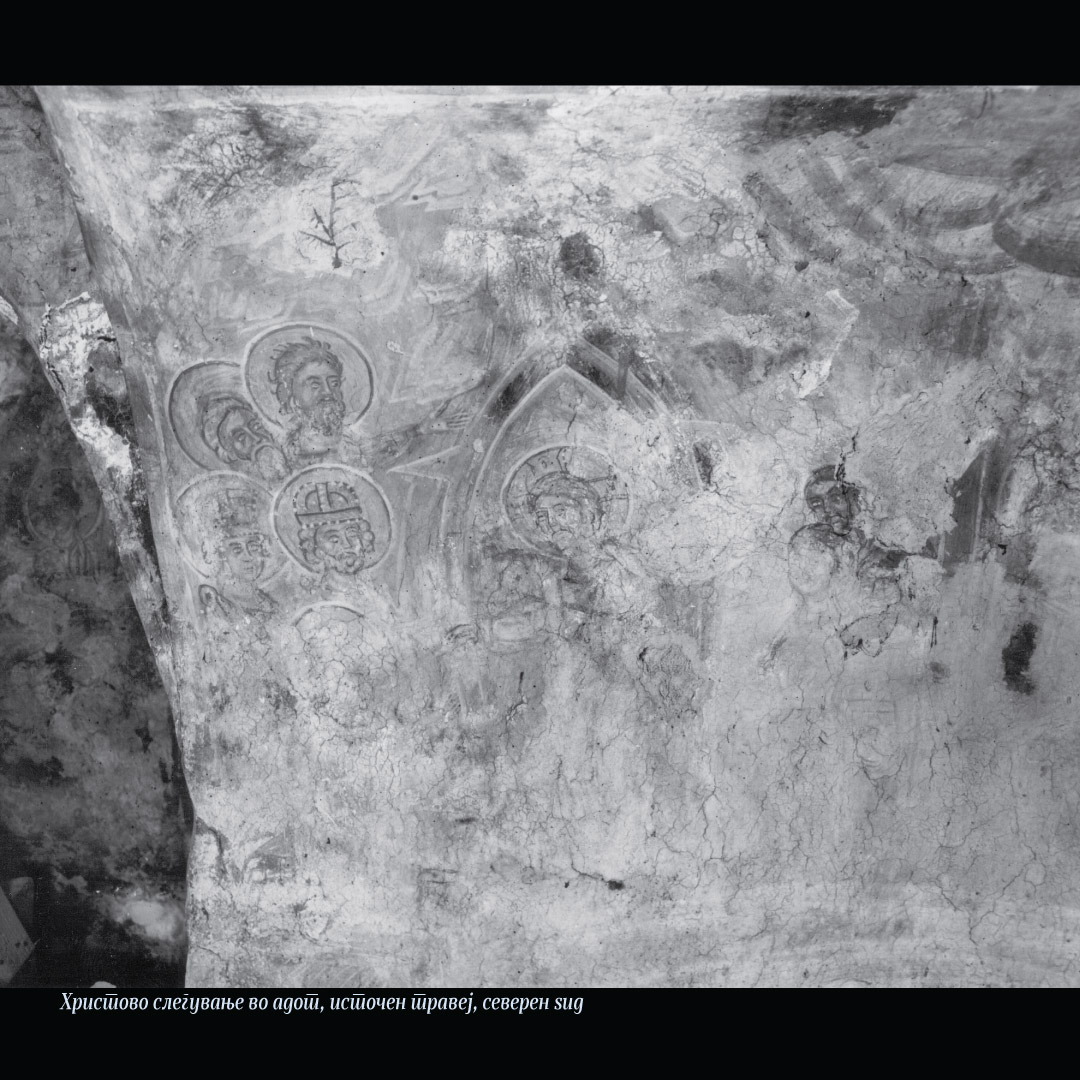
The great holiday scenes
They begin with the Annunciation (on the east wall), and are then presented in the highest (third) zone on the south wall, in the following order from east to west: The birth of Christ, the Meeting, the Baptism, the resurrection of Lazarus and the entry into Jerusalem / Palm Sunday. The Transfiguration of Christ is shown on the west wall, next to the Dormition of the Virgin. On the north wall, the scenes of the great holidays continue in order, from west to east: the Crucifixion, The myrrh bearing woman at the tomb of Christ, the Descent into Hell, and at the end of the wall surface is the lower part of the Ascension, where are presented the figures of the Virgin Mary and the apostles. In the last scene, above the face of Mother Mary, the following words are written: “Ye men of Galilee, why stand ye looking into heaven? This Jesus, which was received up from you into heaven, shall so come in like manner as ye beheld him going into heaven.” Then the Descent of the Holy Spirit follows, a composition completely artistically degraded by placing it in the narrow area of the triumphal arch. The cycle of the Great holidays ends with the fresco scene of the Assumption of the Virgin, which according to the canons, is always represented on the western wall.
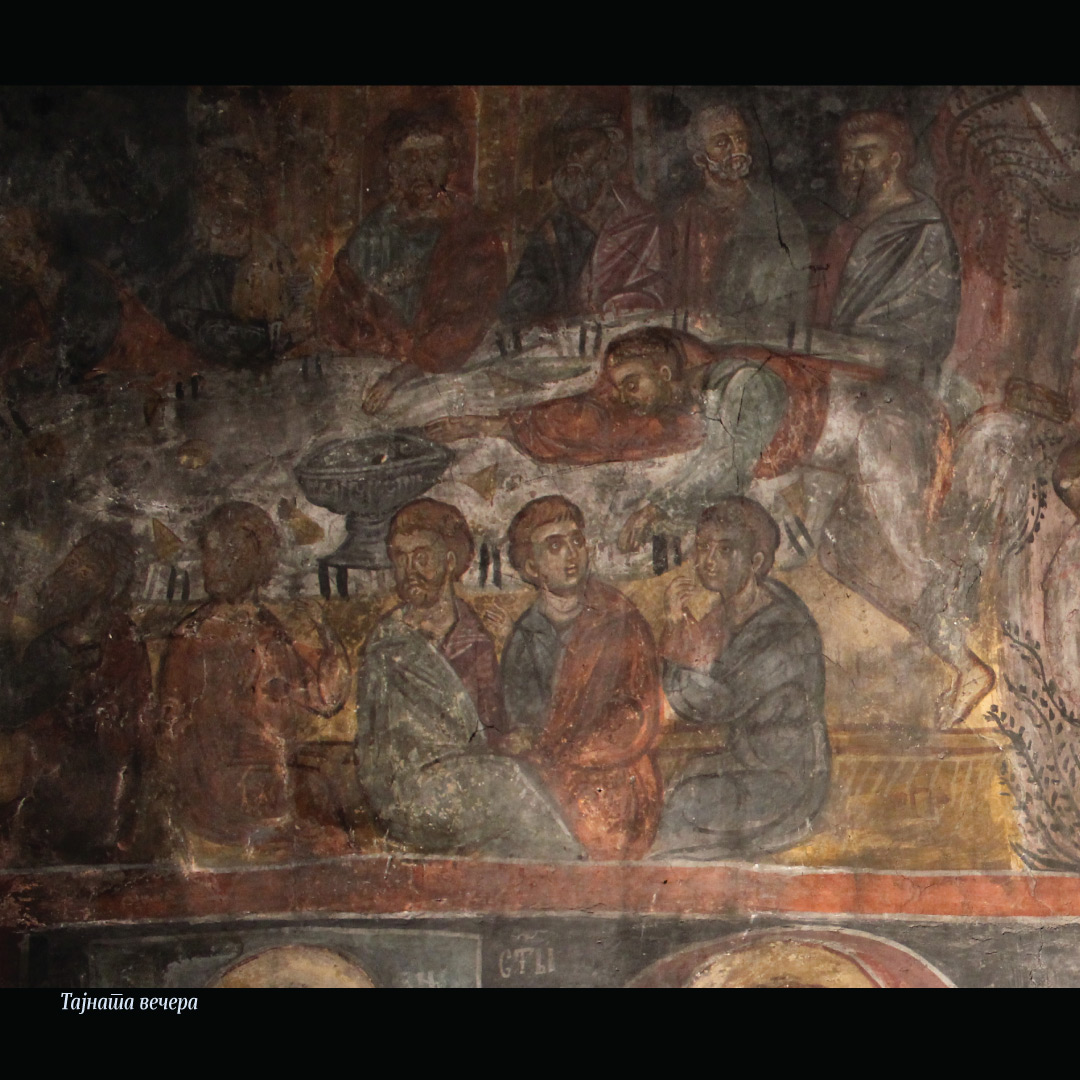
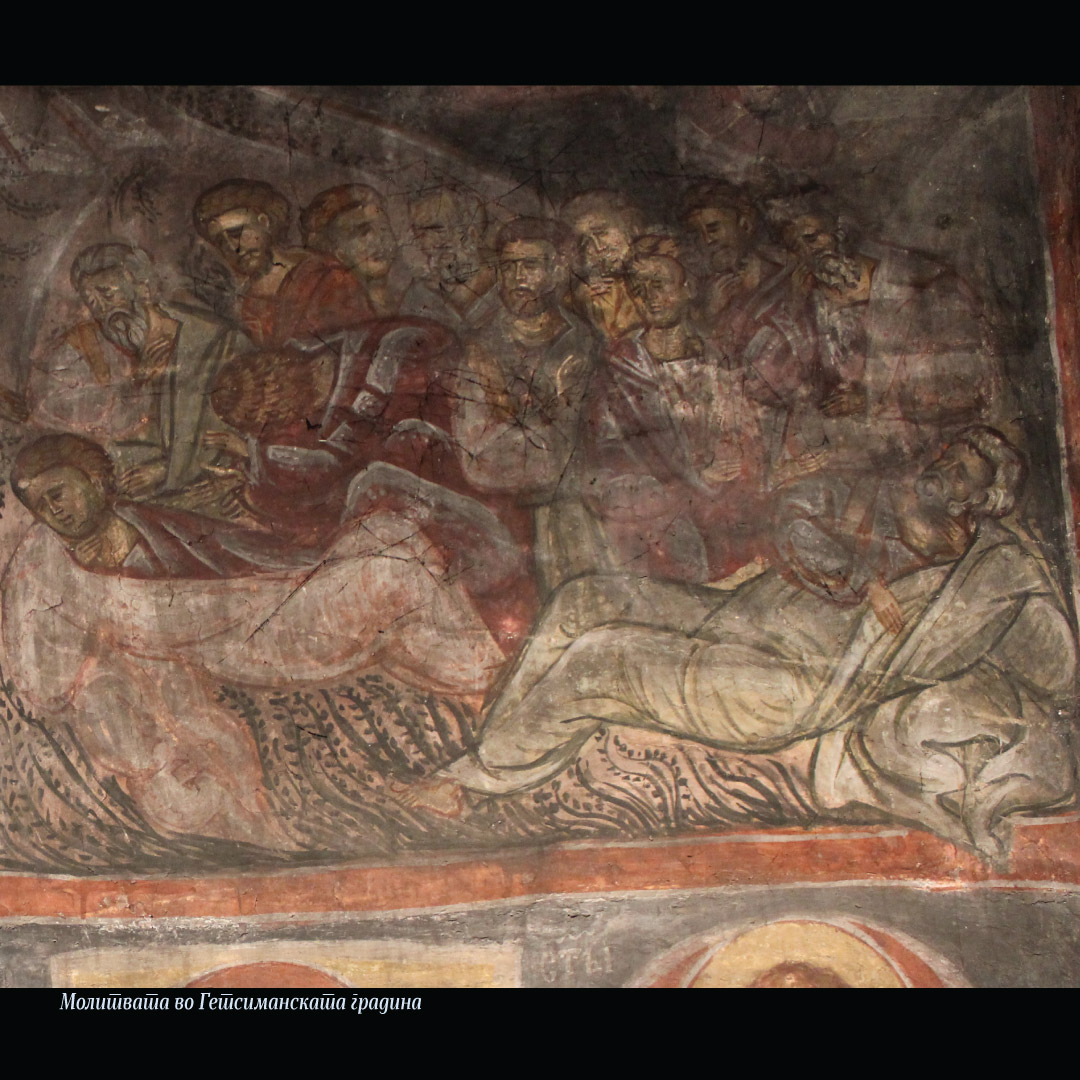
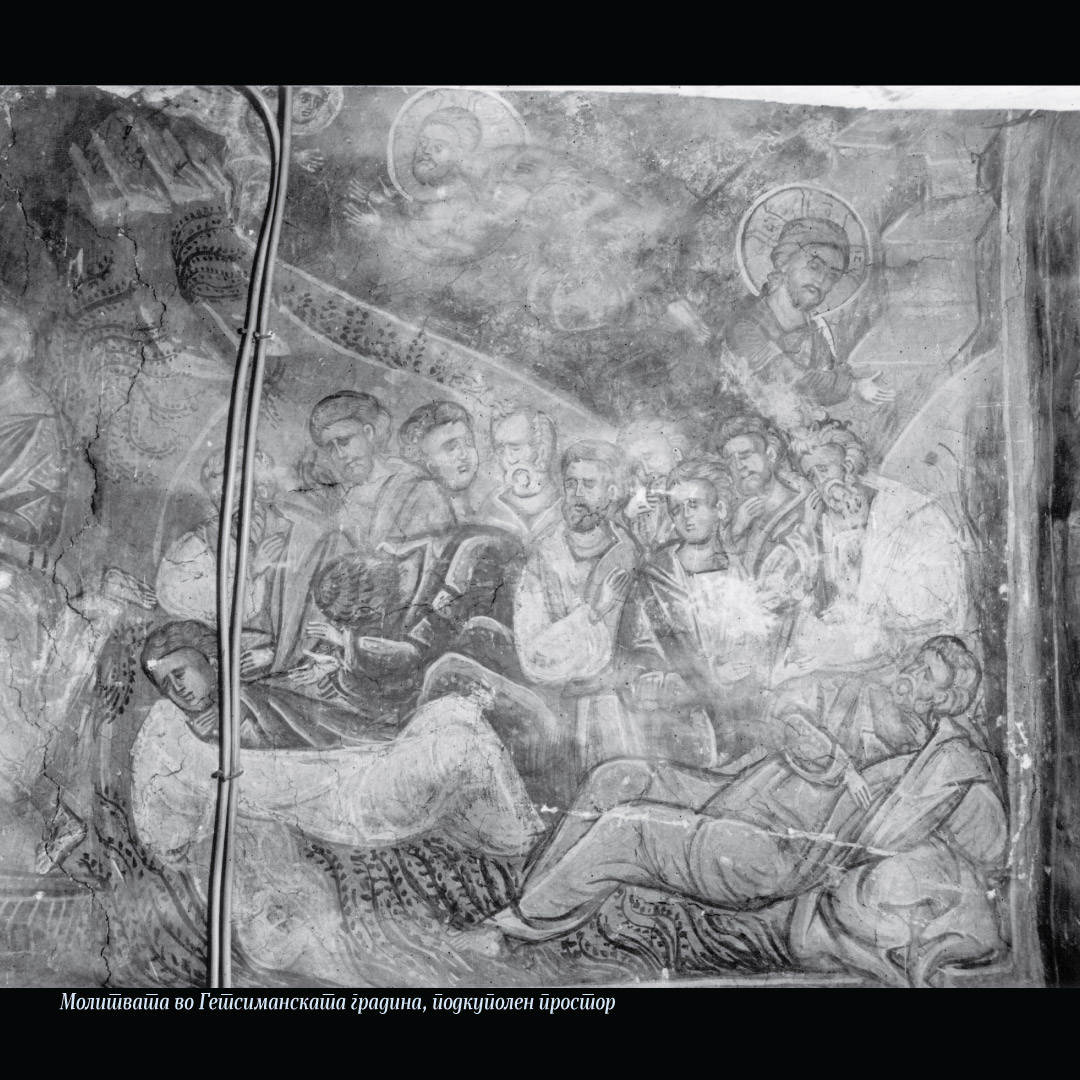
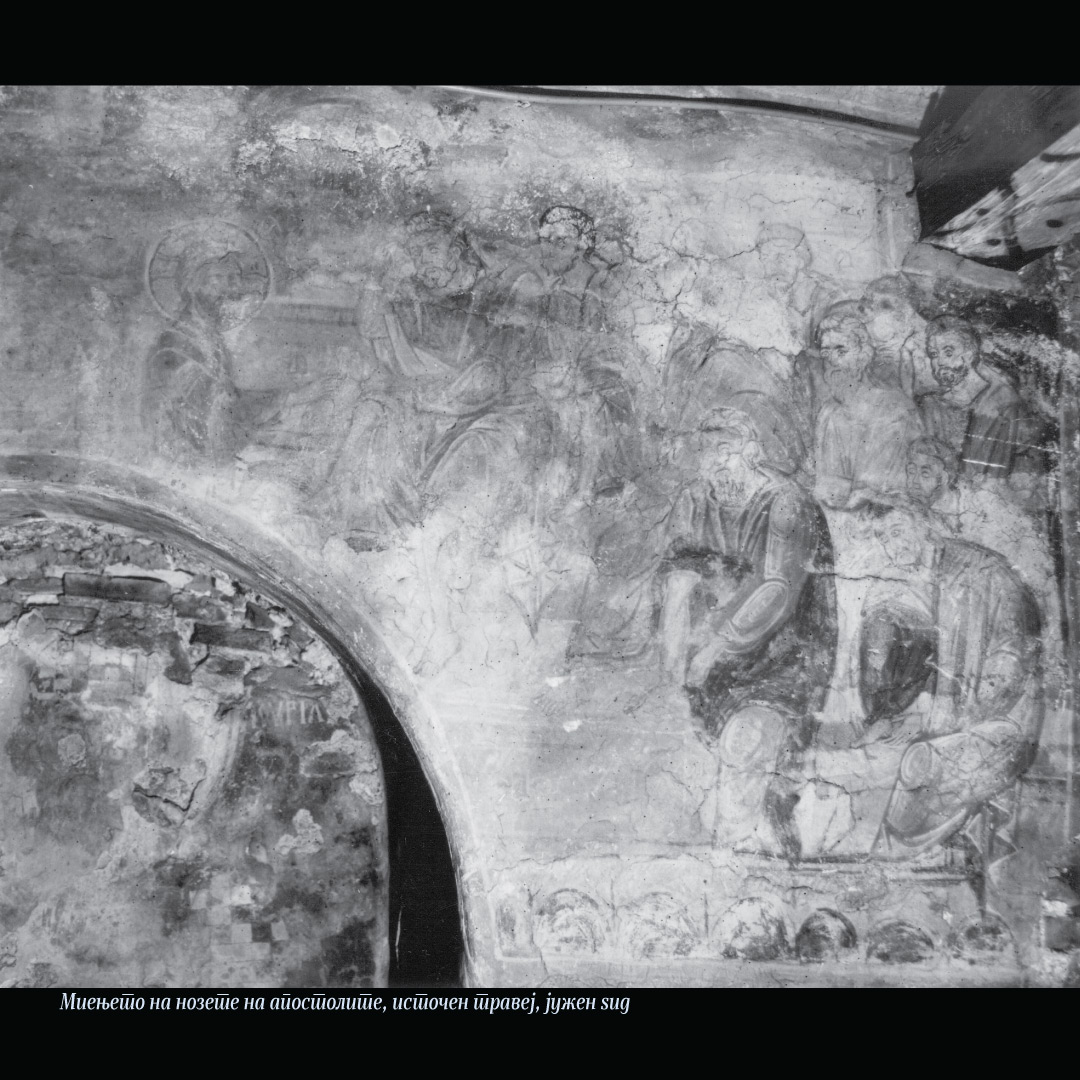
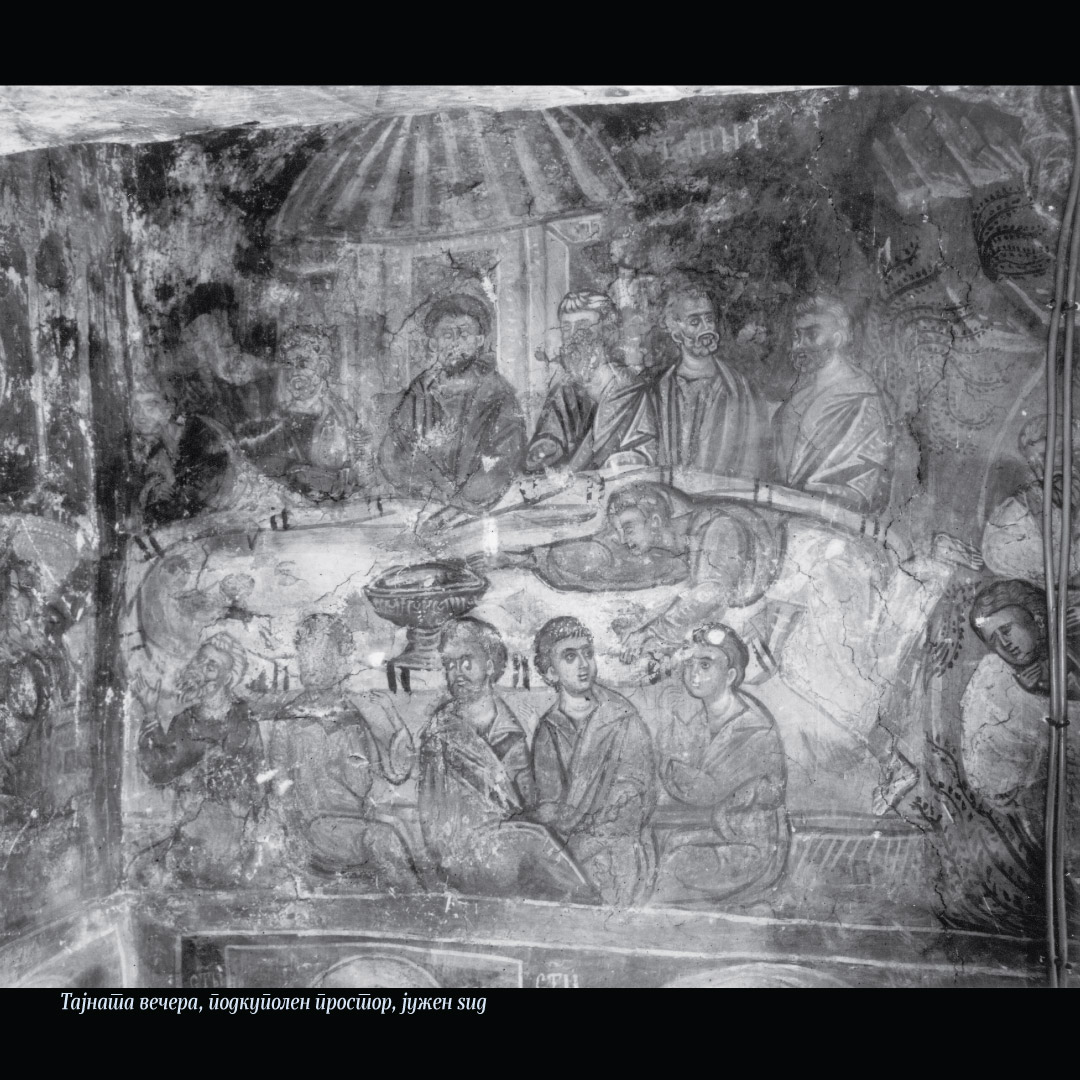
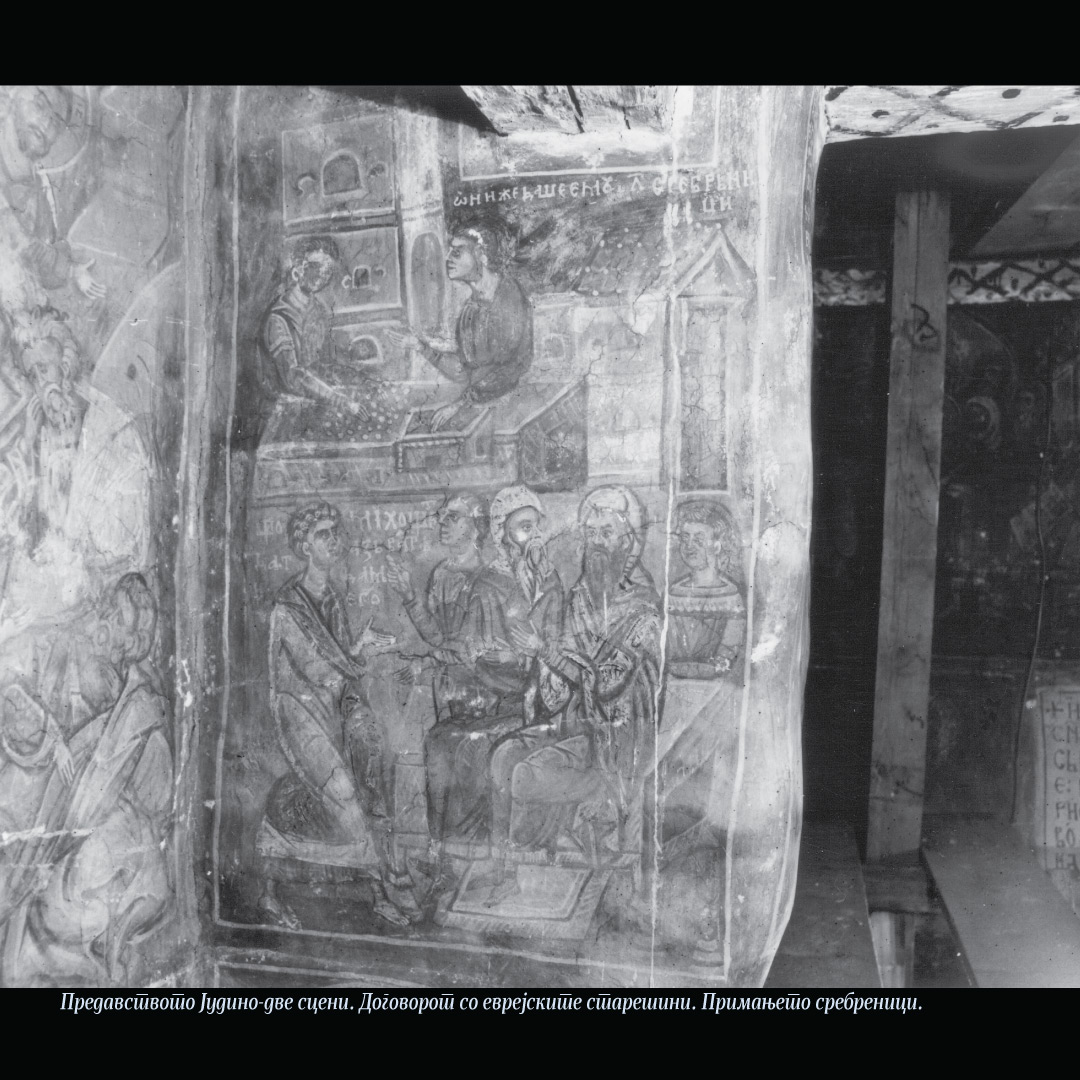
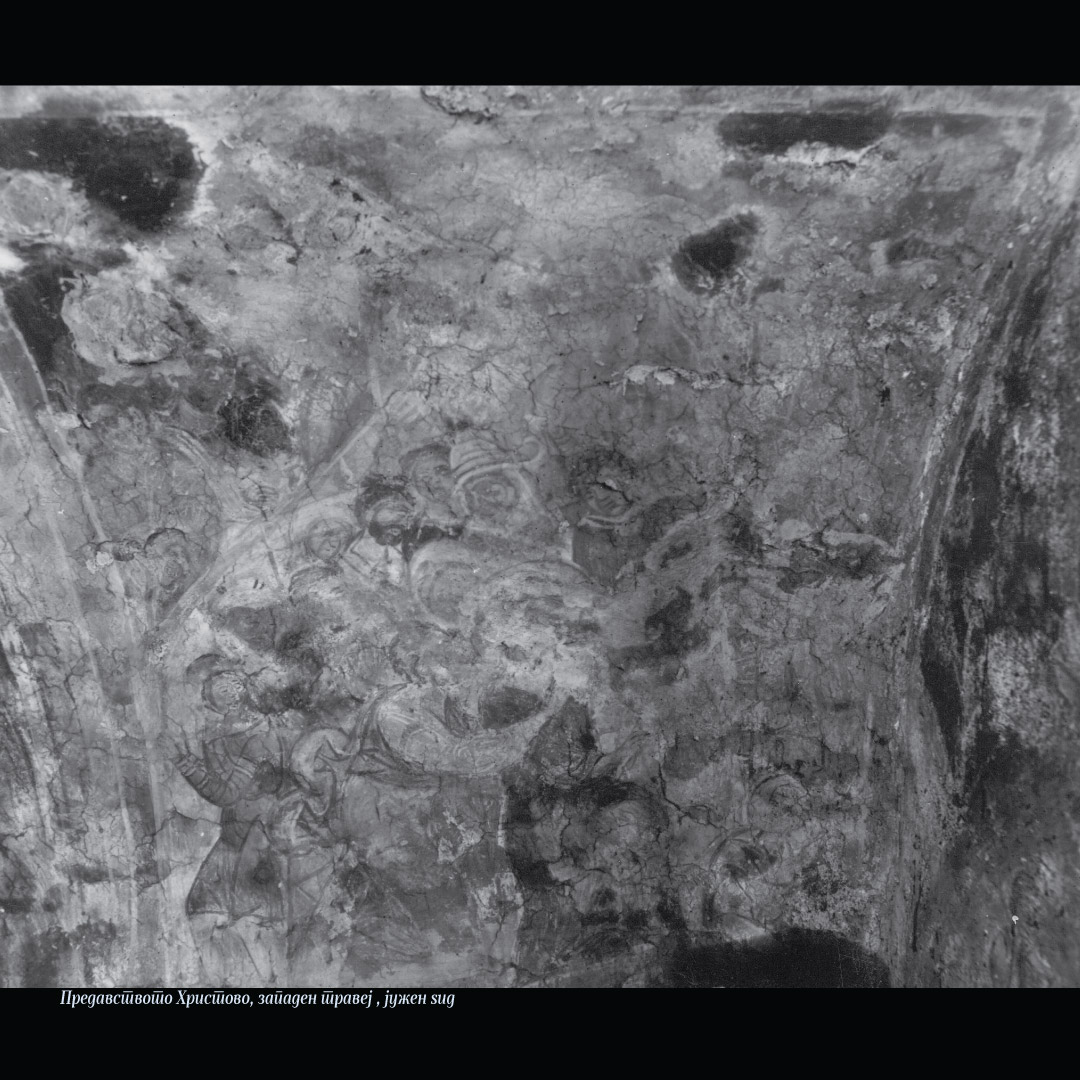
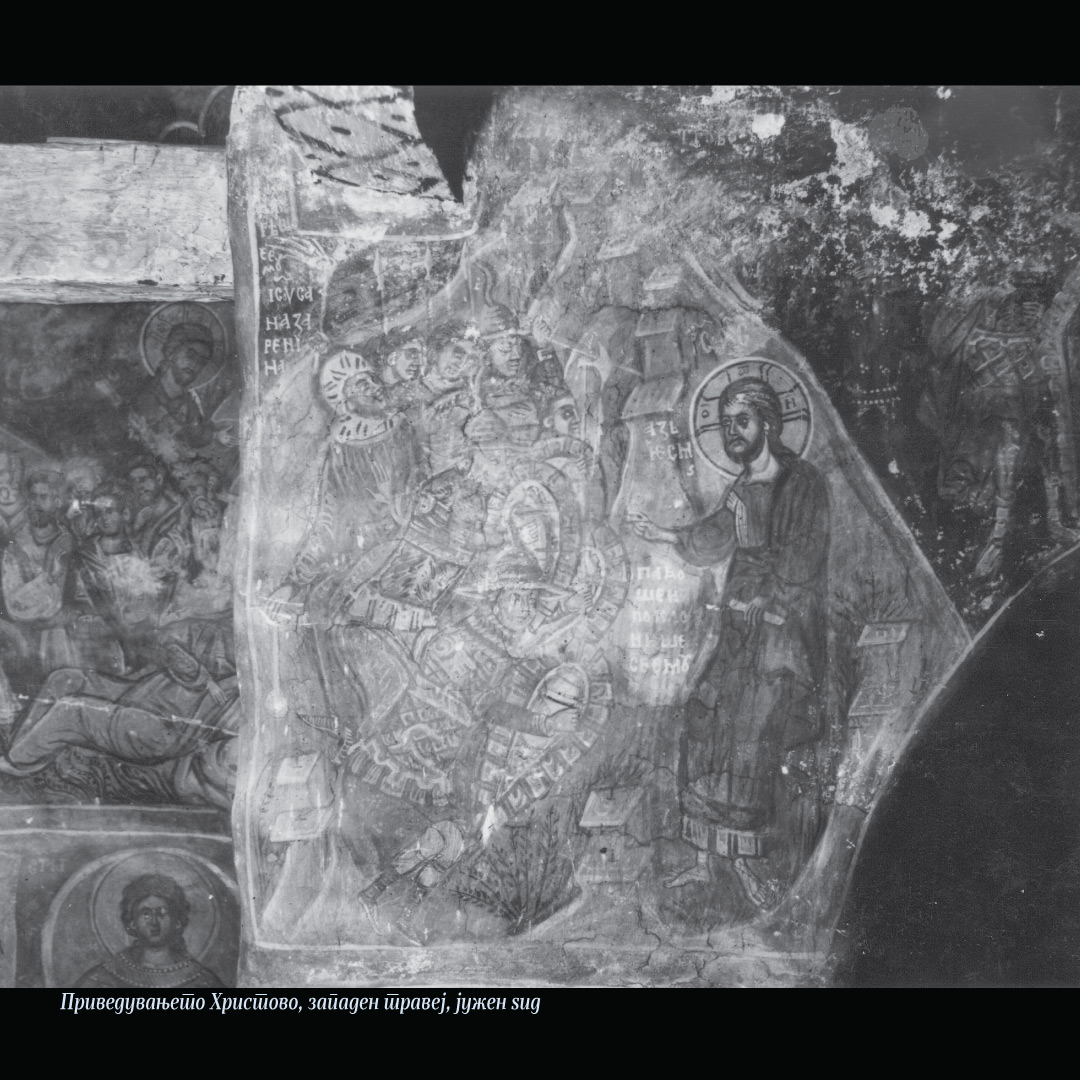
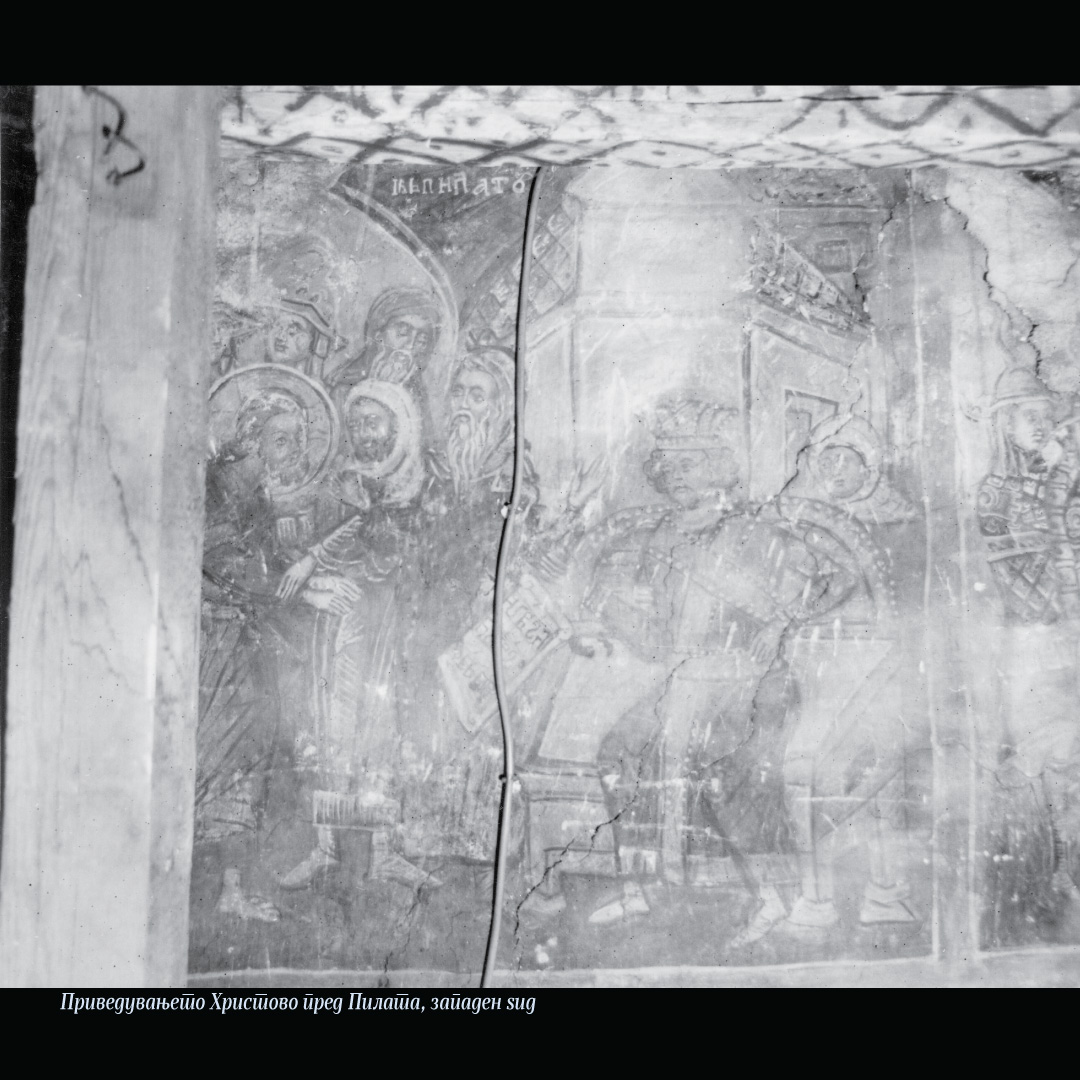
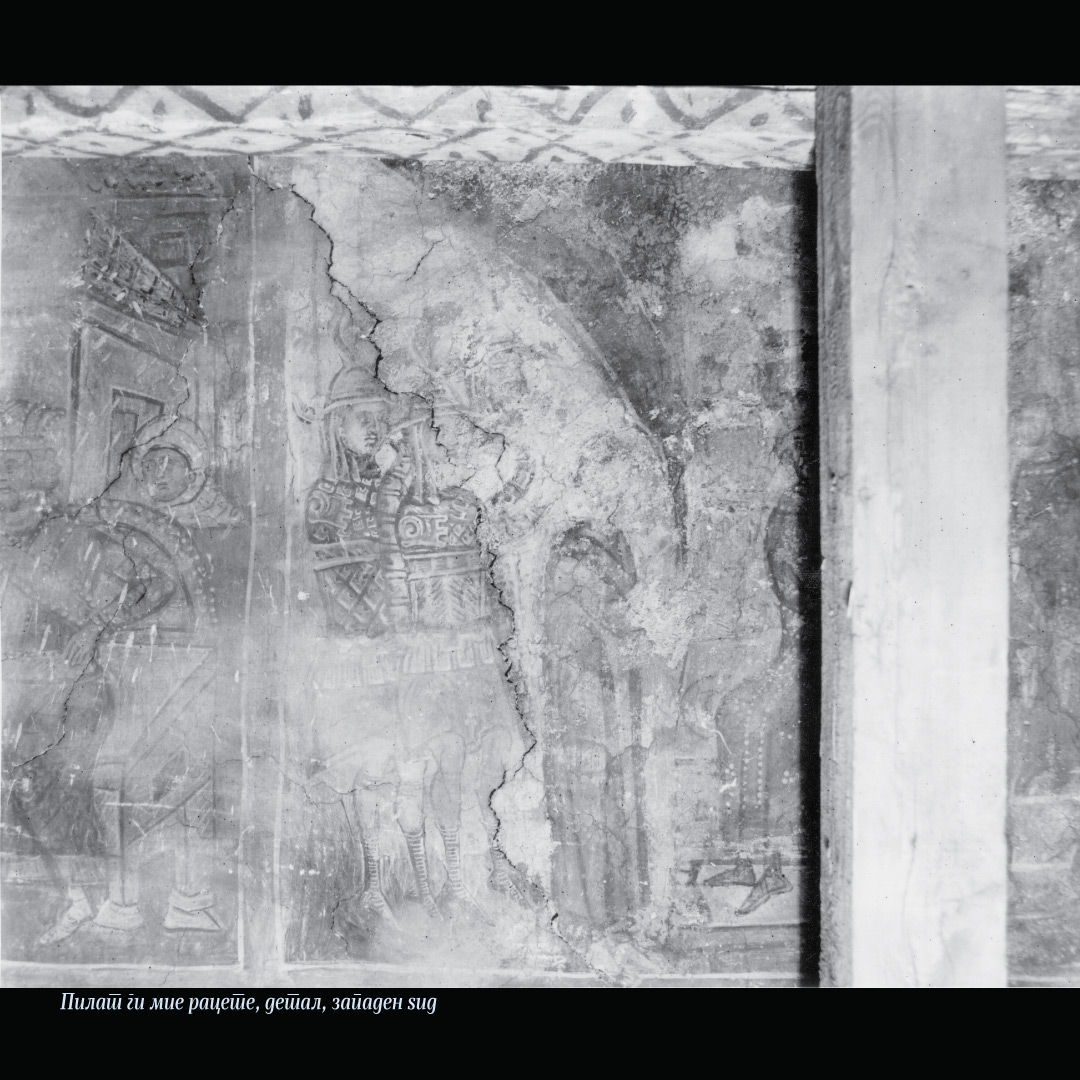
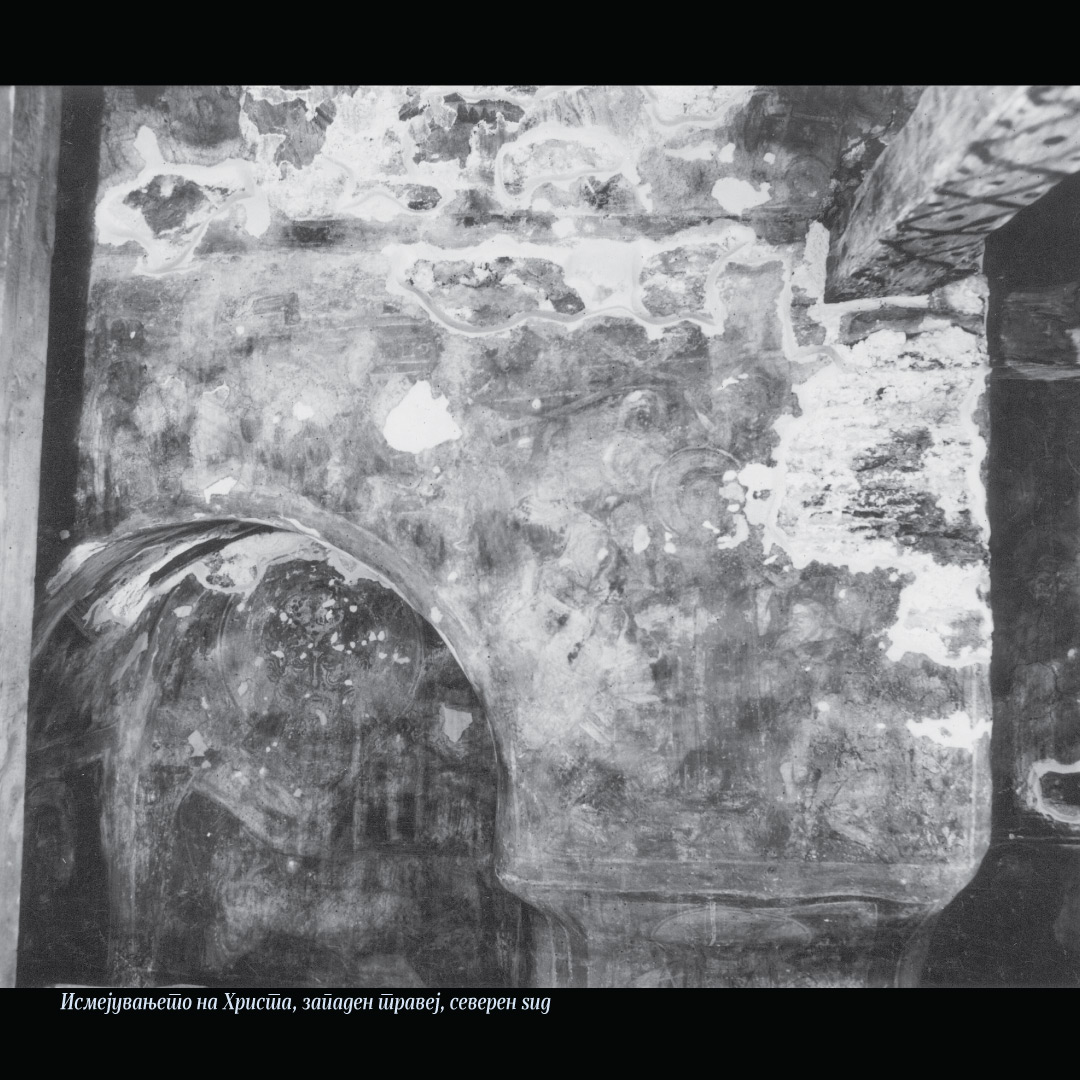
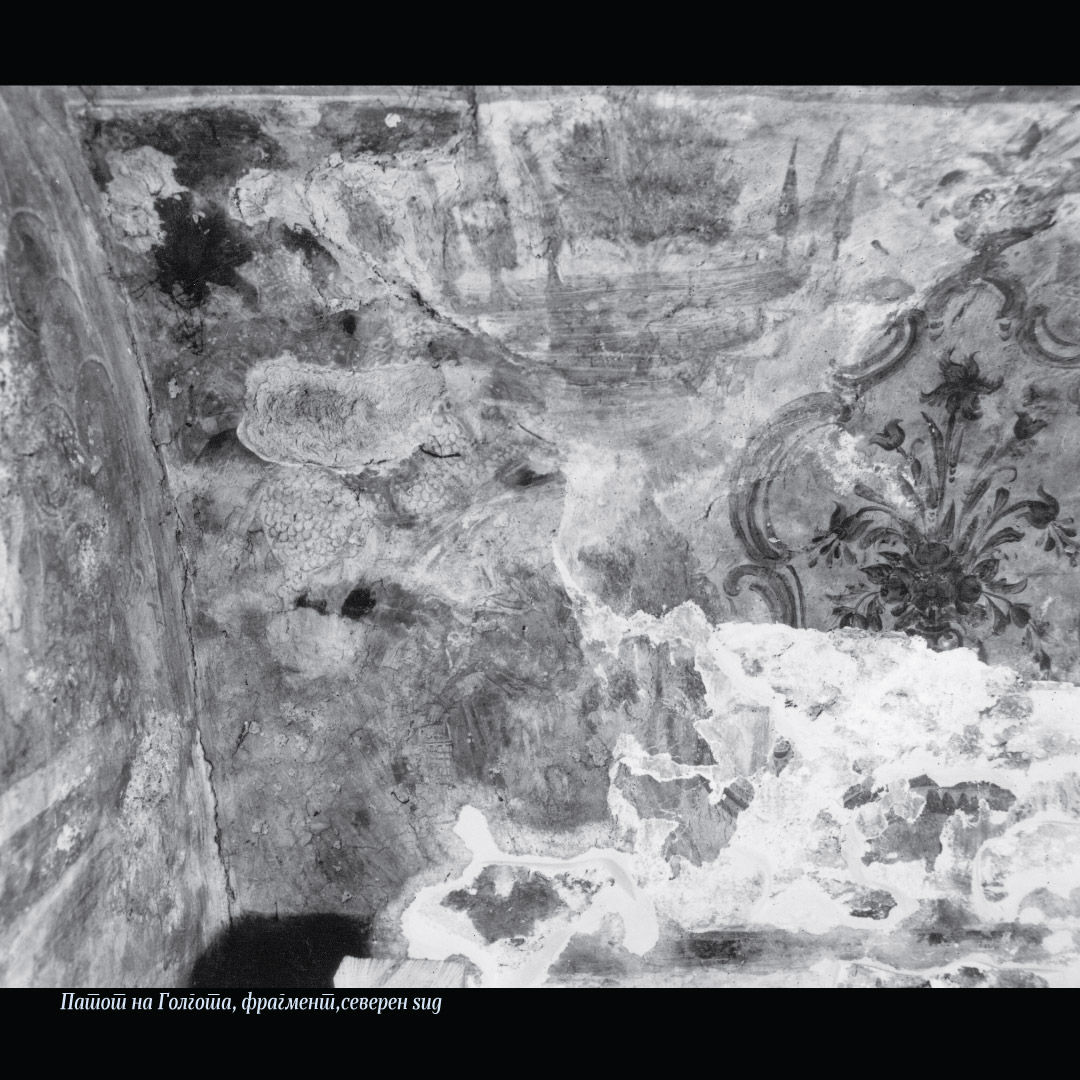
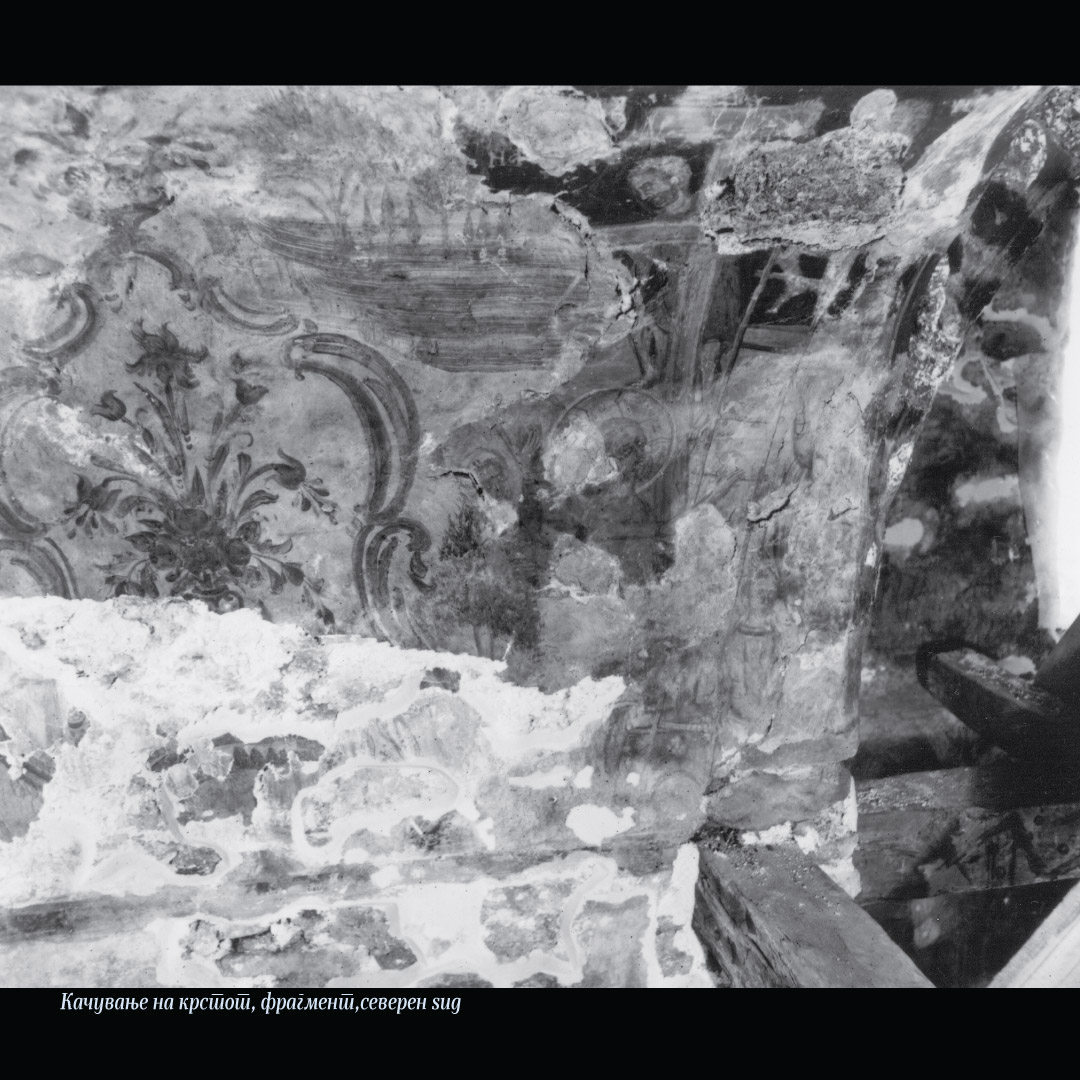
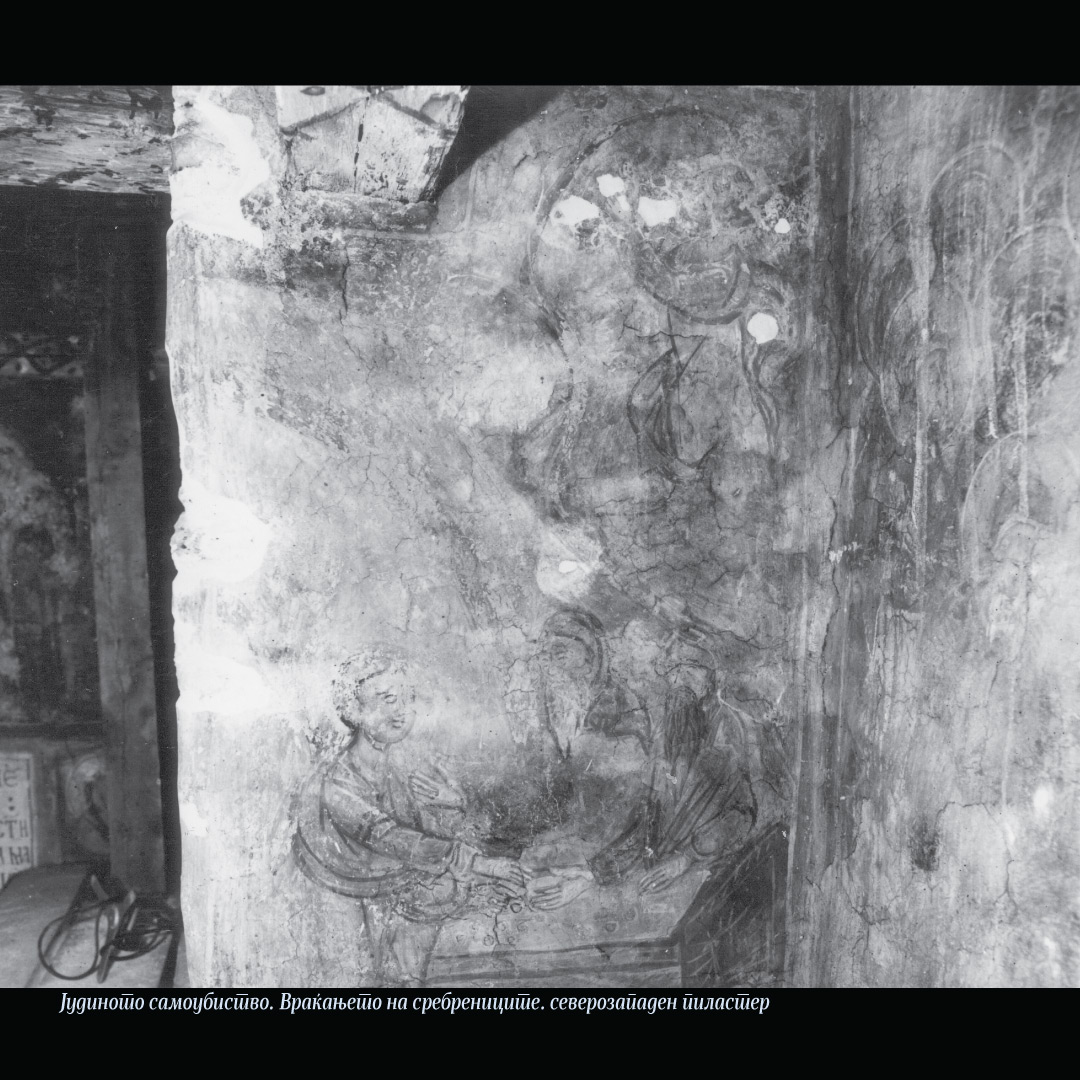
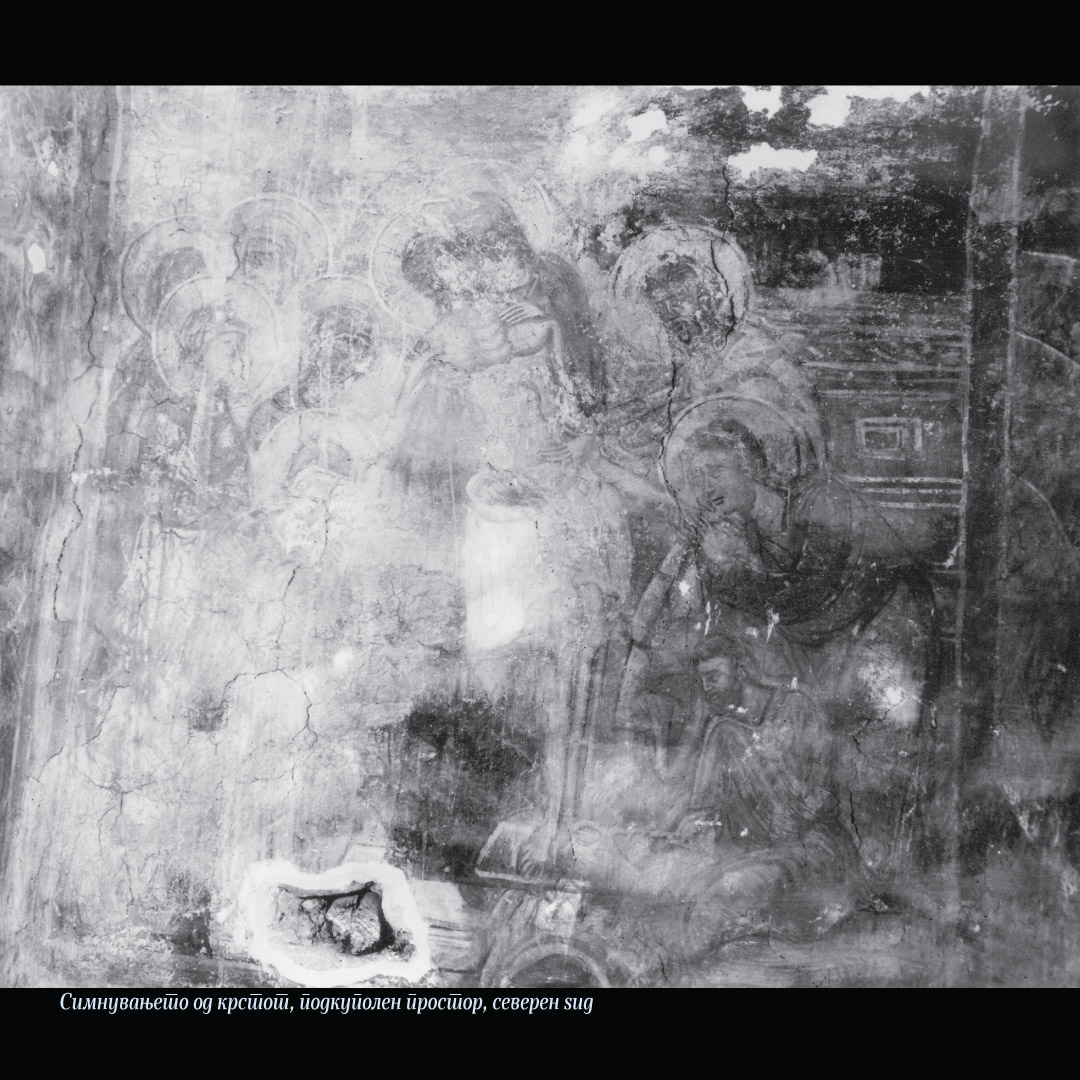


Christ's pain and suffering
The scenes from this cycle are in the second zone, under the fresco scenes of the Great holidays. The cycle of the suffering, as a rule begins with the Last Supper, which, because of its liturgical basis, that Christ himself established the Eucharist (Holy Communion), is usually painted in the altar area. But in this church, this cycle begins with the washing of the feet, which according to the testimony of John the Evangelist, precedes the Last Supper. This is then followed by the scene of the Last Supper in the nave. In the inner (east) side of the pilaster, there are two scenes, one above the other, connected with Judas: the Agreement with Jewish elders and taking the silver. Moving to southern wall, we find the Capture / imprisonment of Christ, where is presented Christ’s conversation with the soldiers (which is according to the Gospel of John, and a true rarity), and the scene of the trial in Annas and Caiaphas. On the west wall is the trial by Pontius Pilate and the washing of his hands. The cycle of suffering continues on the north wall with the following scenes: Peter’s triple denial, the Mockery of Christ and the Crucifixion. On the eastern side on the pilaster there are two scenes, again one above the other, and again associated with Judas: The Return of silver and the Hanging of Judas. The cycle then continues with the scenes of the Deposition from the Cross, the Lamentation and placing Christ in the tomb.
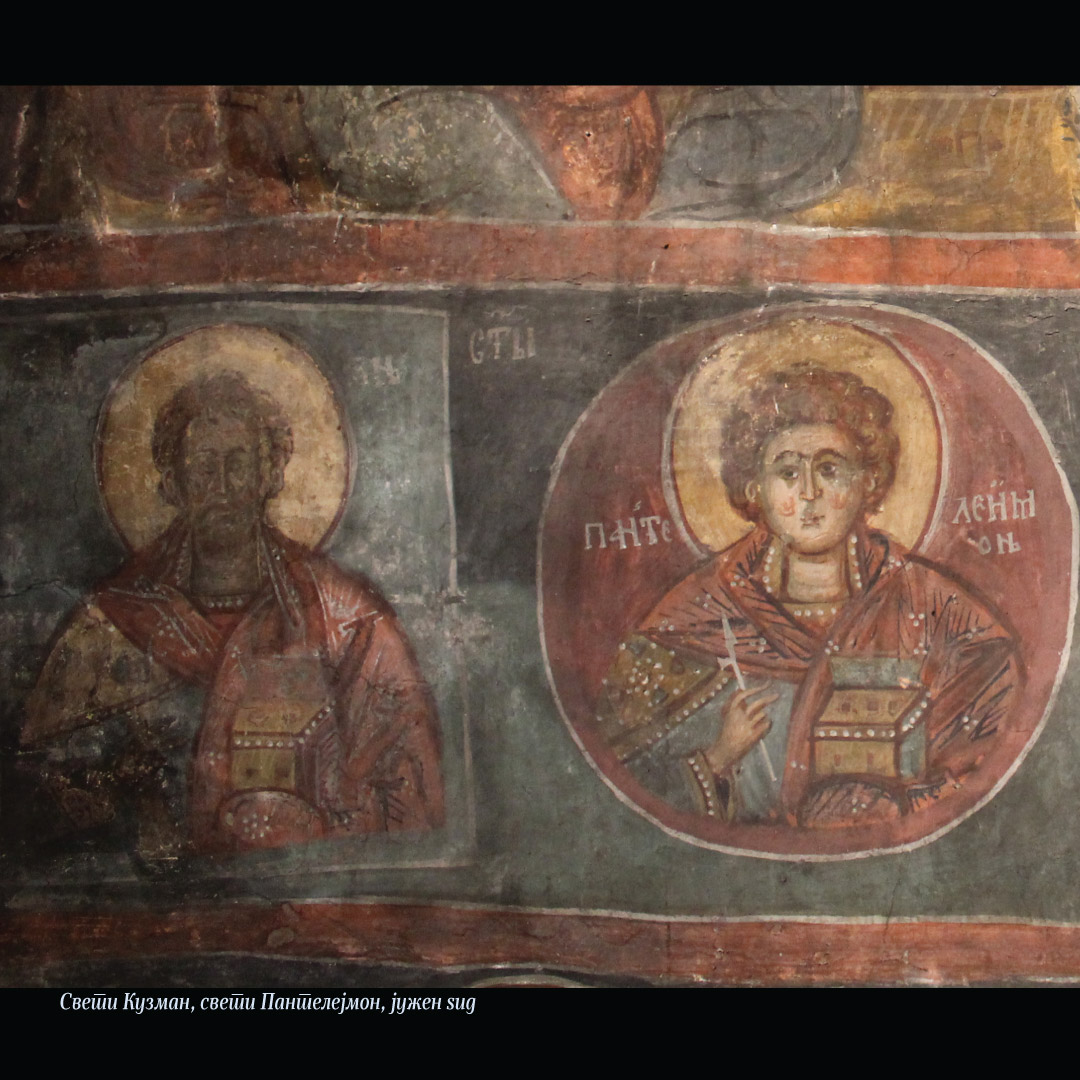
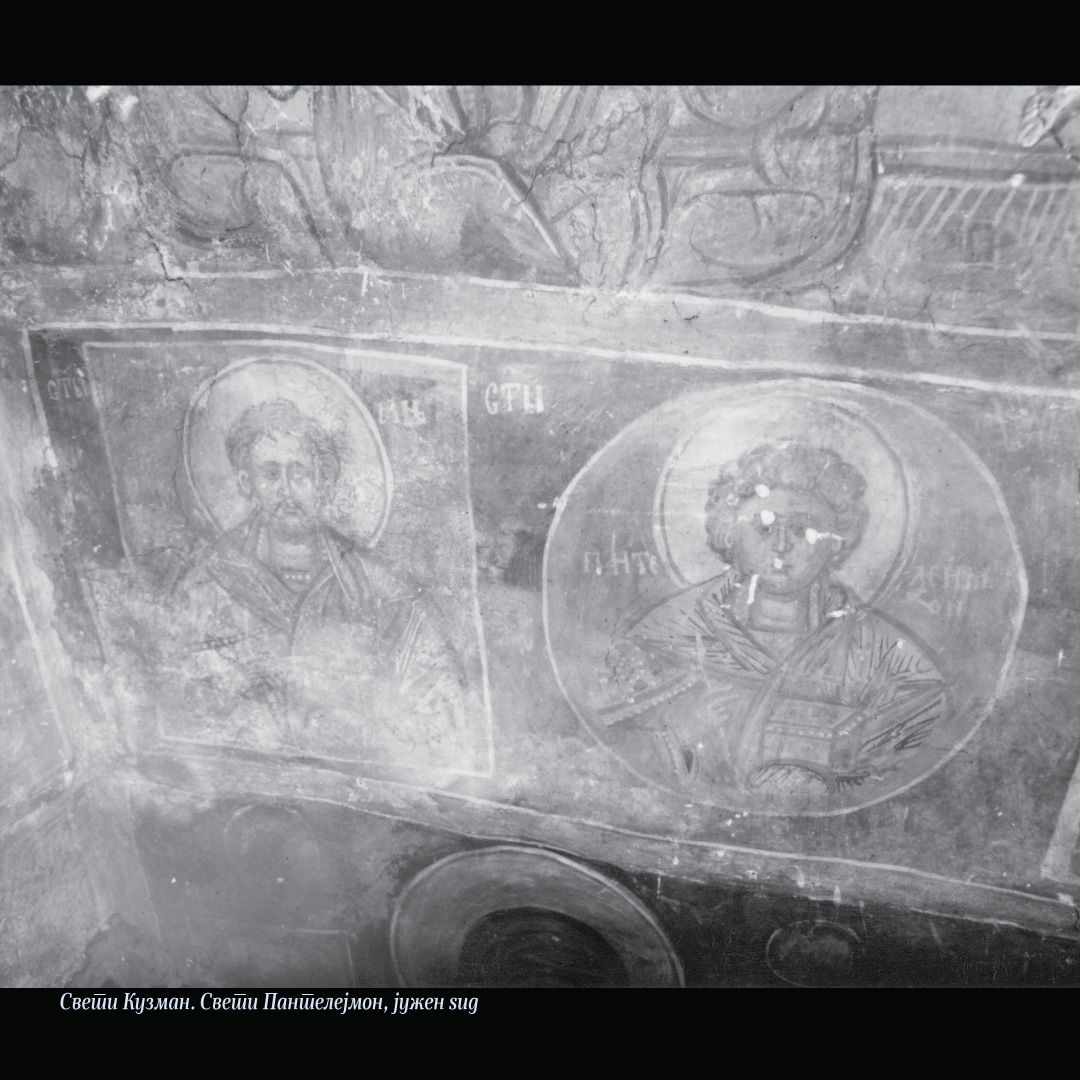
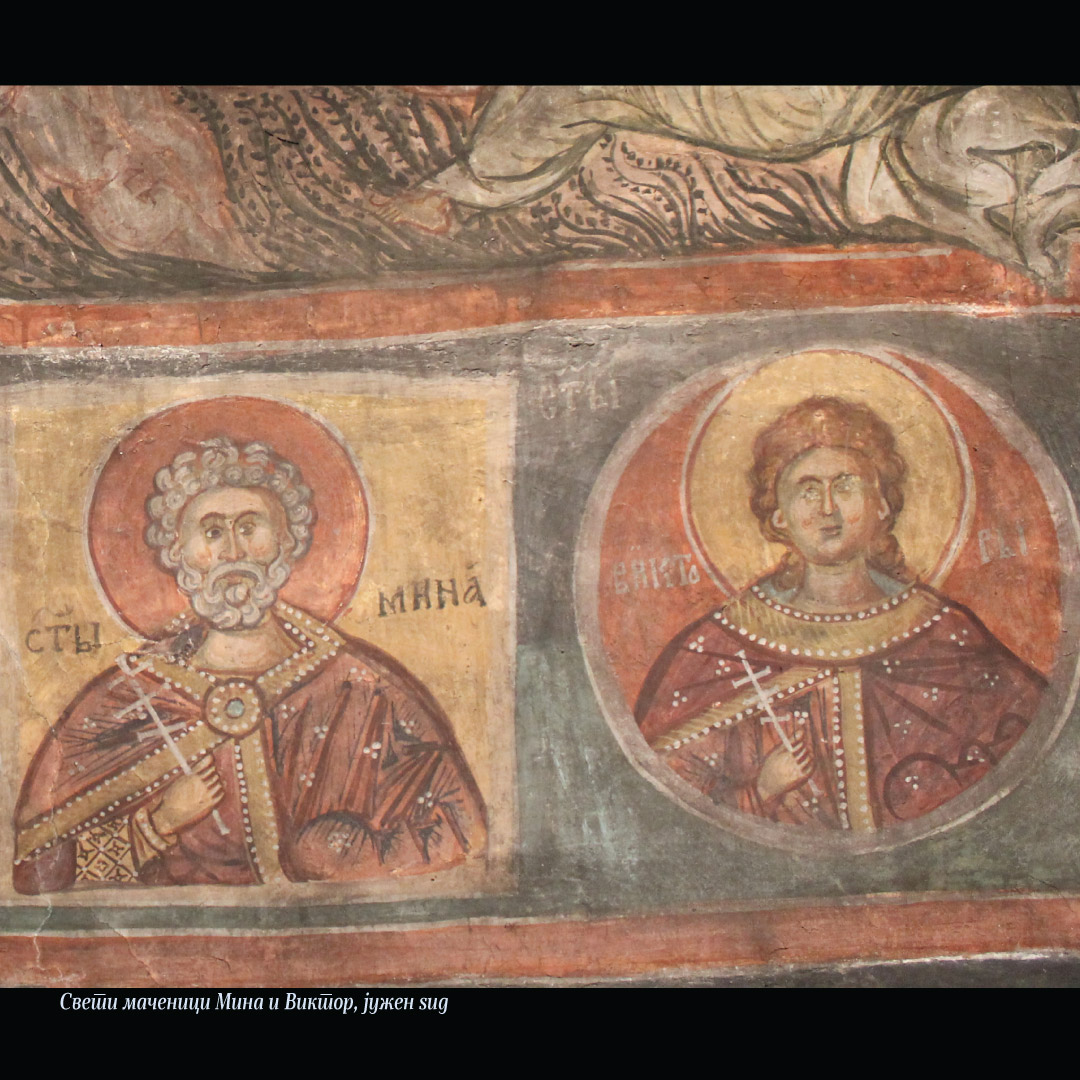
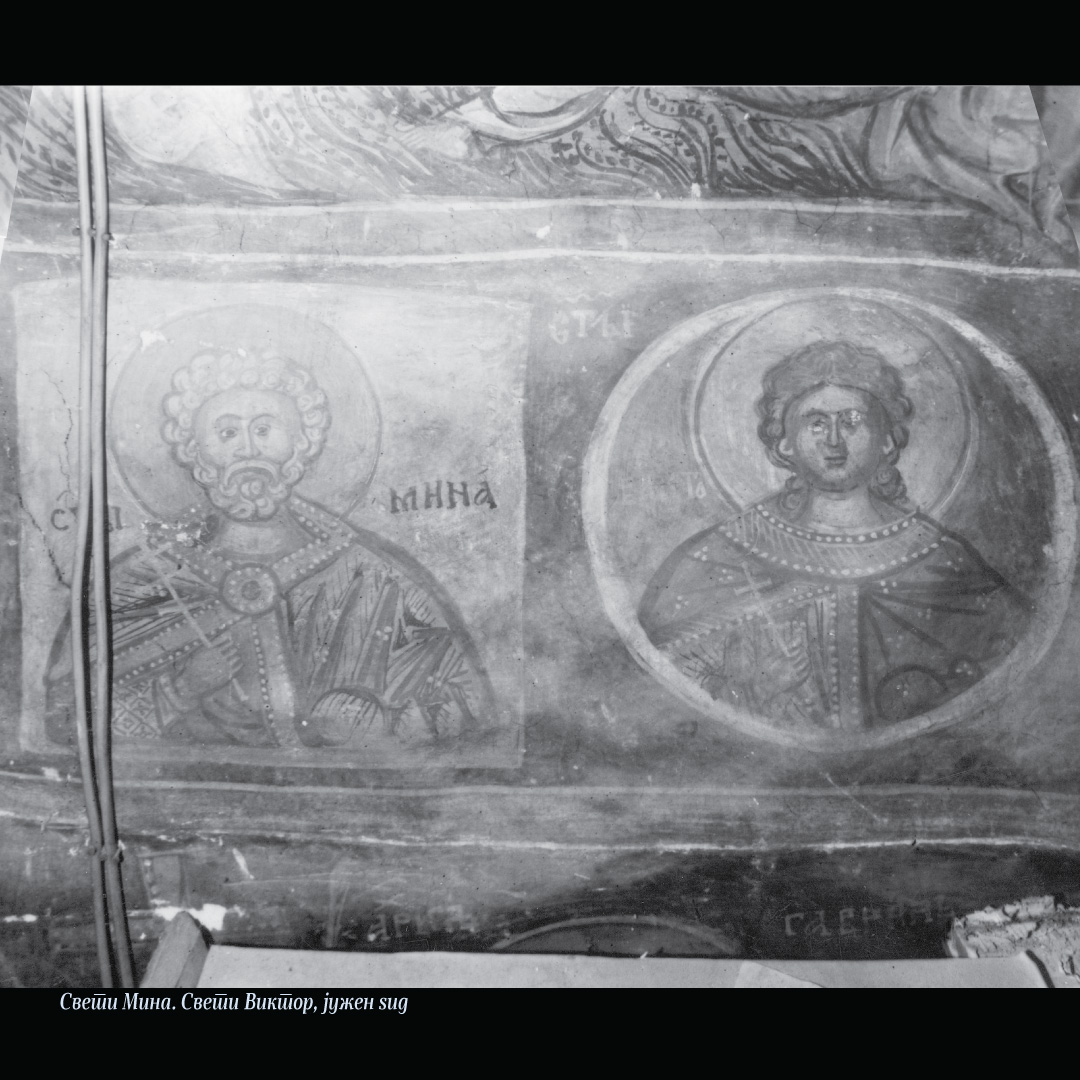
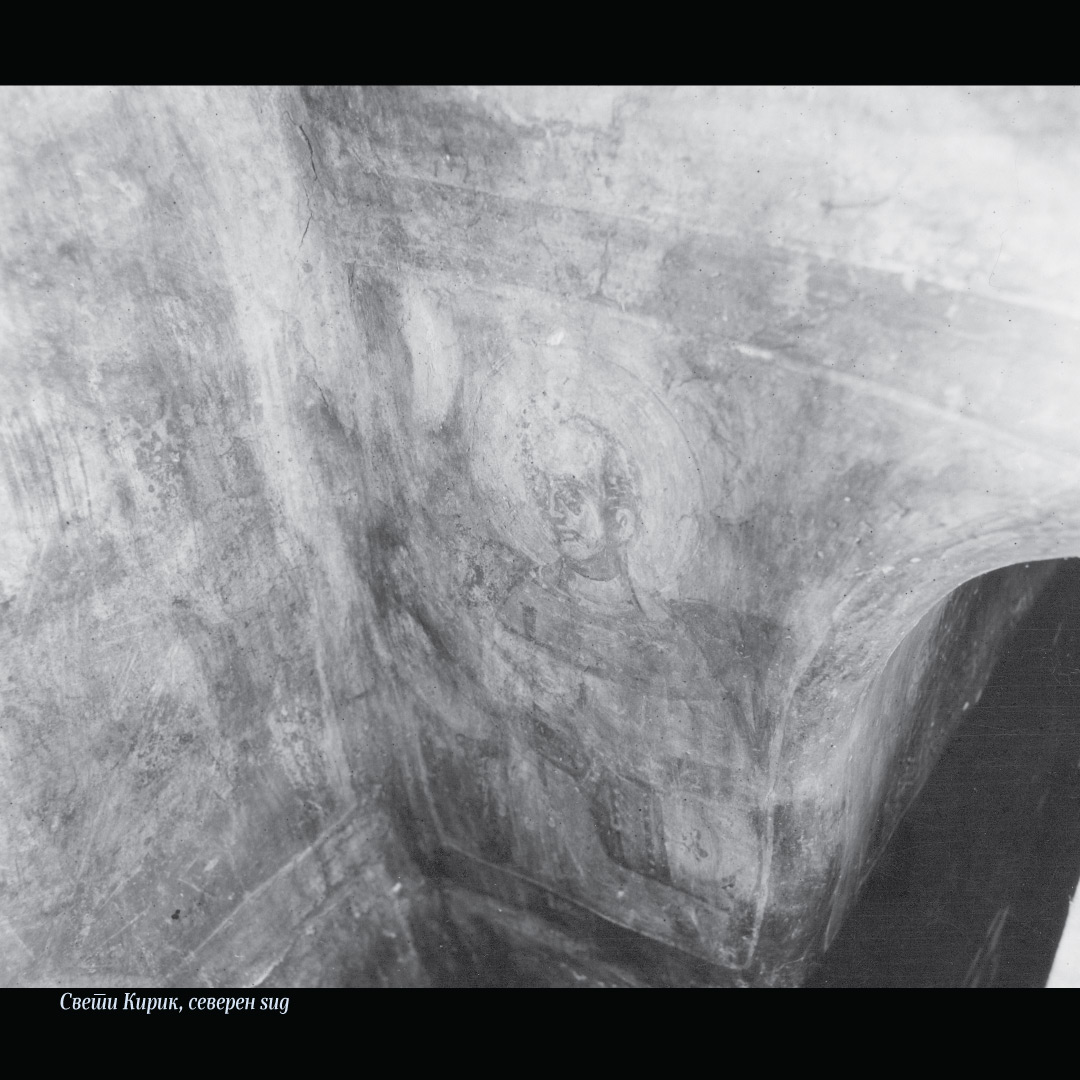
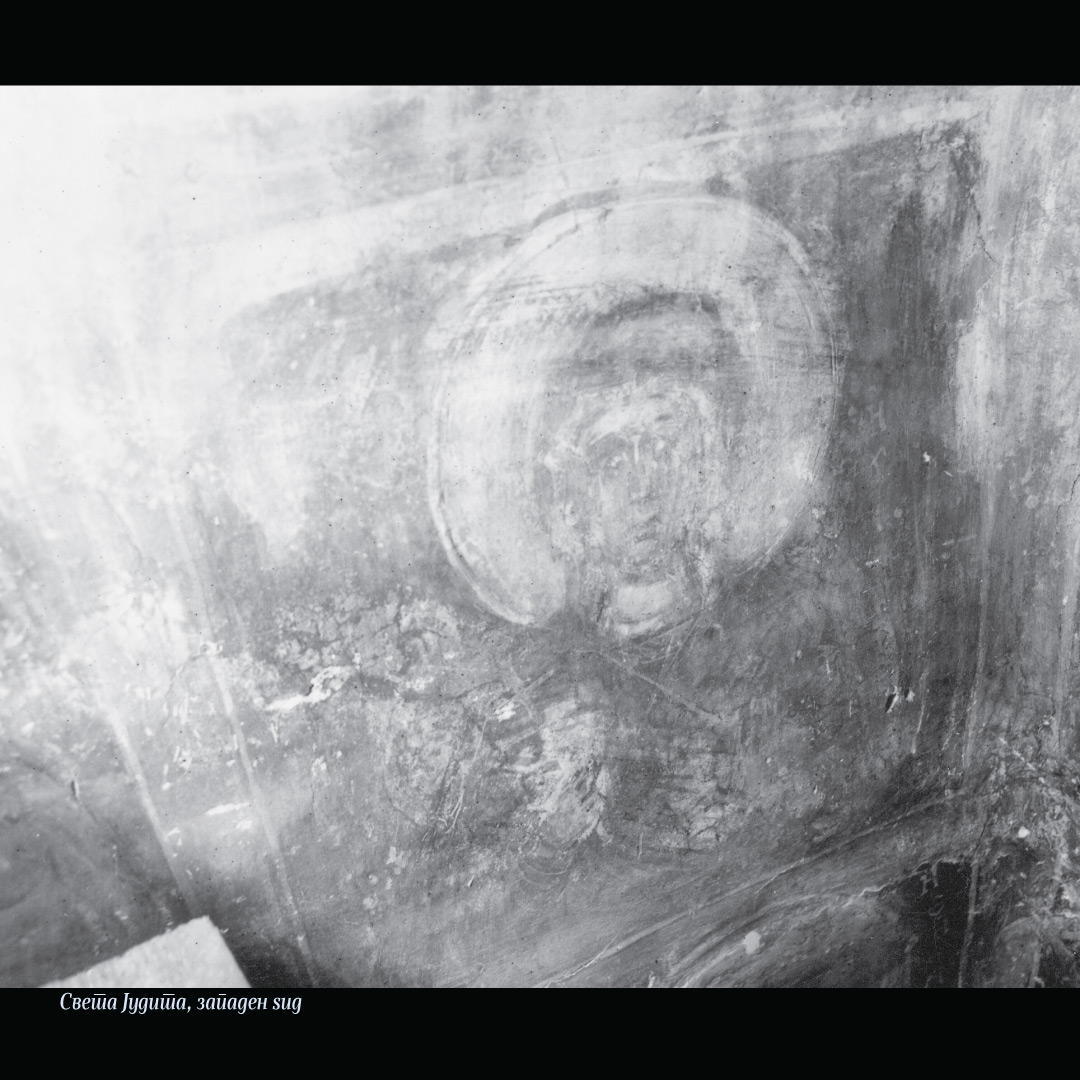
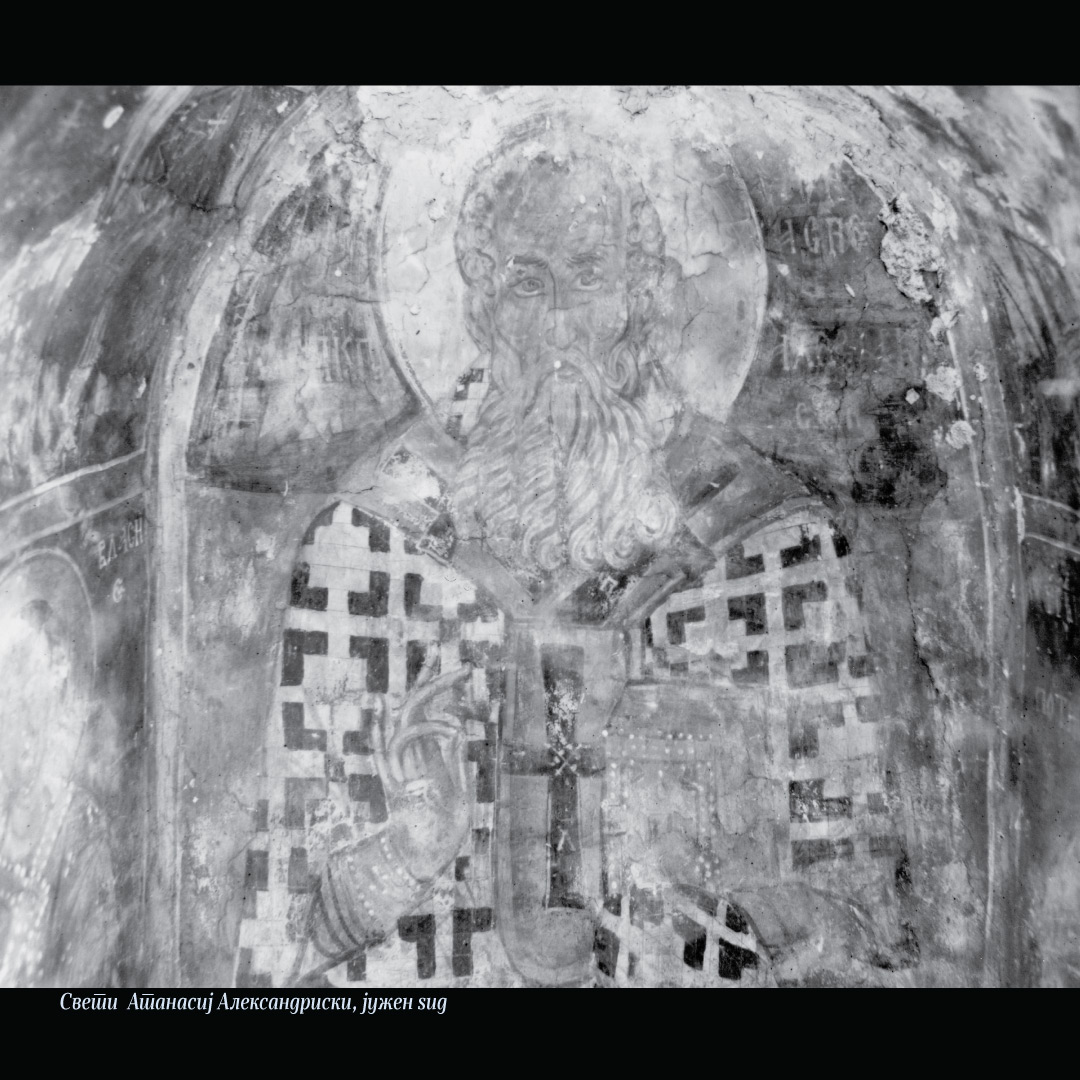
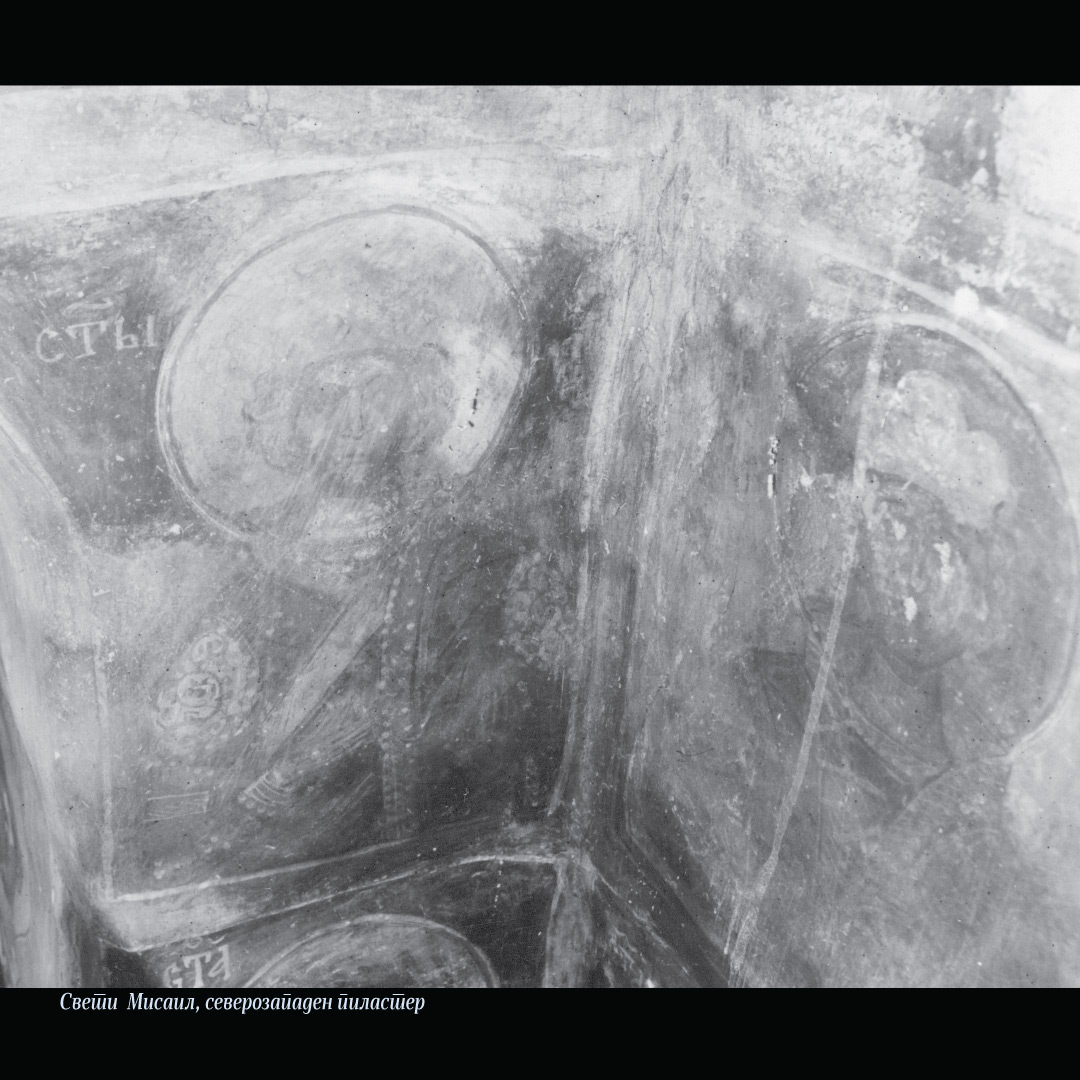
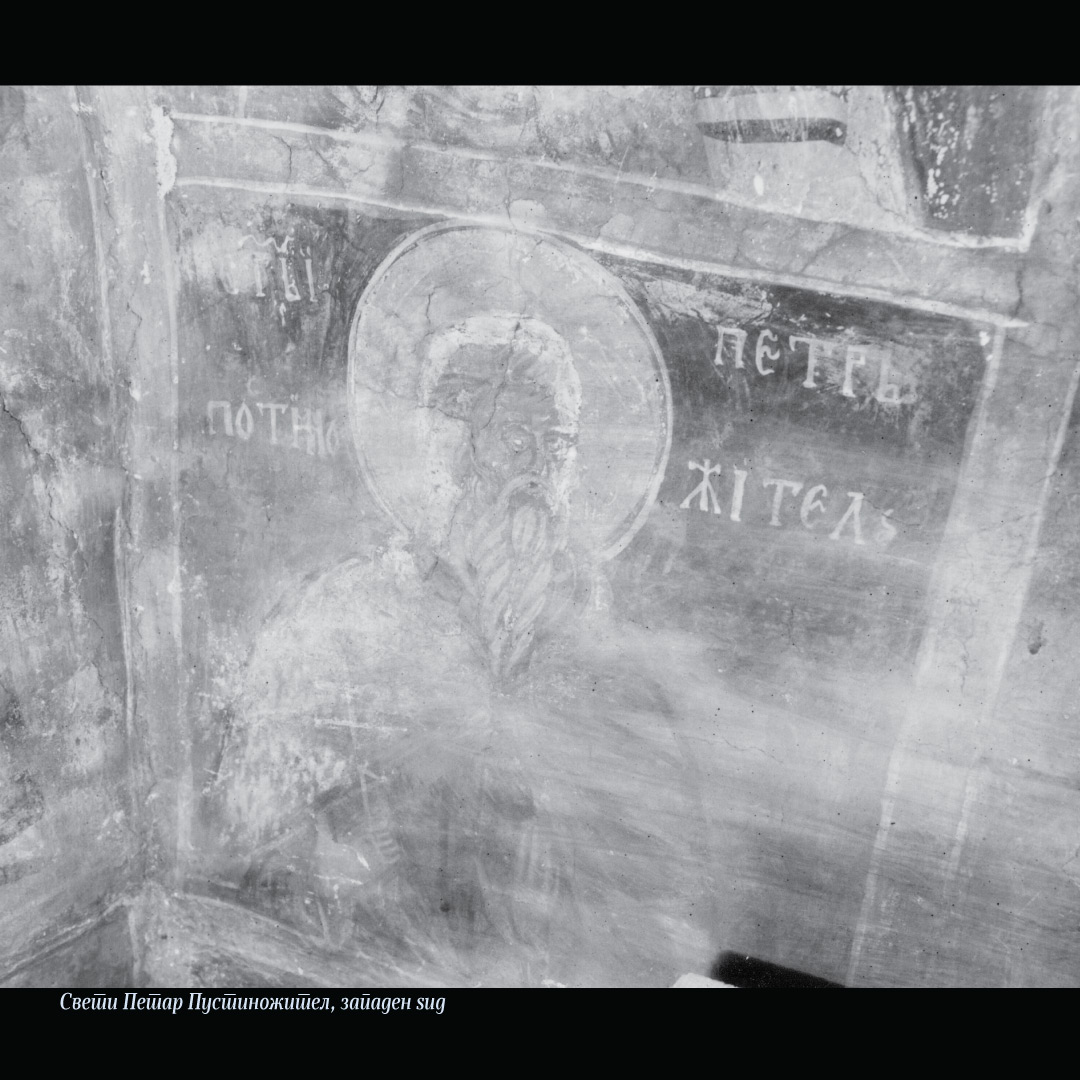
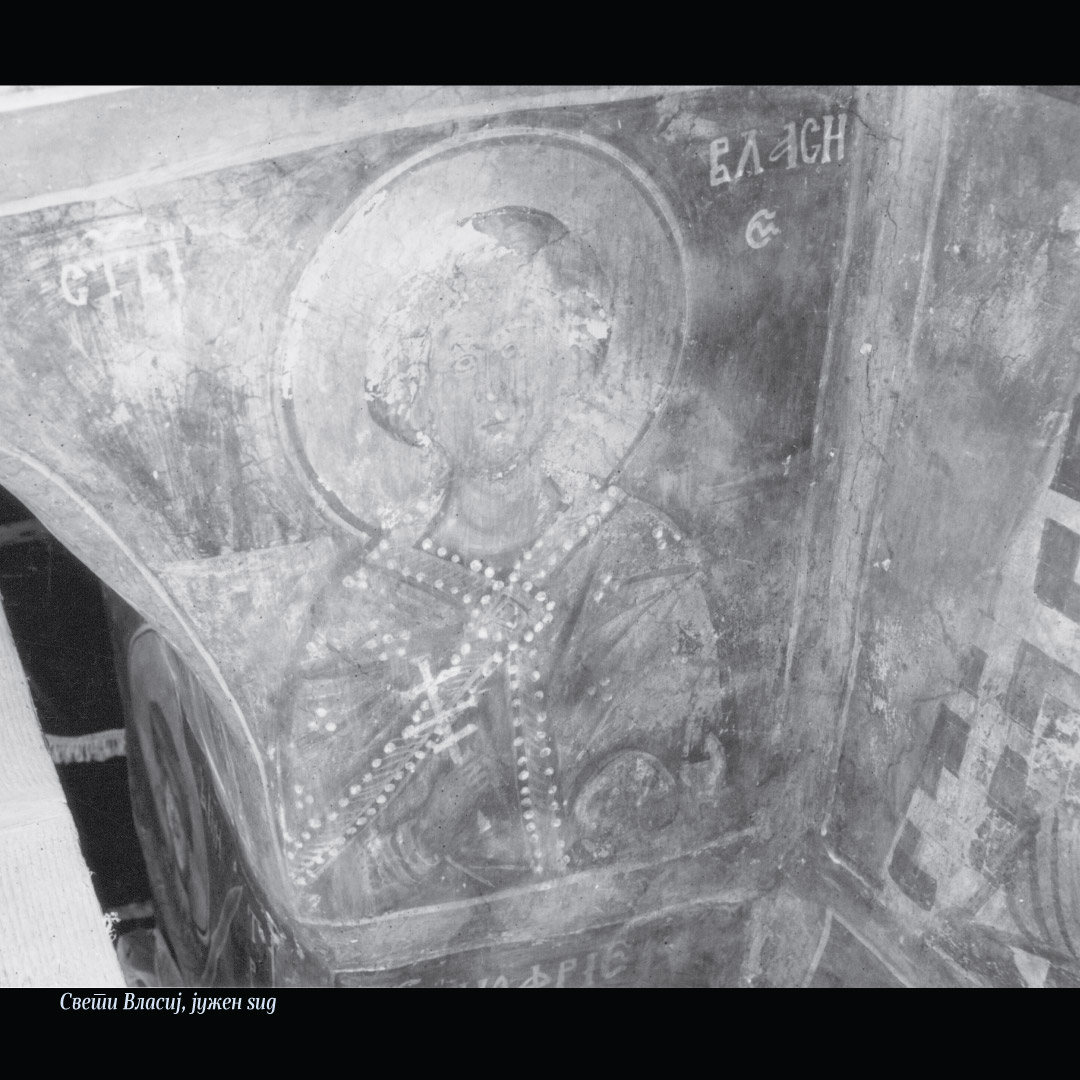
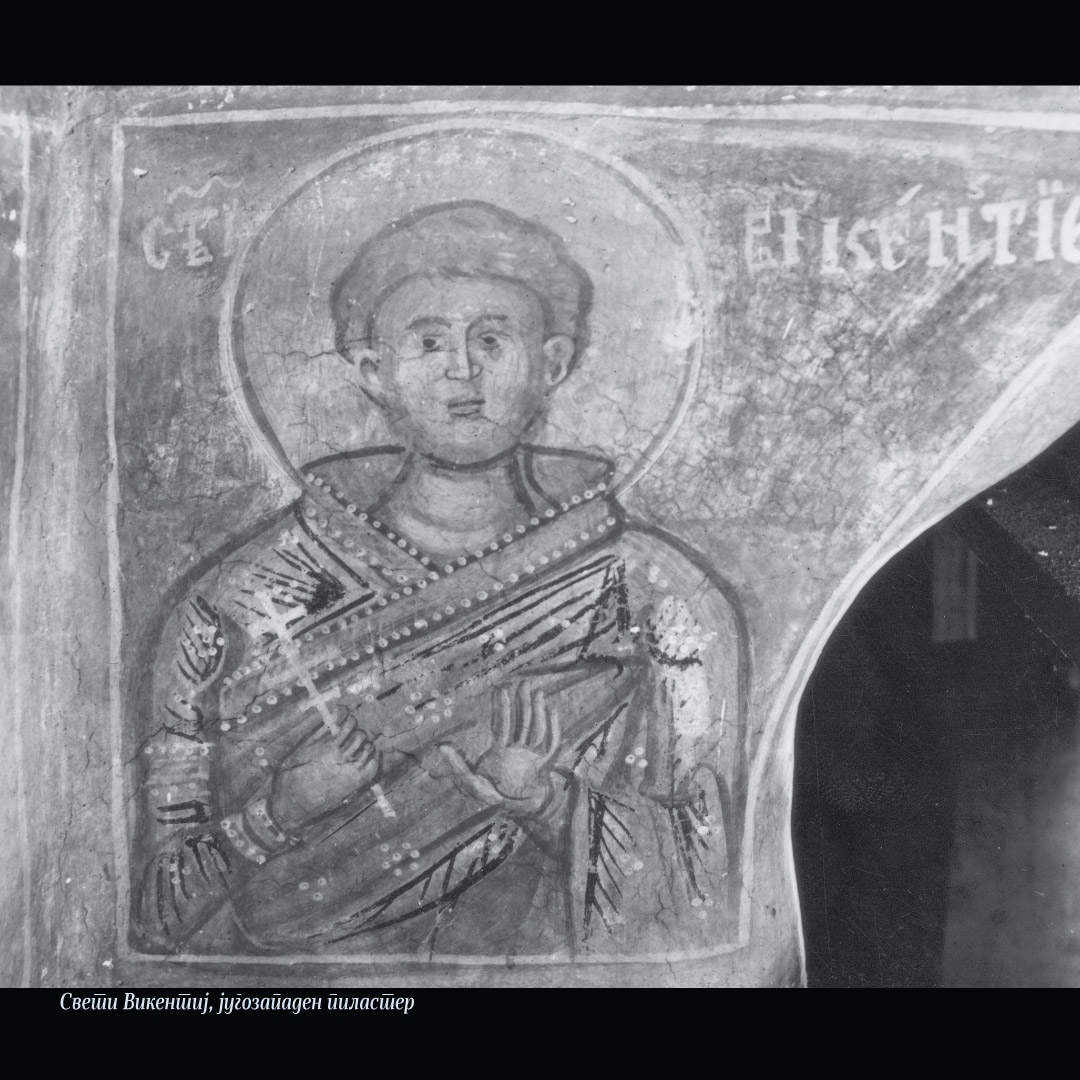
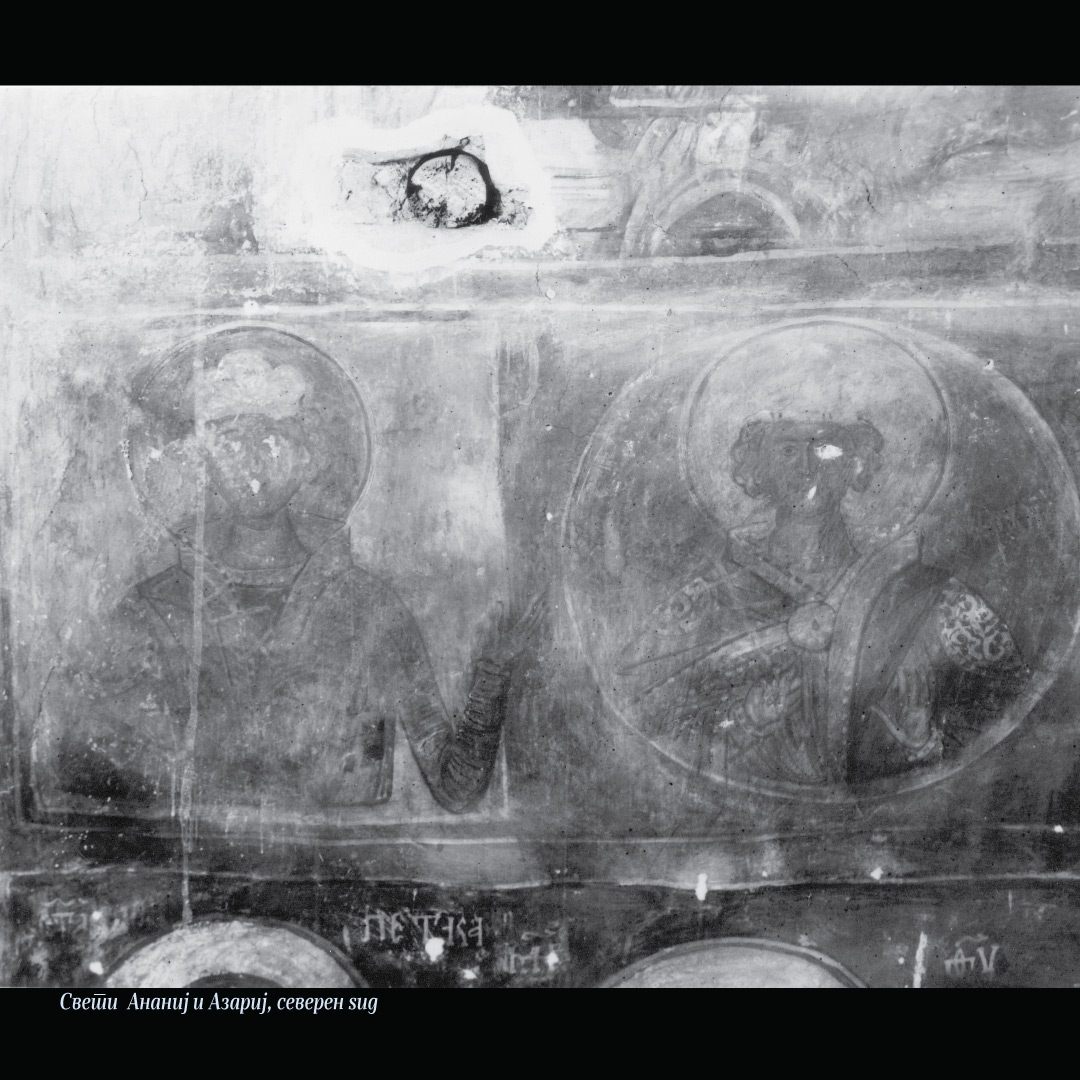
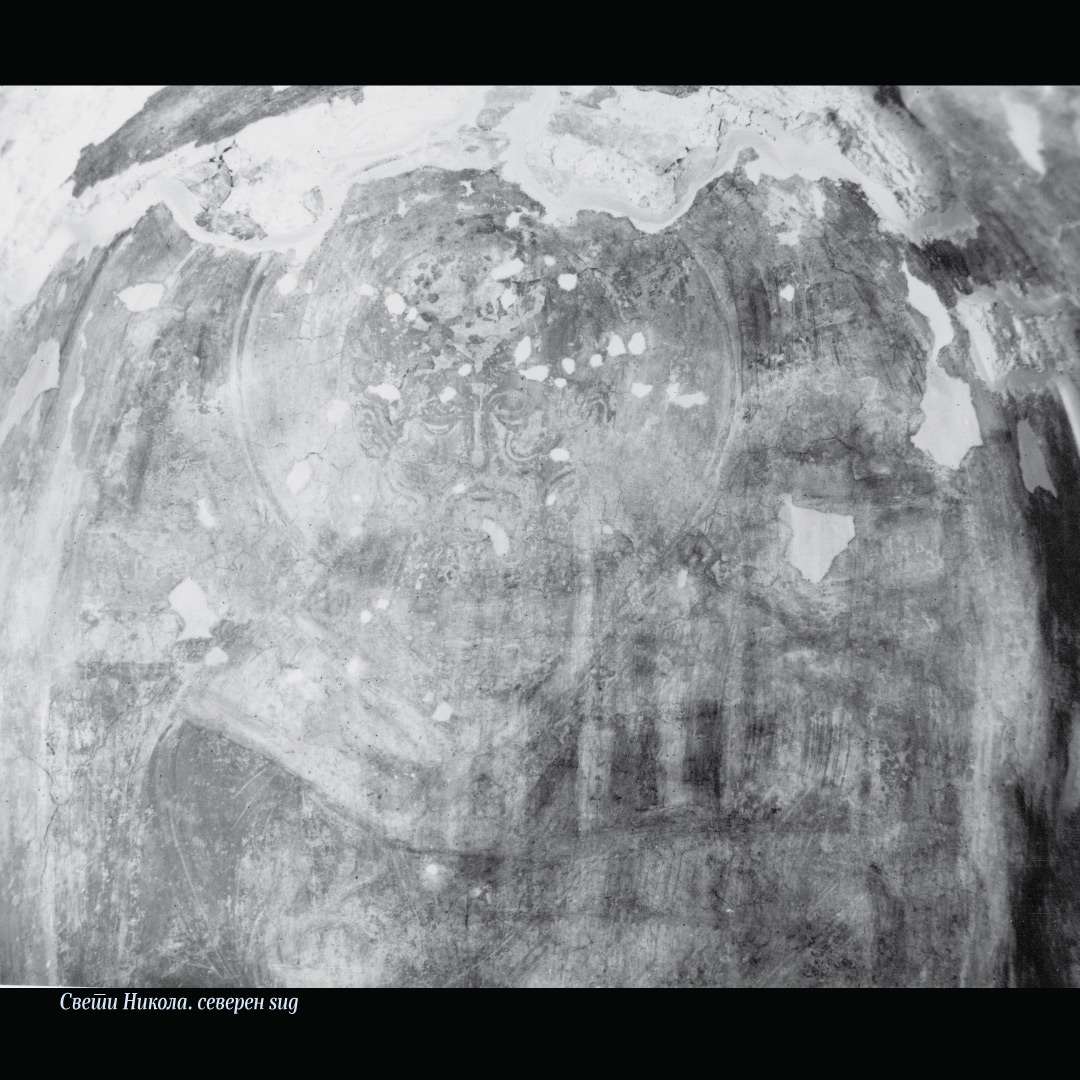
From-the-waist-up portraits of the saints
Between the second and the first zone is the frieze / strip, with the presentation of saints from-the-waist-up. In this zone, on the south wall, from east to west are presented: St Stephen the New with the icon of the Virgin Mary with Christ in her hands, St Cosmas and St Damian, St. Panteleimon, the Holy martyrs Mina, Victor and Vicentius, then St Tryphon and St Vlasij.
From-the-waist-up portraits of the bishops are positioned in the western part of the church in a large format; in the northern niche is St. Nicholas and on the southern, St Athanasius of Alexandria. In the lowest parts of the leaning arches, are shown smaller portraits (from-the-waist-up) of the Virgin and Christ. On the north side they are blessing St Nicholas, while on the south side, St Sava (1169-1236) and Simeon Nemanja are placed protectively over the founders, which undoubtedly reveal the protective role that these saints had in the eyes of believers.
The choice of St Nicholas and St Athanasius, according to Gojko Subotic can be connected to the founders from the inscription above the door:
“By the will of the Father, the help of the Son and the interaction of the Holy Spirit (in) this world and the divine temple of the Holy Lady Virgin Mary Prisnodeva, came Milica, and she found the church exposed, and covered the church, and organised the fresco-painting, repaired the vestibule and bought a vineyard. Remember them oh Lord, your servants Toshinko and his son Nicholas and the reigning bishop Athanasius in the year 1497”.
On the western wall are St Peter Korishki, a hermit of the 13th century, St Christopher, St Zosima giving a holy communion to St Mary of Egypt (from 453 to 530 AD. – the only woman to whom is devoted one week of the Great Lent; she’s an example of repentance), and St Julita. On the north wall are: St Kirik, St Nedela, three holy Jewish boys Mishael, Azariah, and Hananiah, St Jacob the Persian, and St Anthony the Great (the father of monasticism).
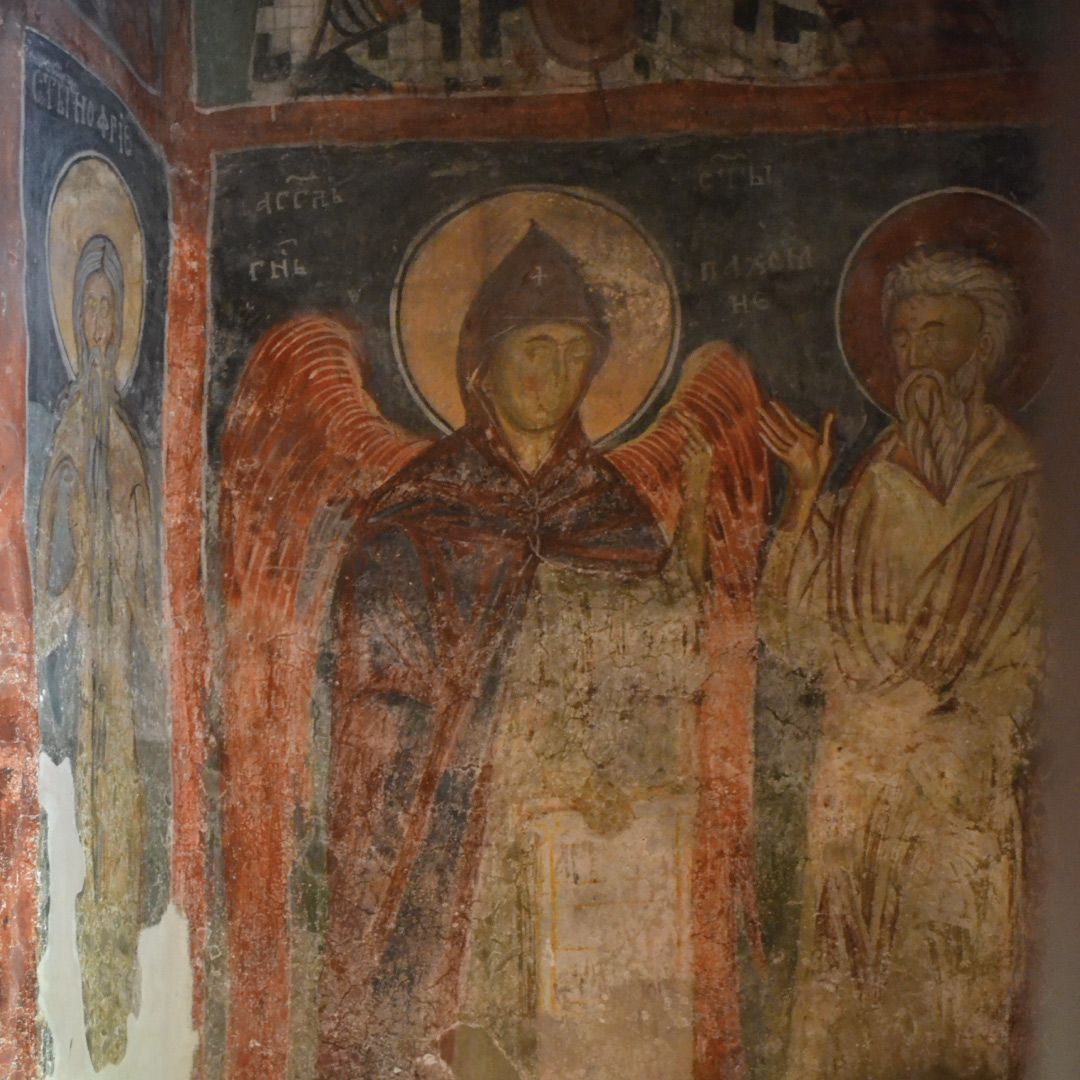
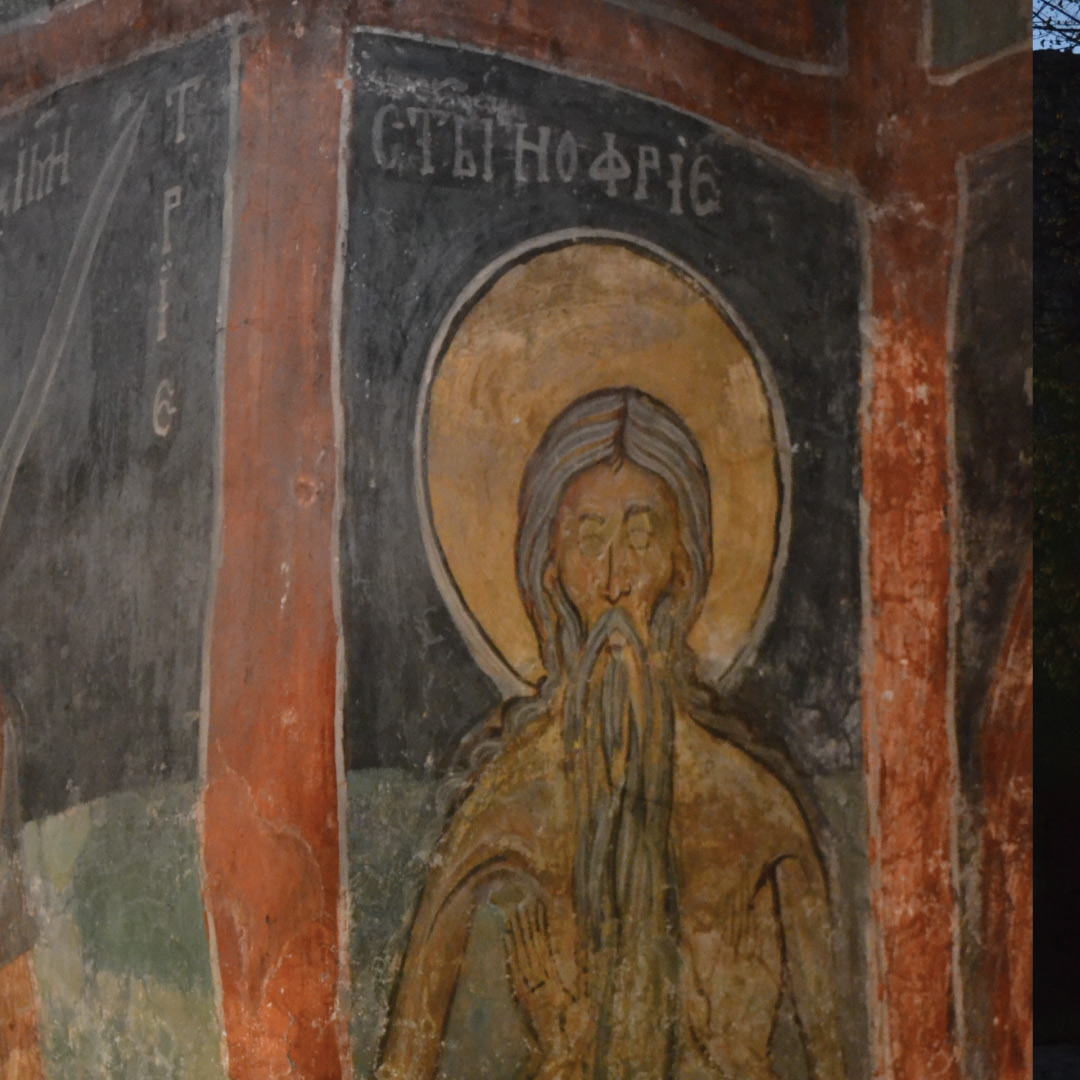
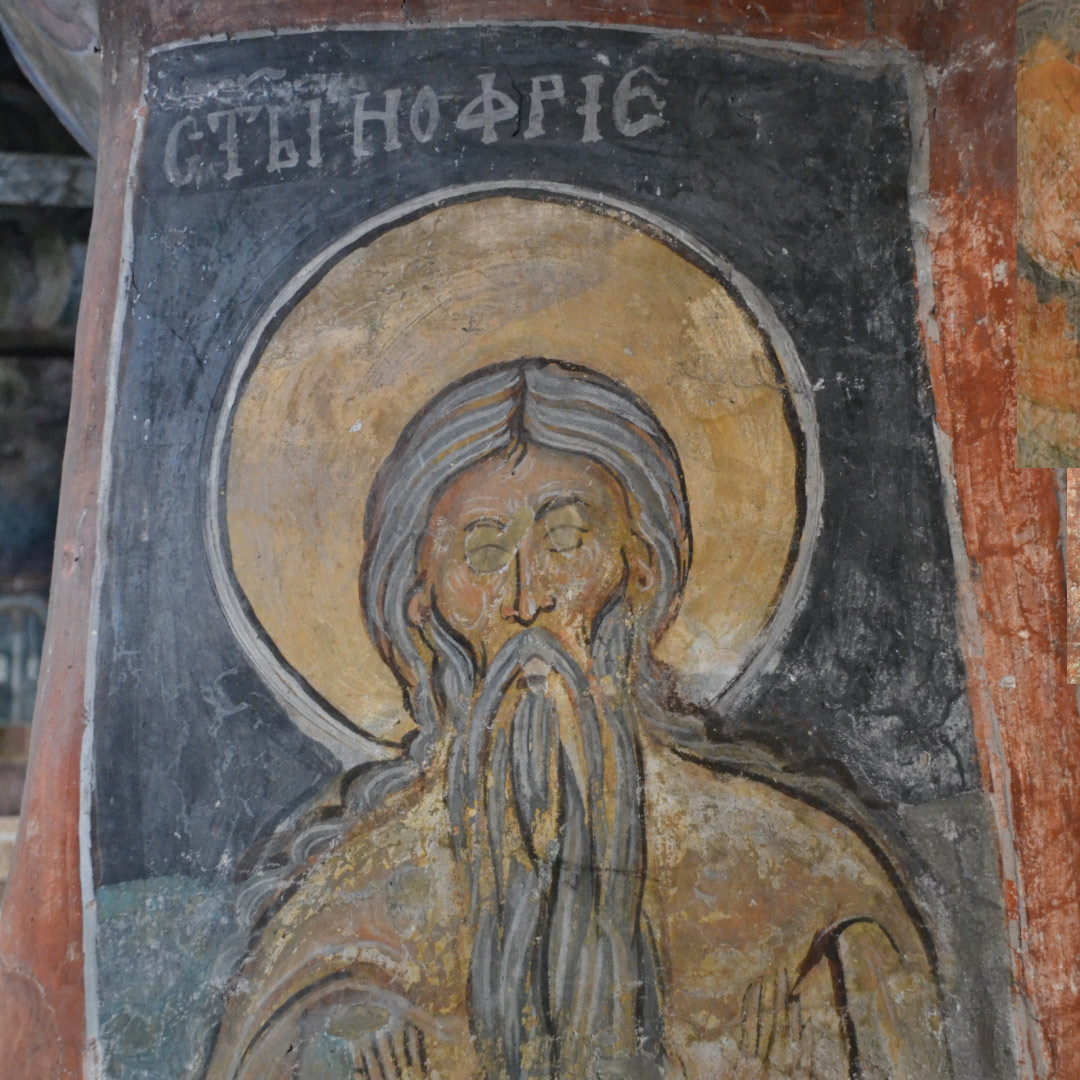
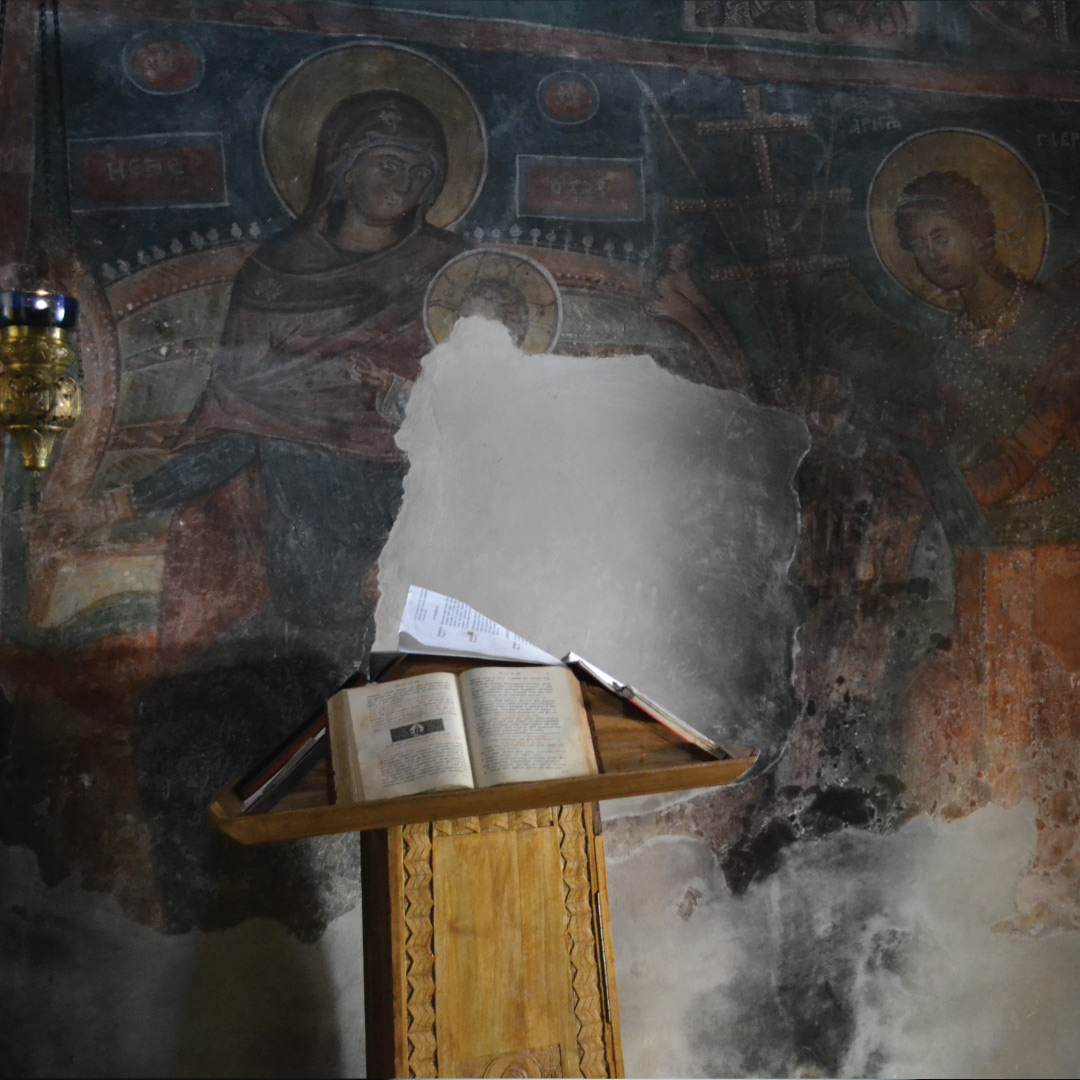
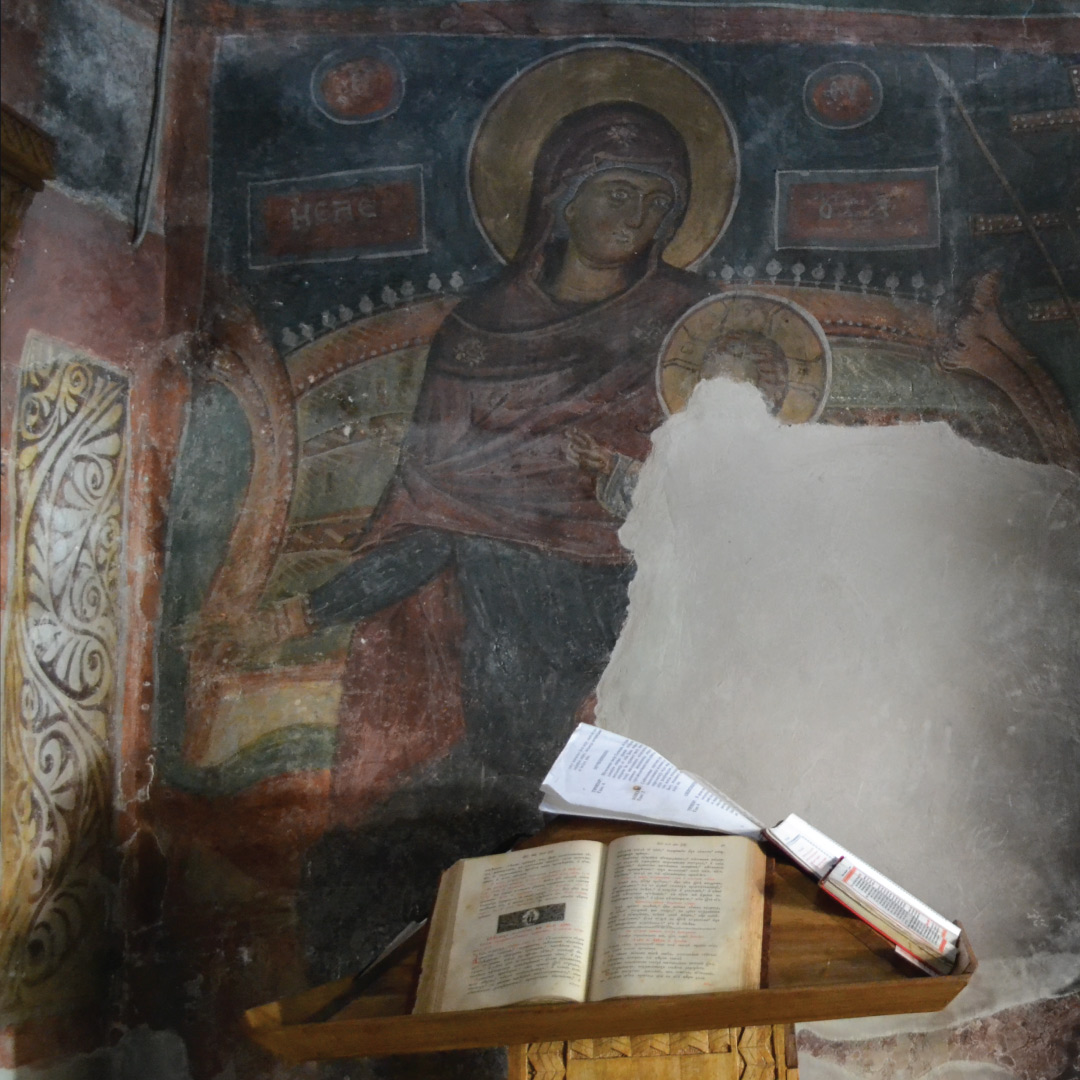
First zone saints
On the south wall, next to the ikonstasot is presented the Virgin Eleusa / the Merciful, the patron of the church, seated on a throne with the infant Christ in her hands (though His figure is damaged), while towards them approaches Archangel Gabriel with instruments of torture. She’s signed as Eleusa (the merciful). The following frescoes then follow: St Mark Tracheski (270-400) – a hermit, on the front of the pilaster are illustrated St Demetrius, St Onuphrius Great – a hermit, and the angel of God, dressed in monastic schema, as it gives a written constitution and rules of the ascetic monastic life of St Pachomius (272-346).
On the west wall, south of the door, are painted the frescoes of the donors Nikola and Milica.
The fact that Toshinko wasn’t painted besides his wife and son can be explained only by the possibility that at the time he was probably already deceased. The remarks next to their faces are written in a form of a short prayer, in a way to express a different attitude towards the restoration of the temple. Next to Milica is written: “Receive, O Lord the pleading of your servant Milice”, and next to Nikola only: “Commemorate O Lord,your servant Nikoly”
The figures of saints continue with the holy Constantine and Elena, north of the door. The north wall shows St Marina killing the demon, St Athanasius of Athos – the founder of the first Lavra (diocese) on Mount Athos in the year 960, and the hermit St Paul of Thebes. The front of the pilaster shows St George, then, St Barbara, St Paraskevi (Petka), and the Deisis where Christ is represented as King of kings.
The western facade – The fresco presented in the tympanum over the entrance, is the image of Mother Mary with Jesus in her lap, and the neighboring areas are surrounded by the images of prophets.
Along the highest part of the south side can be read the name of Gideon. It seems that Mother Mary had the epithet Troeruchica (Three-hand). “If it’s confirmed that the Mother Mary, truly presents the mentioned iconographic type – otherwise very rare – it is unusual for upon the wall next to the iconostasis to be painted Mother Mary signed as Eleusa/(the merciful), and above the entrance Troeruchica (Three-hand)”. (Gojko Subotic).
Conclusion
The frescoes in the church of the monastery Matka, as an artistic whole, belong to the Ohrid School of Fine Art in the 60’s of the 15th century. Related traits – from pure technical solutions, to the iconographic schemes, to the certain stylistic qualities – establish a visible link with the old center. The existing differences, however, between Matka and the classical monuments of the Ohrid region, despite the the time difference they were painted in, are not irrelevant and the fact that the frescoes in the church of Mother Mary are located in an area of a completely different kind. In the art tradition from Ohrid (both architectural and fresco-art), we are not familiar with any compact cruciform church-type, that in the 15th century was fresco-painted, and whose plan would serve as a parallel to Matka. The protruding surfaces of the interior, relatively small and complicated, created entirely different conditions for fresco-painting, and even influenced the choice of compositions and their placement.
The choice of the individual characters and the entire cycles, reliably indicate their origin from Ohrid’s art tradition. Even when they are completely formal, some individual features clearly speak of the work of particular centers: the images of saints presented in from-the-waist-up portraits, positioned in a row, in circular and rectangular fields, can be encountered regularly in the churches of Ohrid and its surroundings
More than anything, the typological and stylistic peculiarities of the frescoes of Matka indicate to their origin from Ohrid, especially one rare detail in the style of painting, taken from the creative wealth of the older work from Ohrid. On most of the saints, the shadows on their faces (or the shadows themselves) are coloured red, and the highlighted parts are shaded green.
For the frescos in the church the Dormition of the Most Holy Mother of God in Matka, Gojko Subotic in his work says: “The presence of many monks and hermits, if compared to other information, confirms that even since then this temple belonged to the monastery. The village churches, even when they had a wider range of characters, in principle, did not contain a great number of monks-hermits.”

